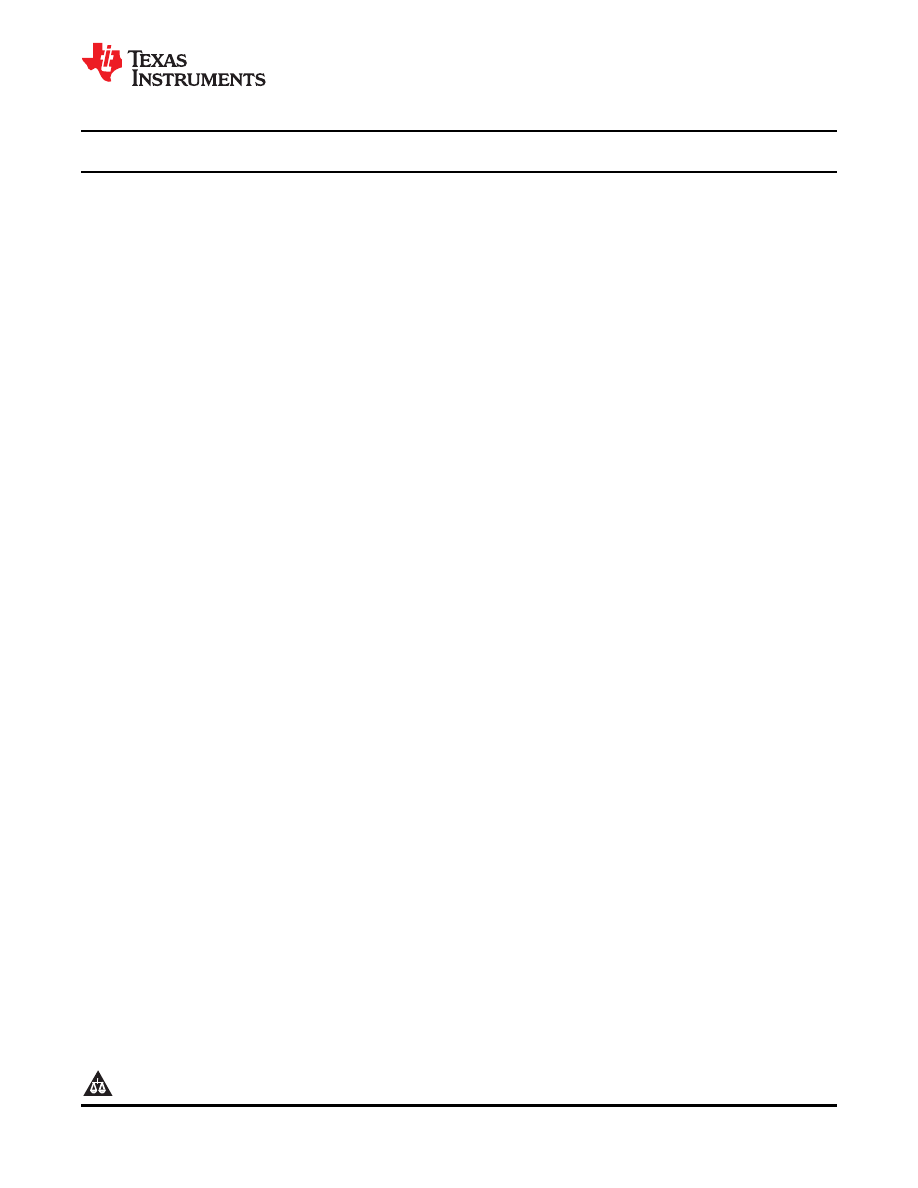
MSP430G2x53
MSP430G2x13
SLAS735F – APRIL 2011 – REVISED MAY 2012
MIXED SIGNAL MICROCONTROLLER
1
FEATURES
•
Low Supply-Voltage Range: 1.8 V to 3.6 V
•
Universal Serial Communication Interface
(USCI)
•
Ultra-Low Power Consumption
–
Enhanced UART Supporting Auto Baudrate
–
Active Mode: 230 µA at 1 MHz, 2.2 V
Detection (LIN)
–
Standby Mode: 0.5 µA
–
IrDA Encoder and Decoder
–
Off Mode (RAM Retention): 0.1 µA
–
Synchronous SPI
•
Five Power-Saving Modes
–
I
2
C™
•
Ultra-Fast Wake-Up From Standby Mode in
•
On-Chip Comparator for Analog Signal
Less Than 1 µs
Compare Function or Slope Analog-to-Digital
•
16-Bit RISC Architecture, 62.5-ns Instruction
(A/D) Conversion
Cycle Time
•
10-Bit 200-ksps Analog-to-Digital (A/D)
•
Basic Clock Module Configurations
Converter With Internal Reference, Sample-
–
Internal Frequencies up to 16 MHz With
and-Hold, and Autoscan (See
)
Four Calibrated Frequency
•
Brownout Detector
–
Internal Very-Low-Power Low-Frequency
•
Serial Onboard Programming,
(LF) Oscillator
No External Programming Voltage Needed,
–
32-kHz Crystal
Programmable Code Protection by Security
–
External Digital Clock Source
Fuse
•
Two 16-Bit Timer_A With Three
•
On-Chip Emulation Logic With Spy-Bi-Wire
Capture/Compare Registers
Interface
•
Up to 24 Touch-Sense-Enabled I/O Pins
•
Family Members are Summarized in
•
Package Options
–
TSSOP: 20 Pin, 28 Pin
–
PDIP: 20 Pin
–
QFN: 32 Pin
•
For Complete Module Descriptions, See the
MSP430x2xx Family User’s Guide (
DESCRIPTION
The Texas Instruments MSP430 family of ultra-low-power microcontrollers consists of several devices featuring
different sets of peripherals targeted for various applications. The architecture, combined with five low-power
modes, is optimized to achieve extended battery life in portable measurement applications. The device features a
powerful 16-bit RISC CPU, 16-bit registers, and constant generators that contribute to maximum code efficiency.
The digitally controlled oscillator (DCO) allows wake-up from low-power modes to active mode in less than 1 µs.
The MSP430G2x13 and MSP430G2x53 series are ultra-low-power mixed signal microcontrollers with built-in 16-
bit timers, up to 24 I/O touch-sense-enabled pins, a versatile analog comparator, and built-in communication
capability using the universal serial communication interface. In addition the MSP430G2x53 family members
have a 10-bit analog-to-digital (A/D) converter. For configuration details see
Typical applications include low-cost sensor systems that capture analog signals, convert them to digital values,
and then process the data for display or for transmission to a host system.
1
Please be aware that an important notice concerning availability, standard warranty, and use in critical applications of
Texas Instruments semiconductor products and disclaimers thereto appears at the end of this data sheet.
PRODUCTION DATA information is current as of publication date.
Copyright © 2011–2012, Texas Instruments Incorporated
Products conform to specifications per the terms of the Texas
Instruments standard warranty. Production processing does not
necessarily include testing of all parameters.

MSP430G2x53
MSP430G2x13
SLAS735F – APRIL 2011 – REVISED MAY 2012
Table 1. Available Options
(1) (2)
Flash
RAM
COMP_A+
ADC10
USCI_A0,
Package
Device
BSL
EEM
Timer_A
Clock
I/O
(KB)
(B)
Channel
Channel
USCI_B0
Type
MSP430G2553IRHB32
24
32-QFN
LF,
MSP430G2553IPW28
24
28-TSSOP
1
1
16
512
2x TA3
8
8
1
DCO,
MSP430G2553IPW20
16
20-TSSOP
VLO
MSP430G2553IN20
16
20-PDIP
MSP430G2453IRHB32
24
32-QFN
LF,
MSP430G2453IPW28
24
28-TSSOP
1
1
8
512
2x TA3
8
8
1
DCO,
MSP430G2453IPW20
16
20-TSSOP
VLO
MSP430G2453IN20
16
20-PDIP
MSP430G2353IRHB32
24
32-QFN
LF,
MSP430G2353IPW28
24
28-TSSOP
1
1
4
256
2x TA3
8
8
1
DCO,
MSP430G2353IPW20
16
20-TSSOP
VLO
MSP430G2353IN20
16
20-PDIP
MSP430G2253IRHB32
24
32-QFN
LF,
MSP430G2253IPW28
24
28-TSSOP
1
1
2
256
2x TA3
8
8
1
DCO,
MSP430G2253IPW20
16
20-TSSOP
VLO
MSP430G2253IN20
16
20-PDIP
MSP430G2153IRHB32
24
32-QFN
LF,
MSP430G2153IPW28
24
28-TSSOP
1
1
1
256
2x TA3
8
8
1
DCO,
MSP430G2153IPW20
16
20-TSSOP
VLO
MSP430G2153IN20
16
20-PDIP
MSP430G2513IRHB32
24
32-QFN
LF,
MSP430G2513IPW28
24
28-TSSOP
1
1
16
512
2x TA3
8
-
1
DCO,
MSP430G2513IPW20
16
20-TSSOP
VLO
MSP430G2513IN20
16
20-PDIP
MSP430G2413IRHB32
24
32-QFN
LF,
MSP430G2413IPW28
24
28-TSSOP
1
1
8
512
2x TA3
8
-
1
DCO,
MSP430G2413IPW20
16
20-TSSOP
VLO
MSP430G2413IN20
16
20-PDIP
MSP430G2313IRHB32
24
32-QFN
LF,
MSP430G2313IPW28
24
28-TSSOP
1
1
4
256
2x TA3
8
-
1
DCO,
MSP430G2313IPW20
16
20-TSSOP
VLO
MSP430G2313IN20
16
20-PDIP
MSP430G2213IRHB32
24
32-QFN
LF,
MSP430G2213IPW28
24
28-TSSOP
1
1
2
256
2x TA3
8
-
1
DCO,
MSP430G2213IPW20
16
20-TSSOP
VLO
MSP430G2213IN20
16
20-PDIP
MSP430G2113IRHB32
24
32-QFN
LF,
MSP430G2113IPW28
24
28-TSSOP
1
1
1
256
2x TA3
8
-
1
DCO,
MSP430G2113IPW20
16
20-TSSOP
VLO
MSP430G2113IN20
16
20-PDIP
(1)
For the most current package and ordering information, see the Package Option Addendum at the end of this document, or see the TI
web site at
(2)
Package drawings, thermal data, and symbolization are available at
2
Copyright © 2011–2012, Texas Instruments Incorporated
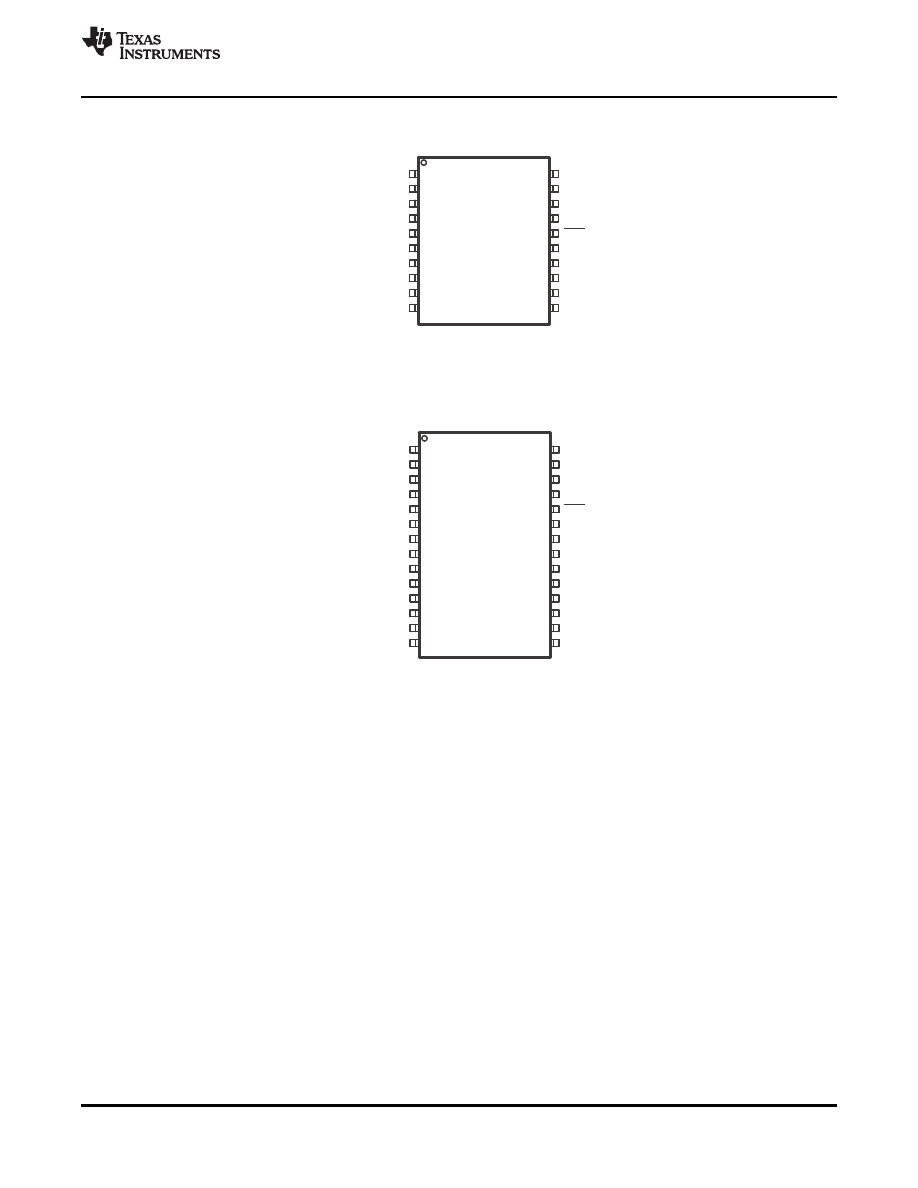
PW28
(TOP VIEW)
1
DVCC
2
P1.0/TA0CLK/ACLK/A0/CA0
3
4
5
P1.3/ADC10CLK/CAOUT/VREF-/VEREF-/A3/CA3
6
7
8
P3.0/TA0.2
9
P3.1/TA1.0
10
P2.0/TA1.0
19
P3.5/TA0.1
20
P3.6/TA0.2
21
P3.7/TA1CLK/CAOUT
22
23
24
RST/NMI/SBWTDIO
25
TEST/SBWTCK
26
XOUT/P2.7
27
XIN/P2.6/TA0.1
28
DVSS
P1.6/TA0.1/
CA6/TDI/TCLK
UC
B0SOMI/UCB0SCL/A6/
P1.7/CAOUT
/A7/CA7/TDO/TDI
/
UCB0SIMO/UCB0SDA
P1.1/TA0.0/
A1/CA1
/
UCA0RXD/UCA0SOMI
P1.2/TA0.1/
A2/CA2
/
UCA0TXD/PUCA0SIMO
P1.4/SMCLK/
CA4/TCK
/VREF+/VEREF+/A4/
UCB0STE/UCA0CLK
P1.5/TA0.0/
A5/CA5/TMS
/
UCB0CLK/UCA0STE
11
12
P2.2/TA1.1
13
P3.2/TA1.1
14
P3.3/TA1.2
15
P3.4/TA0.0
16
P2.3/TA1.0
17
P2.4/TA1.2
18
P2.5/TA1.2
P2.1/TA1.1
N20
PW20
(TOP VIEW)
1
DVCC
2
P1.0/TA0CLK/ACLK/A0/CA0
3
4
5
P1.3/ADC10CLK/CAOUT/VREF-/VEREF-/A3/CA3
6
7
8
P2.0/TA1.0
9
P2.1/TA1.1
10
P2.2/TA1.1
11
P2.3/TA1.0
12
P2.4/TA1.2
13
P2.5/TA1.2
14
15
16
RST/NMI/SBWTDIO
17
TEST/SBWTCK
18
XOUT/P2.7
19
XIN/P2.6/TA0.1
20
DVSS
P1.6/TA0.1/
CA6/TDI/TCLK
UC
B0SOMI/UCB0SCL/A6/
P1.7/CAOUT
/A7/CA7/TDO/TDI
/
UCB0SIMO/UCB0SDA
P1.1/TA0.0/
A1/CA1
/
UCA0RXD/UCA0SOMI
P1.2/TA0.1/
A2/CA2
/
UCA0TXD/PUCA0SIMO
P1.4/SMCLK/
CA4/TCK
/VREF+/VEREF+/A4/
UCB0STE/UCA0CLK
P1.5/TA0.0/
A5/CA5/TMS
/
UCB0CLK/UCA0STE
MSP430G2x53
MSP430G2x13
SLAS735F – APRIL 2011 – REVISED MAY 2012
Device Pinout, MSP430G2x13 and MSP430G2x53, 20-Pin Devices, TSSOP and PDIP
NOTE: ADC10 is available on MSP430G2x53 devices only.
NOTE: The pulldown resistors of port P3 should be enabled by setting P3REN.x = 1.
Device Pinout, MSP430G2x13 and MSP430G2x53, 28-Pin Devices, TSSOP
NOTE: ADC10 is available on MSP430G2x53 devices only.
Copyright © 2011–2012, Texas Instruments Incorporated
3
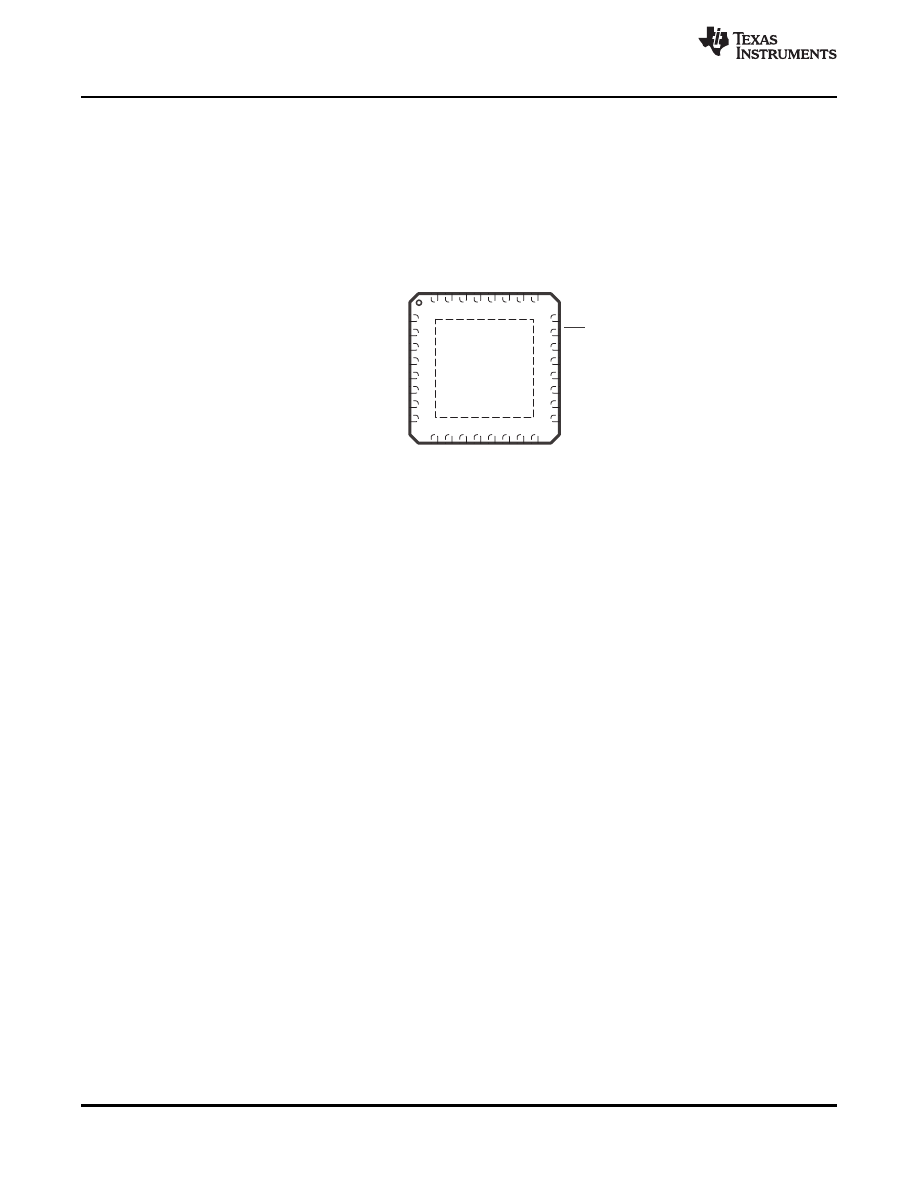
RHB32
(TOP VIEW)
1
2
3
4
5
6
P2.0/T
A1.0
7
P2.1/T
A1.1
8
NC
9
P2.2/T
A1.1
10
P3.0/TA0.2
11
P3.1/TA1.0
12
P3.2/T
A1.1
13
P3.3/T
A1.2
14
P3.4/T
A0.0
15
P3.5/TA0.1
16
P2.3/T
A1.0
17
P2.4/T
A1.2
18
P2.5/TA1.2
19
20
P3.6/TA0.2
21
P3.7/TA1CLK/CAOUT
22
23
RST/NMI/SBWTDIO
24
TEST/SBWTCK
25
XOUT/P2.7
26
XIN/P2.6/T
A0.1
27
A
VSS
28
DVSS
29
A
VCC
30
DVCC
31
P1.0/T
A0CLK/ACLK/A0/CA0
32
NC
P1.3/ADC10CLK/CAOUT/VREF-/VEREF-/A3/CA3
P1.1/TA0.0/
A1/CA1
/
UCA0RXD/UCA0SOMI
P1.2/TA0.1/
A2/CA2
/
UCA0TXD/UCA0SIMO
P1.4/SMCLK/
CA4/TCK
/VREF+/VEREF+/A4/
UCB0STE/UCA0CLK
P1.5/TA0.0/
A5/CA5/TMS
/
UCB0CLK/UCA0STE
P1.6/TA0.1/
CA6/TDI/TCLK
UC
B0SOMI/UCB0SCL/A6/
P1.7/CAOUT
/CA7/TDO/TDI
/
UCB0SIMO/UCB0SDA/A7
MSP430G2x53
MSP430G2x13
SLAS735F – APRIL 2011 – REVISED MAY 2012
Device Pinout, MSP430G2x13 and MSP430G2x53, 32-Pin Devices, QFN
NOTE: ADC10 is available on MSP430G2x53 devices only.
4
Copyright © 2011–2012, Texas Instruments Incorporated
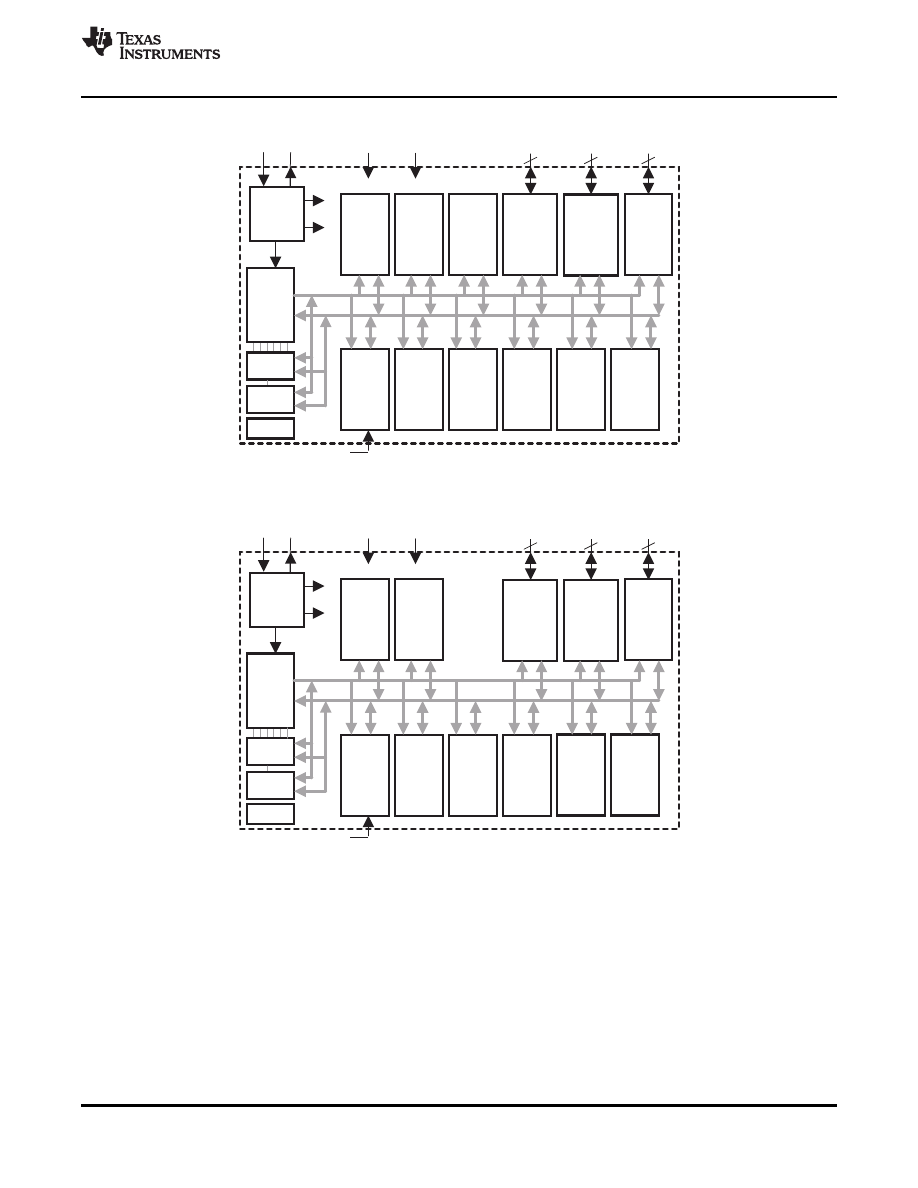
Clock
System
Brownout
Protection
RST/NMI
DVCC
DVSS
MCLK
Watchdog
WDT+
15-Bit
Timer0_A3
3 CC
Registers
16MHz
CPU
incl. 16
Registers
Emulation
2BP
JTAG
Interface
SMCLK
ACLK
Port P1
8 I/O
Interrupt
capability
pullup/down
resistors
P1.x
8
P2.x
Port P2
8 I/O
Interrupt
capability
pullup/down
resistors
Spy-Bi-
Wire
Comp_A+
8 Channels
Timer1_A3
3 CC
Registers
XIN XOUT
Port P3
8 I/O
pullup/
pulldown
resistors
P3.x
8
8
RAM
512B
256B
Flash
16KB
8KB
4KB
2KB
USCI A0
UART/
LIN, IrDA,
SPI
USCI B0
SPI, I2C
MDB
MAB
Clock
System
Brownout
Protection
RST/NMI
DVCC
DVSS
MCLK
Watchdog
WDT+
15-Bit
Timer0_A3
3 CC
Registers
16MHz
CPU
incl. 16
Registers
Emulation
2BP
JTAG
Interface
SMCLK
ACLK
MDB
MAB
Port P1
8 I/O
Interrupt
capability
pullup/down
resistors
P1.x
8
P2.x
Port P2
8 I/O
Interrupt
capability
pullup/down
resistors
Spy-Bi-
Wire
Comp_A+
8 Channels
Timer1_A3
3 CC
Registers
XIN XOUT
Port P3
8 I/O
pullup/
pulldown
resistors
P3.x
8
8
RAM
512B
256B
Flash
16KB
8KB
4KB
2KB
USCI A0
UART/
LIN, IrDA,
SPI
USCI B0
SPI, I2C
ADC
10-Bit
8 Ch.
Autoscan
1 ch DMA
MSP430G2x53
MSP430G2x13
SLAS735F – APRIL 2011 – REVISED MAY 2012
Functional Block Diagram, MSP430G2x53
NOTE: Port P3 is available on 28-pin and 32-pin devices only.
Functional Block Diagram, MSP430G2x13
NOTE: Port P3 is available on 28-pin and 32-pin devices only.
Copyright © 2011–2012, Texas Instruments Incorporated
5

MSP430G2x53
MSP430G2x13
SLAS735F – APRIL 2011 – REVISED MAY 2012
Table 2. Terminal Functions
TERMINAL
NO.
I/O
DESCRIPTION
NAME
PW20,
PW28
RHB32
N20
P1.0/
General-purpose digital I/O pin
TA0CLK/
Timer0_A, clock signal TACLK input
ACLK/
2
2
31
I/O
ACLK signal output
A0
ADC10 analog input A0
(1)
CA0
Comparator_A+, CA0 input
P1.1/
General-purpose digital I/O pin
TA0.0/
Timer0_A, capture: CCI0A input, compare: Out0 output / BSL transmit
UCA0RXD/
USCI_A0 receive data input in UART mode,
3
3
1
I/O
UCA0SOMI/
USCI_A0 slave data out/master in SPI mode
A1/
ADC10 analog input A1
(1)
CA1
Comparator_A+, CA1 input
P1.2/
General-purpose digital I/O pin
TA0.1/
Timer0_A, capture: CCI1A input, compare: Out1 output
UCA0TXD/
USCI_A0 transmit data output in UART mode,
4
4
2
I/O
UCA0SIMO/
USCI_A0 slave data in/master out in SPI mode,
A2/
ADC10 analog input A2
(1)
CA2
Comparator_A+, CA2 input
P1.3/
General-purpose digital I/O pin
ADC10CLK/
ADC10, conversion clock output
(1)
A3/
ADC10 analog input A3
(1)
5
5
3
I/O
VREF-/VEREF-/
ADC10 negative reference voltage
(1)
CA3/
Comparator_A+, CA3 input
CAOUT
Comparator_A+, output
P1.4/
General-purpose digital I/O pin
SMCLK/
SMCLK signal output
UCB0STE/
USCI_B0 slave transmit enable
UCA0CLK/
USCI_A0 clock input/output
6
6
4
I/O
A4/
ADC10 analog input A4
(1)
VREF+/VEREF+/
ADC10 positive reference voltage
(1)
CA4/
Comparator_A+, CA4 input
TCK
JTAG test clock, input terminal for device programming and test
P1.5/
General-purpose digital I/O pin
TA0.0/
Timer0_A, compare: Out0 output / BSL receive
UCB0CLK/
USCI_B0 clock input/output,
UCA0STE/
7
7
5
I/O
USCI_A0 slave transmit enable
A5/
ADC10 analog input A5
(1)
CA5/
Comparator_A+, CA5 input
TMS
JTAG test mode select, input terminal for device programming and test
(1)
MSP430G2x53 devices only
6
Copyright © 2011–2012, Texas Instruments Incorporated

MSP430G2x53
MSP430G2x13
SLAS735F – APRIL 2011 – REVISED MAY 2012
Table 2. Terminal Functions (continued)
TERMINAL
NO.
I/O
DESCRIPTION
NAME
PW20,
PW28
RHB32
N20
P1.6/
General-purpose digital I/O pin
TA0.1/
Timer0_A, compare: Out1 output
A6/
ADC10 analog input A6
(1)
CA6/
14
22
21
I/O
Comparator_A+, CA6 input
UCB0SOMI/
USCI_B0 slave out/master in SPI mode,
UCB0SCL/
USCI_B0 SCL I2C clock in I2C mode
TDI/TCLK
JTAG test data input or test clock input during programming and test
P1.7/
General-purpose digital I/O pin
A7/
ADC10 analog input A7
(1)
CA7/
Comparator_A+, CA7 input
CAOUT/
Comparator_A+, output
15
23
22
I/O
UCB0SIMO/
USCI_B0 slave in/master out in SPI mode
UCB0SDA/
USCI_B0 SDA I2C data in I2C mode
TDO/TDI
JTAG test data output terminal or test data input during programming and
test
(2)
P2.0/
General-purpose digital I/O pin
8
10
9
I/O
TA1.0
Timer1_A, capture: CCI0A input, compare: Out0 output
P2.1/
General-purpose digital I/O pin
9
11
10
I/O
TA1.1
Timer1_A, capture: CCI1A input, compare: Out1 output
P2.2/
General-purpose digital I/O pin
10
12
11
I/O
TA1.1
Timer1_A, capture: CCI1B input, compare: Out1 output
P2.3/
General-purpose digital I/O pin
11
16
15
I/O
TA1.0
Timer1_A, capture: CCI0B input, compare: Out0 output
P2.4/
General-purpose digital I/O pin
12
17
16
I/O
TA1.2
Timer1_A, capture: CCI2A input, compare: Out2 output
P2.5/
General-purpose digital I/O pin
13
18
17
I/O
TA1.2
Timer1_A, capture: CCI2B input, compare: Out2 output
XIN/
Input terminal of crystal oscillator
P2.6/
19
27
26
I/O
General-purpose digital I/O pin
TA0.1
Timer0_A, compare: Out1 output
XOUT/
Output terminal of crystal oscillator
(3)
18
26
25
I/O
P2.7
General-purpose digital I/O pin
P3.0/
General-purpose digital I/O pin
-
9
7
I/O
TA0.2
Timer0_A, capture: CCI2A input, compare: Out2 output
P3.1/
General-purpose digital I/O pin
-
8
6
I/O
TA1.0
Timer1_A, compare: Out0 output
P3.2/
General-purpose digital I/O pin
-
13
12
I/O
TA1.1
Timer1_A, compare: Out1 output
P3.3/
General-purpose digital I/O
-
14
13
I/O
TA1.2
Timer1_A, compare: Out2 output
P3.4/
General-purpose digital I/O
-
15
14
I/O
TA0.0
Timer0_A, compare: Out0 output
(2)
TDO or TDI is selected via JTAG instruction.
(3)
If XOUT/P2.7 is used as an input, excess current will flow until P2SEL.7 is cleared. This is due to the oscillator output driver connection
to this pad after reset.
Copyright © 2011–2012, Texas Instruments Incorporated
7
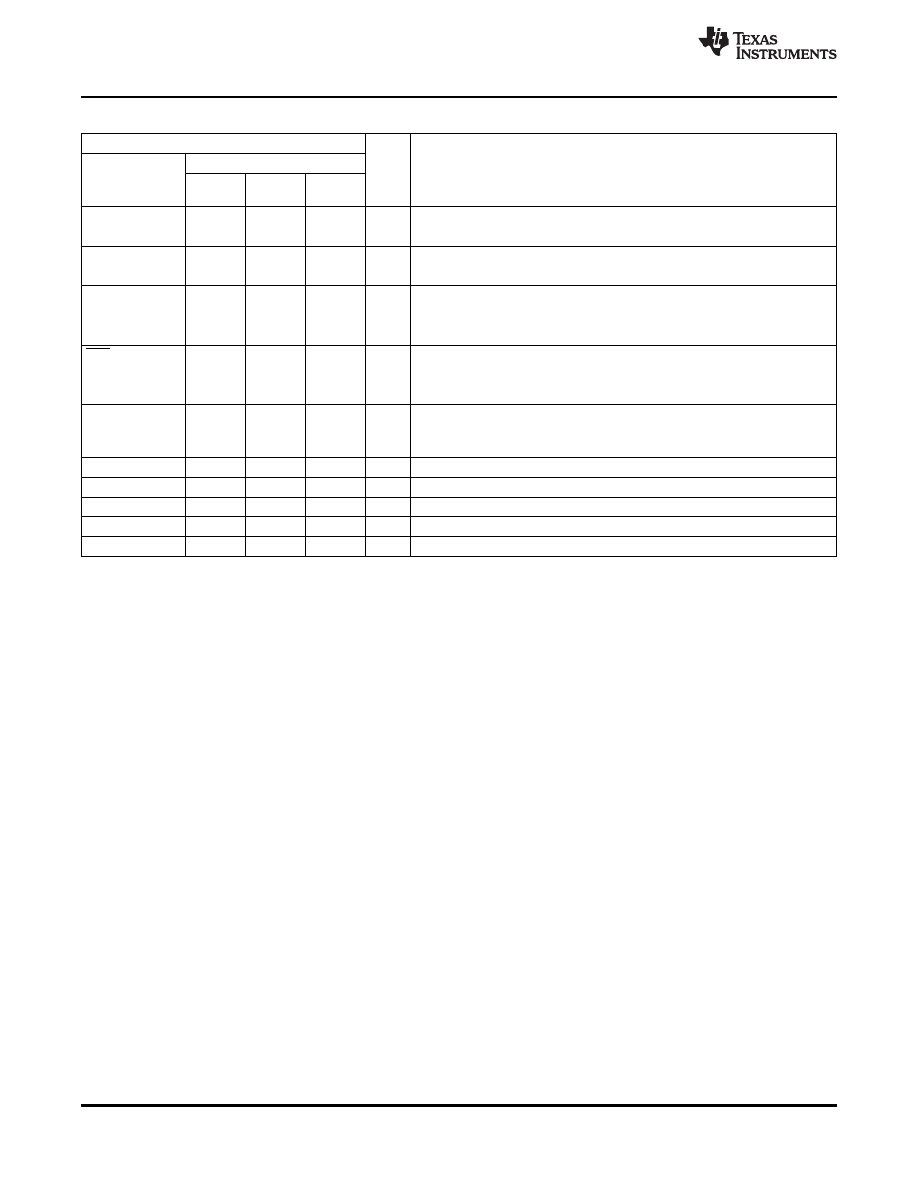
MSP430G2x53
MSP430G2x13
SLAS735F – APRIL 2011 – REVISED MAY 2012
Table 2. Terminal Functions (continued)
TERMINAL
NO.
I/O
DESCRIPTION
NAME
PW20,
PW28
RHB32
N20
P3.5/
General-purpose digital I/O
-
19
18
I/O
TA0.1
Timer0_A, compare: Out1 output
P3.6/
General-purpose digital I/O
-
20
19
I/O
TA0.2
Timer0_A, compare: Out2 output
P3.7/
General-purpose digital I/O
TA1CLK/
-
21
20
I/O
Timer1_A, clock signal TACLK input
CAOUT
Comparator_A+, output
RST/
Reset
NMI/
16
24
23
I
Nonmaskable interrupt input
SBWTDIO
Spy-Bi-Wire test data input/output during programming and test
TEST/
Selects test mode for JTAG pins on Port 1. The device protection fuse is
connected to TEST.
17
25
24
I
SBWTCK
Spy-Bi-Wire test clock input during programming and test
AVCC
NA
NA
29
NA
Analog supply voltage
DVCC
1
1
30
NA
Digital supply voltage
DVSS
20
28
27, 28
NA
Ground reference
NC
NA
NA
8, 32
NA
Not connected
QFN Pad
NA
NA
Pad
NA
QFN package pad. Connection to VSS is recommended.
8
Copyright © 2011–2012, Texas Instruments Incorporated
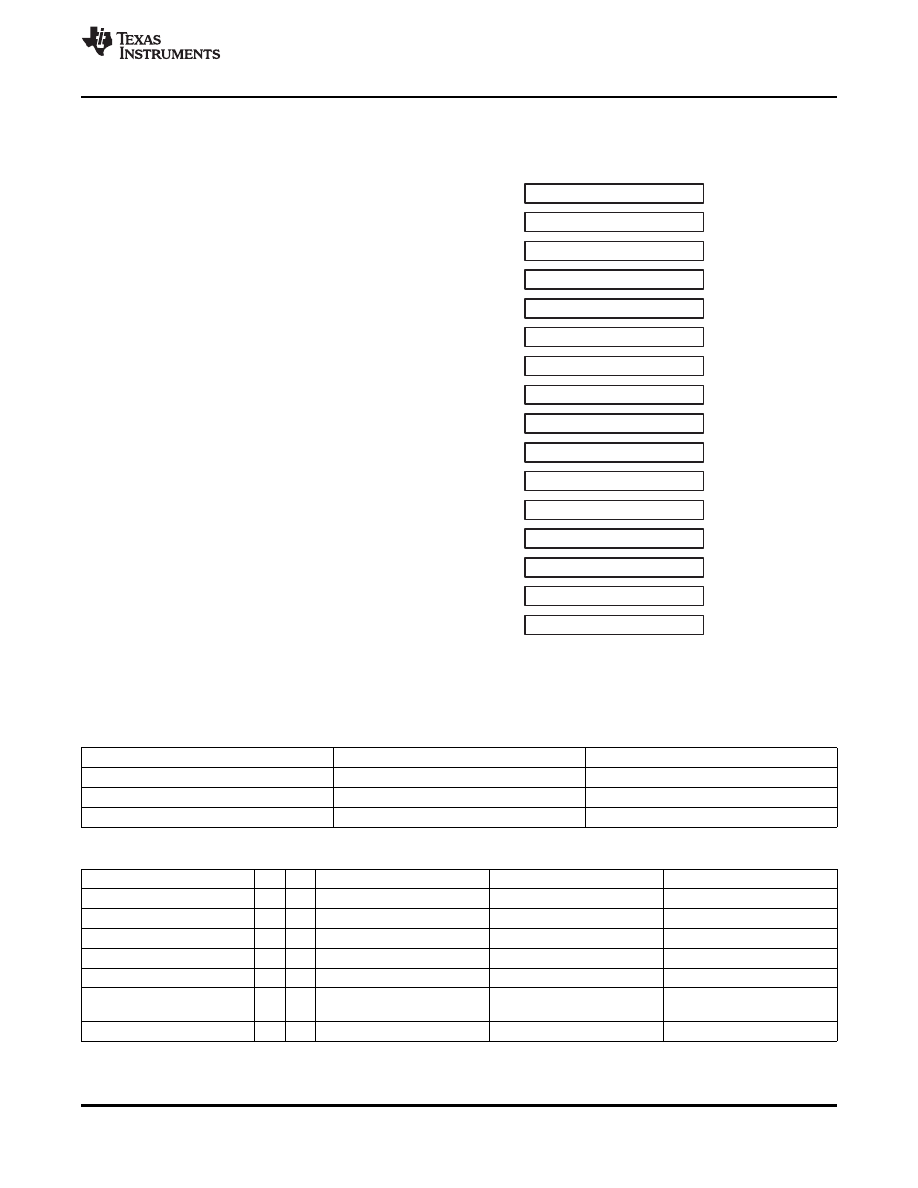
Program Counter
PC/R0
Stack Pointer
SP/R1
Status Register
SR/CG1/R2
Constant Generator
CG2/R3
General-Purpose Register
R4
General-Purpose Register
R5
General-Purpose Register
R6
General-Purpose Register
R7
General-Purpose Register
R8
General-Purpose Register
R9
General-Purpose Register
R10
General-Purpose Register
R11
General-Purpose Register
R12
General-Purpose Register
R13
General-Purpose Register
R15
General-Purpose Register
R14
MSP430G2x53
MSP430G2x13
SLAS735F – APRIL 2011 – REVISED MAY 2012
SHORT-FORM DESCRIPTION
CPU
The MSP430 CPU has a 16-bit RISC architecture
that is highly transparent to the application. All
operations, other than program-flow instructions, are
performed as register operations in conjunction with
seven addressing modes for source operand and four
addressing modes for destination operand.
The CPU is integrated with 16 registers that provide
reduced instruction execution time. The register-to-
register operation execution time is one cycle of the
CPU clock.
Four of the registers, R0 to R3, are dedicated as
program counter, stack pointer, status register, and
constant
generator,
respectively.
The
remaining
registers are general-purpose registers.
Peripherals are connected to the CPU using data,
address, and control buses, and can be handled with
all instructions.
The instruction set consists of the original 51
instructions with three formats and seven address
modes and additional instructions for the expanded
address range. Each instruction can operate on word
and byte data.
Instruction Set
The instruction set consists of 51 instructions with
three formats and seven address modes. Each
instruction can operate on word and byte data.
shows examples of the three types of
instruction formats;
shows the address
modes.
Table 3. Instruction Word Formats
INSTRUCTION FORMAT
EXAMPLE
OPERATION
Dual operands, source-destination
ADD R4,R5
R4 + R5 ---> R5
Single operands, destination only
CALL R8
PC -->(TOS), R8--> PC
Relative jump, un/conditional
JNE
Jump-on-equal bit = 0
Table 4. Address Mode Descriptions
(1)
ADDRESS MODE
S
D
SYNTAX
EXAMPLE
OPERATION
Register
✓
✓
MOV Rs,Rd
MOV R10,R11
R10 -- --> R11
Indexed
✓
✓
MOV X(Rn),Y(Rm)
MOV 2(R5),6(R6)
M(2+R5) -- --> M(6+R6)
Symbolic (PC relative)
✓
✓
MOV EDE,TONI
M(EDE) -- --> M(TONI)
Absolute
✓
✓
MOV &MEM,&TCDAT
M(MEM) -- --> M(TCDAT)
Indirect
✓
MOV @Rn,Y(Rm)
MOV @R10,Tab(R6)
M(R10) -- --> M(Tab+R6)
M(R10) -- --> R11
Indirect autoincrement
✓
MOV @Rn+,Rm
MOV @R10+,R11
R10 + 2-- --> R10
Immediate
✓
MOV #X,TONI
MOV #45,TONI
#45 -- --> M(TONI)
(1)
S = source, D = destination
Copyright © 2011–2012, Texas Instruments Incorporated
9

MSP430G2x53
MSP430G2x13
SLAS735F – APRIL 2011 – REVISED MAY 2012
Operating Modes
The MSP430 has one active mode and five software selectable low-power modes of operation. An interrupt
event can wake up the device from any of the low-power modes, service the request, and restore back to the
low-power mode on return from the interrupt program.
The following six operating modes can be configured by software:
•
Active mode (AM)
–
All clocks are active
•
Low-power mode 0 (LPM0)
–
CPU is disabled
–
ACLK and SMCLK remain active, MCLK is disabled
•
Low-power mode 1 (LPM1)
–
CPU is disabled
–
ACLK and SMCLK remain active, MCLK is disabled
–
DCO's dc generator is disabled if DCO not used in active mode
•
Low-power mode 2 (LPM2)
–
CPU is disabled
–
MCLK and SMCLK are disabled
–
DCO's dc generator remains enabled
–
ACLK remains active
•
Low-power mode 3 (LPM3)
–
CPU is disabled
–
MCLK and SMCLK are disabled
–
DCO's dc generator is disabled
–
ACLK remains active
•
Low-power mode 4 (LPM4)
–
CPU is disabled
–
ACLK is disabled
–
MCLK and SMCLK are disabled
–
DCO's dc generator is disabled
–
Crystal oscillator is stopped
10
Copyright © 2011–2012, Texas Instruments Incorporated

MSP430G2x53
MSP430G2x13
SLAS735F – APRIL 2011 – REVISED MAY 2012
Interrupt Vector Addresses
The interrupt vectors and the power-up starting address are located in the address range 0FFFFh to 0FFC0h.
The vector contains the 16-bit address of the appropriate interrupt handler instruction sequence.
If the reset vector (located at address 0FFFEh) contains 0FFFFh (for example, flash is not programmed), the
CPU goes into LPM4 immediately after power-up.
Table 5. Interrupt Sources, Flags, and Vectors
SYSTEM
WORD
INTERRUPT SOURCE
INTERRUPT FLAG
PRIORITY
INTERRUPT
ADDRESS
Power-Up
PORIFG
External Reset
RSTIFG
Watchdog Timer+
WDTIFG
Reset
0FFFEh
31, highest
Flash key violation
KEYV
(2)
PC out-of-range
(1)
NMI
NMIIFG
(non)-maskable
Oscillator fault
OFIFG
(non)-maskable
0FFFCh
30
Flash memory access violation
ACCVIFG
(2) (3)
(non)-maskable
Timer1_A3
TA1CCR0 CCIFG
(4)
maskable
0FFFAh
29
Timer1_A3
TA1CCR2 TA1CCR1 CCIFG,
maskable
0FFF8h
28
TAIFG
(2) (4)
Comparator_A+
CAIFG
(4)
maskable
0FFF6h
27
Watchdog Timer+
WDTIFG
maskable
0FFF4h
26
Timer0_A3
TA0CCR0 CCIFG
(4)
maskable
0FFF2h
25
Timer0_A3
TA0CCR2 TA0CCR1 CCIFG, TAIFG
maskable
0FFF0h
24
(5) (4)
USCI_A0/USCI_B0 receive
UCA0RXIFG, UCB0RXIFG
(2) (5)
maskable
0FFEEh
23
USCI_B0 I2C status
USCI_A0/USCI_B0 transmit
UCA0TXIFG, UCB0TXIFG
(2) (6)
maskable
0FFECh
22
USCI_B0 I2C receive/transmit
ADC10
ADC10IFG
(4)
maskable
0FFEAh
21
(MSP430G2x53 only)
0FFE8h
20
I/O Port P2 (up to eight flags)
P2IFG.0 to P2IFG.7
(2) (4)
maskable
0FFE6h
19
I/O Port P1 (up to eight flags)
P1IFG.0 to P1IFG.7
(2) (4)
maskable
0FFE4h
18
0FFE2h
17
0FFE0h
16
See
(7)
0FFDEh
15
See
(8)
0FFDEh to
14 to 0, lowest
0FFC0h
(1)
A reset is generated if the CPU tries to fetch instructions from within the module register memory address range (0h to 01FFh) or from
within unused address ranges.
(2)
Multiple source flags
(3)
(non)-maskable: the individual interrupt-enable bit can disable an interrupt event, but the general interrupt enable cannot.
(4)
Interrupt flags are located in the module.
(5)
In SPI mode: UCB0RXIFG. In I2C mode: UCALIFG, UCNACKIFG, ICSTTIFG, UCSTPIFG.
(6)
In UART/SPI mode: UCB0TXIFG. In I2C mode: UCB0RXIFG, UCB0TXIFG.
(7)
This location is used as bootstrap loader security key (BSLSKEY). A 0xAA55 at this location disables the BSL completely. A zero (0h)
disables the erasure of the flash if an invalid password is supplied.
(8)
The interrupt vectors at addresses 0FFDEh to 0FFC0h are not used in this device and can be used for regular program code if
necessary.
Copyright © 2011–2012, Texas Instruments Incorporated
11
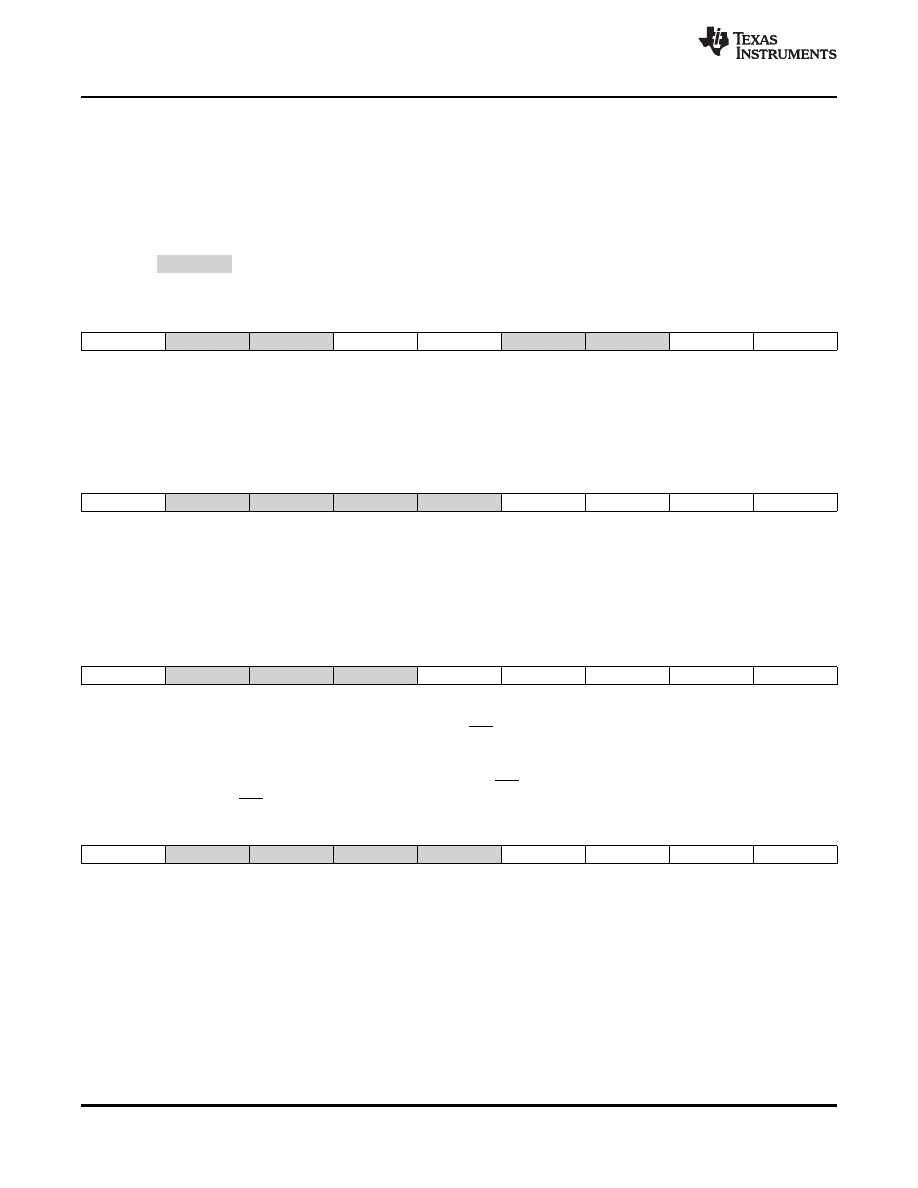
MSP430G2x53
MSP430G2x13
SLAS735F – APRIL 2011 – REVISED MAY 2012
Special Function Registers (SFRs)
Most interrupt and module enable bits are collected into the lowest address space. Special function register bits
not allocated to a functional purpose are not physically present in the device. Simple software access is provided
with this arrangement.
Legend
rw:
Bit can be read and written.
rw-0,1:
Bit can be read and written. It is reset or set by PUC.
rw-(0,1):
Bit can be read and written. It is reset or set by POR.
SFR bit is not present in device.
Table 6. Interrupt Enable Register 1 and 2
Address
7
6
5
4
3
2
1
0
00h
ACCVIE
NMIIE
OFIE
WDTIE
rw-0
rw-0
rw-0
rw-0
WDTIE
Watchdog Timer interrupt enable. Inactive if watchdog mode is selected. Active if Watchdog Timer is configured in
interval timer mode.
OFIE
Oscillator fault interrupt enable
NMIIE
(Non)maskable interrupt enable
ACCVIE
Flash access violation interrupt enable
Address
7
6
5
4
3
2
1
0
01h
UCB0TXIE
UCB0RXIE
UCA0TXIE
UCA0RXIE
rw-0
rw-0
rw-0
rw-0
UCA0RXIE
USCI_A0 receive interrupt enable
UCA0TXIE
USCI_A0 transmit interrupt enable
UCB0RXIE
USCI_B0 receive interrupt enable
UCB0TXIE
USCI_B0 transmit interrupt enable
Table 7. Interrupt Flag Register 1 and 2
Address
7
6
5
4
3
2
1
0
02h
NMIIFG
RSTIFG
PORIFG
OFIFG
WDTIFG
rw-0
rw-(0)
rw-(1)
rw-1
rw-(0)
WDTIFG
Set on watchdog timer overflow (in watchdog mode) or security key violation.
Reset on V
CC
power-on or a reset condition at the RST/NMI pin in reset mode.
OFIFG
Flag set on oscillator fault.
PORIFG
Power-On Reset interrupt flag. Set on V
CC
power-up.
RSTIFG
External reset interrupt flag. Set on a reset condition at RST/NMI pin in reset mode. Reset on V
CC
power-up.
NMIIFG
Set via RST/NMI pin
Address
7
6
5
4
3
2
1
0
03h
UCB0TXIFG
UCB0RXIFG
UCA0TXIFG
UCA0RXIFG
rw-1
rw-0
rw-1
rw-0
UCA0RXIFG
USCI_A0 receive interrupt flag
UCA0TXIFG
USCI_A0 transmit interrupt flag
UCB0RXIFG
USCI_B0 receive interrupt flag
UCB0TXIFG
USCI_B0 transmit interrupt flag
12
Copyright © 2011–2012, Texas Instruments Incorporated
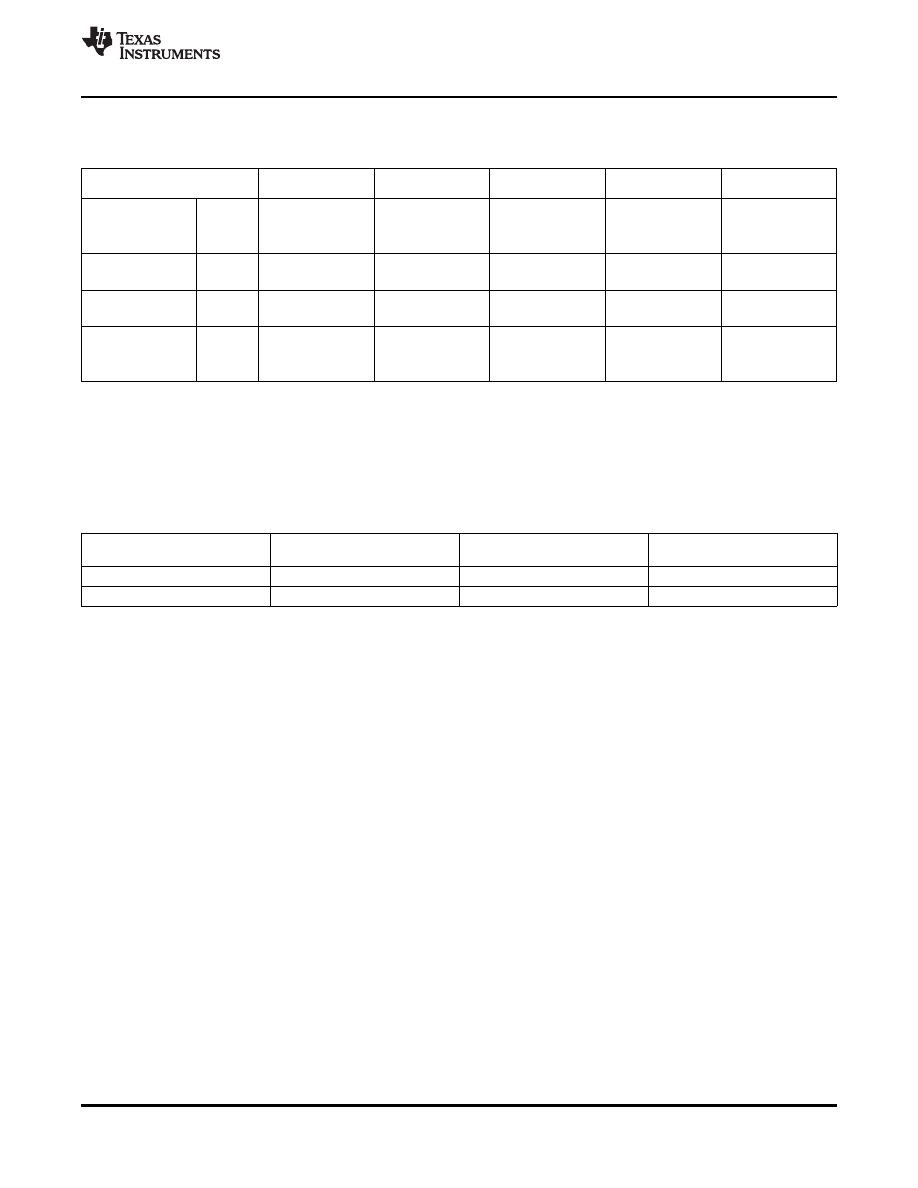
MSP430G2x53
MSP430G2x13
SLAS735F – APRIL 2011 – REVISED MAY 2012
Memory Organization
Table 8. Memory Organization
MSP430G2153
MSP430G2253
MSP430G2353
MSP430G2453
MSP430G2553
MSP430G2113
MSP430G2213
MSP430G2313
MSP430G2413
MSP430G2513
Memory
Size
1kB
2kB
4kB
8kB
16kB
Main: interrupt vector
Flash
0xFFFF to 0xFFC0
0xFFFF to 0xFFC0
0xFFFF to 0xFFC0
0xFFFF to 0xFFC0
0xFFFF to 0xFFC0
Main: code memory
Flash
0xFFFF to 0xFC00
0xFFFF to 0xF800
0xFFFF to 0xF000
0xFFFF to 0xE000
0xFFFF to 0xC000
Information memory
Size
256 Byte
256 Byte
256 Byte
256 Byte
256 Byte
Flash
010FFh to 01000h
010FFh to 01000h
010FFh to 01000h
010FFh to 01000h
010FFh to 01000h
RAM
Size
256 Byte
256 Byte
256 Byte
512 Byte
512 Byte
0x02FF to 0x0200
0x02FF to 0x0200
0x02FF to 0x0200
0x03FF to 0x0200
0x03FF to 0x0200
Peripherals
16-bit
01FFh to 0100h
01FFh to 0100h
01FFh to 0100h
01FFh to 0100h
01FFh to 0100h
8-bit
0FFh to 010h
0FFh to 010h
0FFh to 010h
0FFh to 010h
0FFh to 010h
8-bit SFR
0Fh to 00h
0Fh to 00h
0Fh to 00h
0Fh to 00h
0Fh to 00h
Bootstrap Loader (BSL)
The MSP430 BSL enables users to program the flash memory or RAM using a UART serial interface. Access to
the MSP430 memory via the BSL is protected by user-defined password. For complete description of the
features of the BSL and its implementation, see the MSP430 Programming Via the Bootstrap Loader User's
Guide (
Table 9. BSL Function Pins
20-PIN PW PACKAGE
BSL FUNCTION
28-PIN PACKAGE PW
32-PIN PACKAGE RHB
20-PIN N PACKAGE
Data transmit
3 - P1.1
3 - P1.1
1 - P1.1
Data receive
7 - P1.5
7 - P1.5
5 - P1.5
Flash Memory
The flash memory can be programmed via the Spy-Bi-Wire/JTAG port or in-system by the CPU. The CPU can
perform single-byte and single-word writes to the flash memory. Features of the flash memory include:
•
Flash memory has n segments of main memory and four segments of information memory (A to D) of
64 bytes each. Each segment in main memory is 512 bytes in size.
•
Segments 0 to n may be erased in one step, or each segment may be individually erased.
•
Segments A to D can be erased individually or as a group with segments 0 to n. Segments A to D are also
called information memory.
•
Segment A contains calibration data. After reset segment A is protected against programming and erasing. It
can be unlocked but care should be taken not to erase this segment if the device-specific calibration data is
required.
Copyright © 2011–2012, Texas Instruments Incorporated
13

DCO(RSEL,DCO+1)
DCO(RSEL,DCO)
average
DCO(RSEL,DCO)
DCO(RSEL,DCO+1)
32 × f
× f
f
=
MOD × f
+ (32 – MOD) × f
MSP430G2x53
MSP430G2x13
SLAS735F – APRIL 2011 – REVISED MAY 2012
Peripherals
Peripherals are connected to the CPU through data, address, and control buses and can be handled using all
instructions. For complete module descriptions, see the MSP430x2xx Family User's Guide (
Oscillator and System Clock
The clock system is supported by the basic clock module that includes support for a 32768-Hz watch crystal
oscillator, an internal very-low-power low-frequency oscillator and an internal digitally controlled oscillator (DCO).
The basic clock module is designed to meet the requirements of both low system cost and low power
consumption. The internal DCO provides a fast turn-on clock source and stabilizes in less than 1 µs. The basic
clock module provides the following clock signals:
•
Auxiliary clock (ACLK), sourced either from a 32768-Hz watch crystal or the internal LF oscillator.
•
Main clock (MCLK), the system clock used by the CPU.
•
Sub-Main clock (SMCLK), the sub-system clock used by the peripheral modules.
The DCO settings to calibrate the DCO output frequency are stored in the information memory segment A.
Main DCO Characteristics
•
All ranges selected by RSELx overlap with RSELx + 1: RSELx = 0 overlaps RSELx = 1, ... RSELx = 14
overlaps RSELx = 15.
•
DCO control bits DCOx have a step size as defined by parameter S
DCO
.
•
Modulation control bits MODx select how often f
DCO(RSEL,DCO+1)
is used within the period of 32 DCOCLK
cycles. The frequency f
DCO(RSEL,DCO)
is used for the remaining cycles. The frequency is an average equal to:
14
Copyright © 2011–2012, Texas Instruments Incorporated
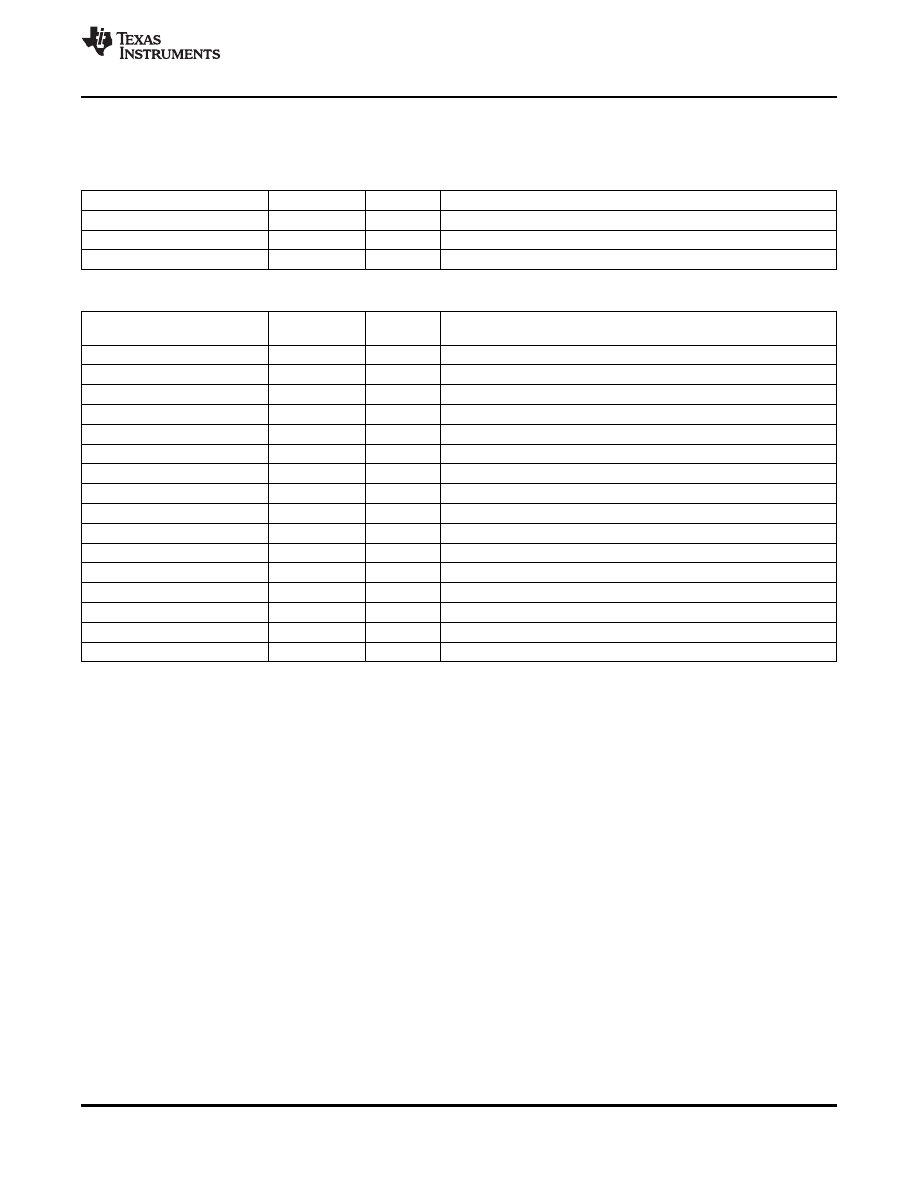
MSP430G2x53
MSP430G2x13
SLAS735F – APRIL 2011 – REVISED MAY 2012
Calibration Data Stored in Information Memory Segment A
Calibration data is stored for both the DCO and for ADC10 organized in a tag-length-value structure.
Table 10. Tags Used by the ADC Calibration Tags
NAME
ADDRESS
VALUE
DESCRIPTION
TAG_DCO_30
0x10F6
0x01
DCO frequency calibration at V
CC
= 3 V and T
A
= 30°C at calibration
TAG_ADC10_1
0x10DA
0x10
ADC10_1 calibration tag
TAG_EMPTY
-
0xFE
Identifier for empty memory areas
Table 11. Labels Used by the ADC Calibration Tags
ADDRESS
LABEL
SIZE
CONDITION AT CALIBRATION / DESCRIPTION
OFFSET
CAL_ADC_25T85
0x0010
word
INCHx = 0x1010, REF2_5 = 1, T
A
= 85°C
CAL_ADC_25T30
0x000E
word
INCHx = 0x1010, REF2_5 = 1, T
A
= 30°C
CAL_ADC_25VREF_FACTOR
0x000C
word
REF2_5 = 1, T
A
= 30°C, I
VREF+
= 1 mA
CAL_ADC_15T85
0x000A
word
INCHx = 0x1010, REF2_5 = 0, T
A
= 85°C
CAL_ADC_15T30
0x0008
word
INCHx = 0x1010, REF2_5 = 0, T
A
= 30°C
CAL_ADC_15VREF_FACTOR
0x0006
word
REF2_5 = 0, T
A
= 30°C, I
VREF+
= 0.5 mA
CAL_ADC_OFFSET
0x0004
word
External VREF = 1.5 V, f
ADC10CLK
= 5 MHz
CAL_ADC_GAIN_FACTOR
0x0002
word
External VREF = 1.5 V, f
ADC10CLK
= 5 MHz
CAL_BC1_1MHZ
0x0009
byte
-
CAL_DCO_1MHZ
0x0008
byte
-
CAL_BC1_8MHZ
0x0007
byte
-
CAL_DCO_8MHZ
0x0006
byte
-
CAL_BC1_12MHZ
0x0005
byte
-
CAL_DCO_12MHZ
0x0004
byte
-
CAL_BC1_16MHZ
0x0003
byte
-
CAL_DCO_16MHZ
0x0002
byte
-
Brownout
The brownout circuit is implemented to provide the proper internal reset signal to the device during power on and
power off.
Digital I/O
Up to three 8-bit I/O ports are implemented:
•
All individual I/O bits are independently programmable.
•
Any combination of input, output, and interrupt condition (port P1 and port P2 only) is possible.
•
Edge-selectable interrupt input capability for all bits of port P1 and port P2 (if available).
•
Read/write access to port-control registers is supported by all instructions.
•
Each I/O has an individually programmable pullup/pulldown resistor.
•
Each I/O has an individually programmable pin oscillator enable bit to enable low-cost touch sensing.
WDT+ Watchdog Timer
The primary function of the watchdog timer (WDT+) module is to perform a controlled system restart after a
software problem occurs. If the selected time interval expires, a system reset is generated. If the watchdog
function is not needed in an application, the module can be disabled or configured as an interval timer and can
generate interrupts at selected time intervals.
Copyright © 2011–2012, Texas Instruments Incorporated
15
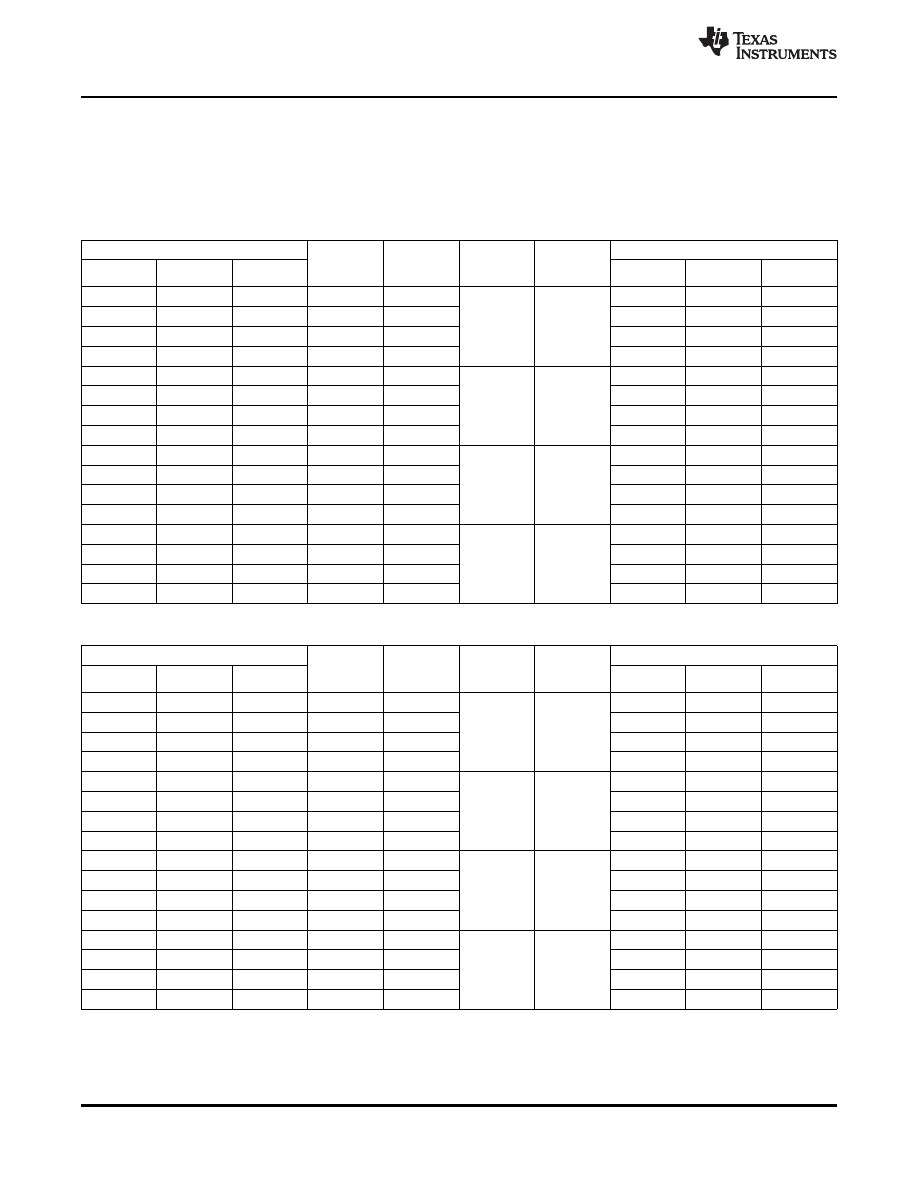
MSP430G2x53
MSP430G2x13
SLAS735F – APRIL 2011 – REVISED MAY 2012
Timer_A3 (TA0, TA1)
Timer0/1_A3 is a 16-bit timer/counter with three capture/compare registers. Timer_A3 can support multiple
capture/compares, PWM outputs, and interval timing. Timer_A3 also has extensive interrupt capabilities.
Interrupts may be generated from the counter on overflow conditions and from each of the capture/compare
registers.
Table 12. Timer0_A3 Signal Connections
INPUT PIN NUMBER
DEVICE
MODULE
MODULE
OUTPUT PIN NUMBER
MODULE
INPUT
INPUT
OUTPUT
BLOCK
PW20, N20
PW28
RHB32
PW20, N20
PW28
RHB32
SIGNAL
NAME
SIGNAL
P1.0-2
P1.0-2
P1.0-31
TACLK
TACLK
ACLK
ACLK
Timer
NA
SMCLK
SMCLK
PinOsc
PinOsc
PinOsc
TACLK
INCLK
P1.1-3
P1.1-3
P1.1-1
TA0.0
CCI0A
P1.1-3
P1.1-3
P1.1-1
ACLK
CCI0B
P1.5-7
P1.5-7
P1.5-5
CCR0
TA0
V
SS
GND
P3.4-15
P3.4-14
V
CC
V
CC
P1.2-4
P1.2-4
P1.2-2
TA0.1
CCI1A
P1.2-4
P1.2-4
P1.2-2
CAOUT
CCI1B
P1.6-14
P1.6-22
P1.6-21
CCR1
TA1
V
SS
GND
P2.6-19
P2.6-27
P2.6-26
V
CC
V
CC
P3.5-19
P3.5-18
P3.0-9
P3.0-7
TA0.2
CCI2A
P3.0-9
P3.0-7
PinOsc
PinOsc
PinOsc
TA0.2
CCI2B
P3.6-20
P3.6-19
CCR2
TA2
V
SS
GND
V
CC
V
CC
Table 13. Timer1_A3 Signal Connections
INPUT PIN NUMBER
DEVICE
MODULE
MODULE
OUTPUT PIN NUMBER
MODULE
INPUT
INPUT
OUTPUT
BLOCK
PW20, N20
PW28
RHB32
PW20, N20
PW28
RHB32
SIGNAL
NAME
SIGNAL
-
P3.7-21
P3.7-20
TACLK
TACLK
ACLK
ACLK
Timer
NA
SMCLK
SMCLK
-
P3.7-21
P3.7-20
TACLK
INCLK
P2.0-8
P2.0-10
P2.0-9
TA1.0
CCI0A
P2.0-8
P2.0-10
P2.0-9
P2.3-11
P2.3-16
P2.3-12
TA1.0
CCI0B
P2.3-11
P2.3-16
P2.3-15
CCR0
TA0
V
SS
GND
P3.1-8
P3.1-6
V
CC
V
CC
P2.1-9
P2.1-11
P2.1-10
TA1.1
CCI1A
P2.1-9
P2.1-11
P2.1-10
P2.2-10
P2.2-12
P2.2-11
TA1.1
CCI1B
P2.2-10
P2.2-12
P2.2-11
CCR1
TA1
V
SS
GND
P3.2-13
P3.2-12
V
CC
V
CC
P2.4-12
P2.4-17
P2.4-16
TA1.2
CCI2A
P2.4-12
P2.4-17
P2.4-16
P2.5-13
P2.5-18
P2.5-17
TA1.2
CCI2B
P2.5-13
P2.5-18
P2.5-17
CCR2
TA2
V
SS
GND
P3.3-14
P3.3-13
V
CC
V
CC
16
Copyright © 2011–2012, Texas Instruments Incorporated

MSP430G2x53
MSP430G2x13
SLAS735F – APRIL 2011 – REVISED MAY 2012
Universal Serial Communications Interface (USCI)
The USCI module is used for serial data communication. The USCI module supports synchronous
communication protocols such as SPI (3 or 4 pin) and I2C, and asynchronous communication protocols such as
UART, enhanced UART with automatic baudrate detection (LIN), and IrDA. Not all packages support the USCI
functionality.
USCI_A0 provides support for SPI (3 or 4 pin), UART, enhanced UART, and IrDA.
USCI_B0 provides support for SPI (3 or 4 pin) and I2C.
Comparator_A+
The primary function of the comparator_A+ module is to support precision slope analog-to-digital conversions,
battery-voltage supervision, and monitoring of external analog signals.
ADC10 (MSP430G2x53 Only)
The ADC10 module supports fast 10-bit analog-to-digital conversions. The module implements a 10-bit SAR
core, sample select control, reference generator, and data transfer controller (DTC) for automatic conversion
result handling, allowing ADC samples to be converted and stored without any CPU intervention.
Copyright © 2011–2012, Texas Instruments Incorporated
17

MSP430G2x53
MSP430G2x13
SLAS735F – APRIL 2011 – REVISED MAY 2012
Peripheral File Map
Table 14. Peripherals With Word Access
REGISTER
MODULE
REGISTER DESCRIPTION
OFFSET
NAME
ADC10
ADC data transfer start address
ADC10SA
1BCh
(MSP430G2x53 devices only)
ADC memory
ADC10MEM
1B4h
ADC control register 1
ADC10CTL1
1B2h
ADC control register 0
ADC10CTL0
1B0h
Timer1_A3
Capture/compare register
TA1CCR2
0196h
Capture/compare register
TA1CCR1
0194h
Capture/compare register
TA1CCR0
0192h
Timer_A register
TA1R
0190h
Capture/compare control
TA1CCTL2
0186h
Capture/compare control
TA1CCTL1
0184h
Capture/compare control
TA1CCTL0
0182h
Timer_A control
TA1CTL
0180h
Timer_A interrupt vector
TA1IV
011Eh
Timer0_A3
Capture/compare register
TA0CCR2
0176h
Capture/compare register
TA0CCR1
0174h
Capture/compare register
TA0CCR0
0172h
Timer_A register
TA0R
0170h
Capture/compare control
TA0CCTL2
0166h
Capture/compare control
TA0CCTL1
0164h
Capture/compare control
TA0CCTL0
0162h
Timer_A control
TA0CTL
0160h
Timer_A interrupt vector
TA0IV
012Eh
Flash Memory
Flash control 3
FCTL3
012Ch
Flash control 2
FCTL2
012Ah
Flash control 1
FCTL1
0128h
Watchdog Timer+
Watchdog/timer control
WDTCTL
0120h
18
Copyright © 2011–2012, Texas Instruments Incorporated
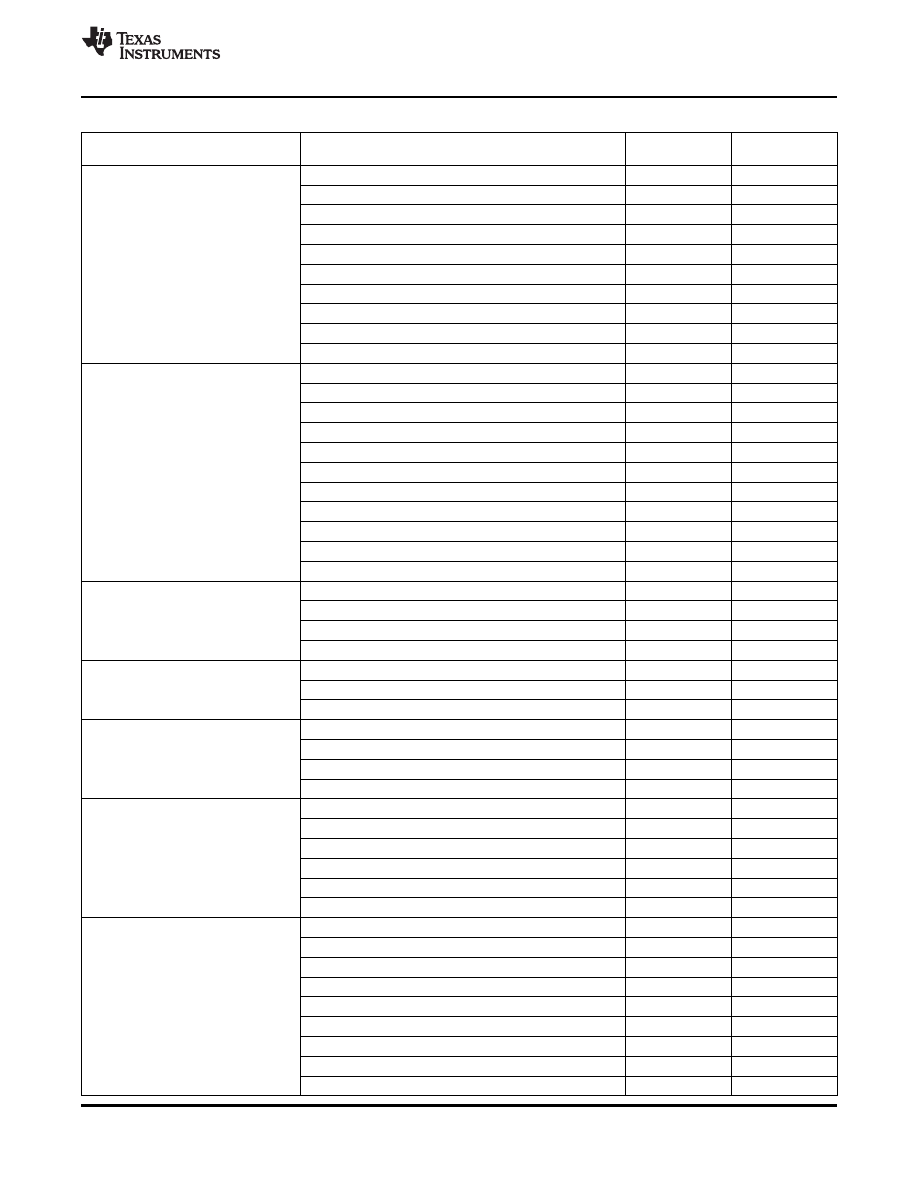
MSP430G2x53
MSP430G2x13
SLAS735F – APRIL 2011 – REVISED MAY 2012
Table 15. Peripherals With Byte Access
REGISTER
MODULE
REGISTER DESCRIPTION
OFFSET
NAME
USCI_B0
USCI_B0 transmit buffer
UCB0TXBUF
06Fh
USCI_B0 receive buffer
UCB0RXBUF
06Eh
USCI_B0 status
UCB0STAT
06Dh
USCI B0 I2C Interrupt enable
UCB0CIE
06Ch
USCI_B0 bit rate control 1
UCB0BR1
06Bh
USCI_B0 bit rate control 0
UCB0BR0
06Ah
USCI_B0 control 1
UCB0CTL1
069h
USCI_B0 control 0
UCB0CTL0
068h
USCI_B0 I2C slave address
UCB0SA
011Ah
USCI_B0 I2C own address
UCB0OA
0118h
USCI_A0
USCI_A0 transmit buffer
UCA0TXBUF
067h
USCI_A0 receive buffer
UCA0RXBUF
066h
USCI_A0 status
UCA0STAT
065h
USCI_A0 modulation control
UCA0MCTL
064h
USCI_A0 baud rate control 1
UCA0BR1
063h
USCI_A0 baud rate control 0
UCA0BR0
062h
USCI_A0 control 1
UCA0CTL1
061h
USCI_A0 control 0
UCA0CTL0
060h
USCI_A0 IrDA receive control
UCA0IRRCTL
05Fh
USCI_A0 IrDA transmit control
UCA0IRTCTL
05Eh
USCI_A0 auto baud rate control
UCA0ABCTL
05Dh
ADC10
ADC analog enable 0
ADC10AE0
04Ah
(MSP430G2x53 devices only)
ADC analog enable 1
ADC10AE1
04Bh
ADC data transfer control register 1
ADC10DTC1
049h
ADC data transfer control register 0
ADC10DTC0
048h
Comparator_A+
Comparator_A+ port disable
CAPD
05Bh
Comparator_A+ control 2
CACTL2
05Ah
Comparator_A+ control 1
CACTL1
059h
Basic Clock System+
Basic clock system control 3
BCSCTL3
053h
Basic clock system control 2
BCSCTL2
058h
Basic clock system control 1
BCSCTL1
057h
DCO clock frequency control
DCOCTL
056h
Port P3
Port P3 selection 2. pin
P3SEL2
043h
(28-pin PW and 32-pin RHB only)
Port P3 resistor enable
P3REN
010h
Port P3 selection
P3SEL
01Bh
Port P3 direction
P3DIR
01Ah
Port P3 output
P3OUT
019h
Port P3 input
P3IN
018h
Port P2
Port P2 selection 2
P2SEL2
042h
Port P2 resistor enable
P2REN
02Fh
Port P2 selection
P2SEL
02Eh
Port P2 interrupt enable
P2IE
02Dh
Port P2 interrupt edge select
P2IES
02Ch
Port P2 interrupt flag
P2IFG
02Bh
Port P2 direction
P2DIR
02Ah
Port P2 output
P2OUT
029h
Port P2 input
P2IN
028h
Copyright © 2011–2012, Texas Instruments Incorporated
19
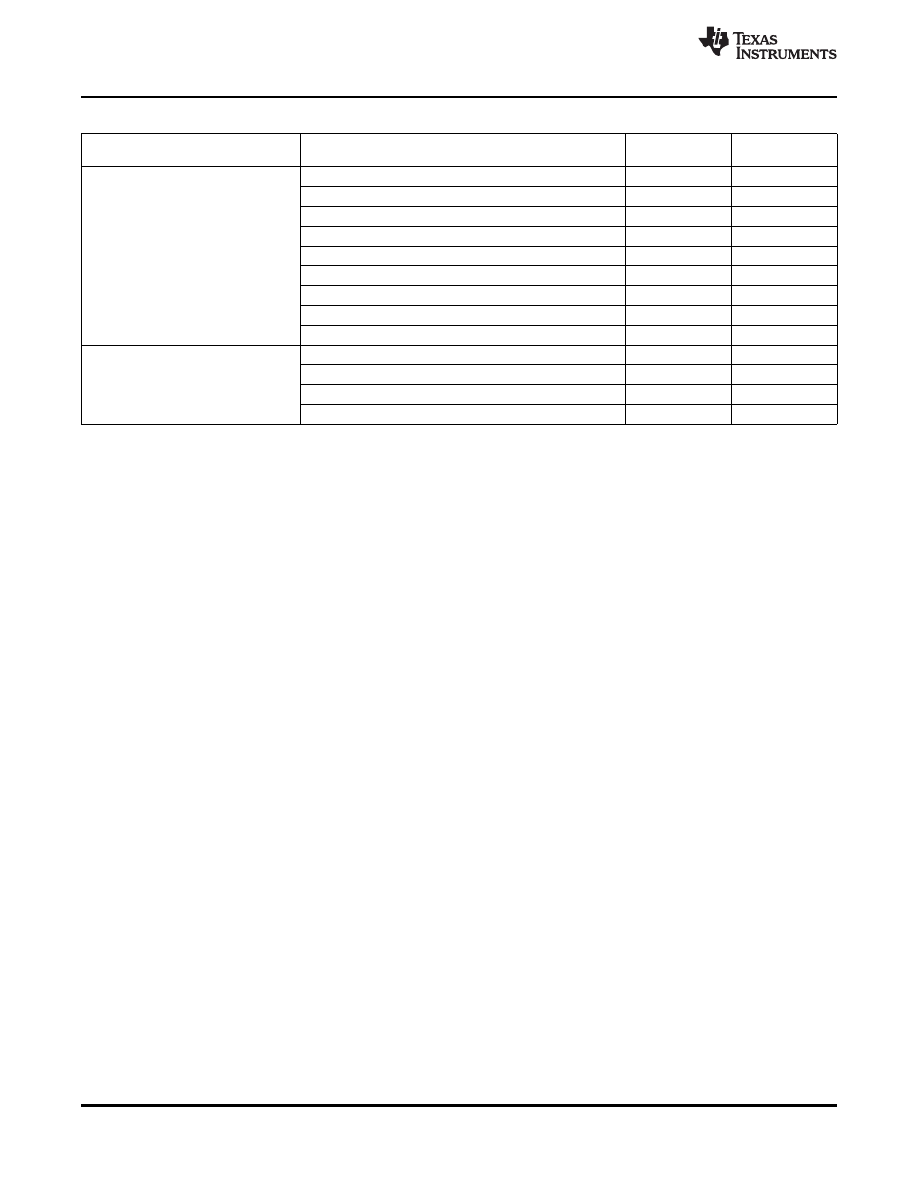
MSP430G2x53
MSP430G2x13
SLAS735F – APRIL 2011 – REVISED MAY 2012
Table 15. Peripherals With Byte Access (continued)
REGISTER
MODULE
REGISTER DESCRIPTION
OFFSET
NAME
Port P1
Port P1 selection 2
P1SEL2
041h
Port P1 resistor enable
P1REN
027h
Port P1 selection
P1SEL
026h
Port P1 interrupt enable
P1IE
025h
Port P1 interrupt edge select
P1IES
024h
Port P1 interrupt flag
P1IFG
023h
Port P1 direction
P1DIR
022h
Port P1 output
P1OUT
021h
Port P1 input
P1IN
020h
Special Function
SFR interrupt flag 2
IFG2
003h
SFR interrupt flag 1
IFG1
002h
SFR interrupt enable 2
IE2
001h
SFR interrupt enable 1
IE1
000h
20
Copyright © 2011–2012, Texas Instruments Incorporated
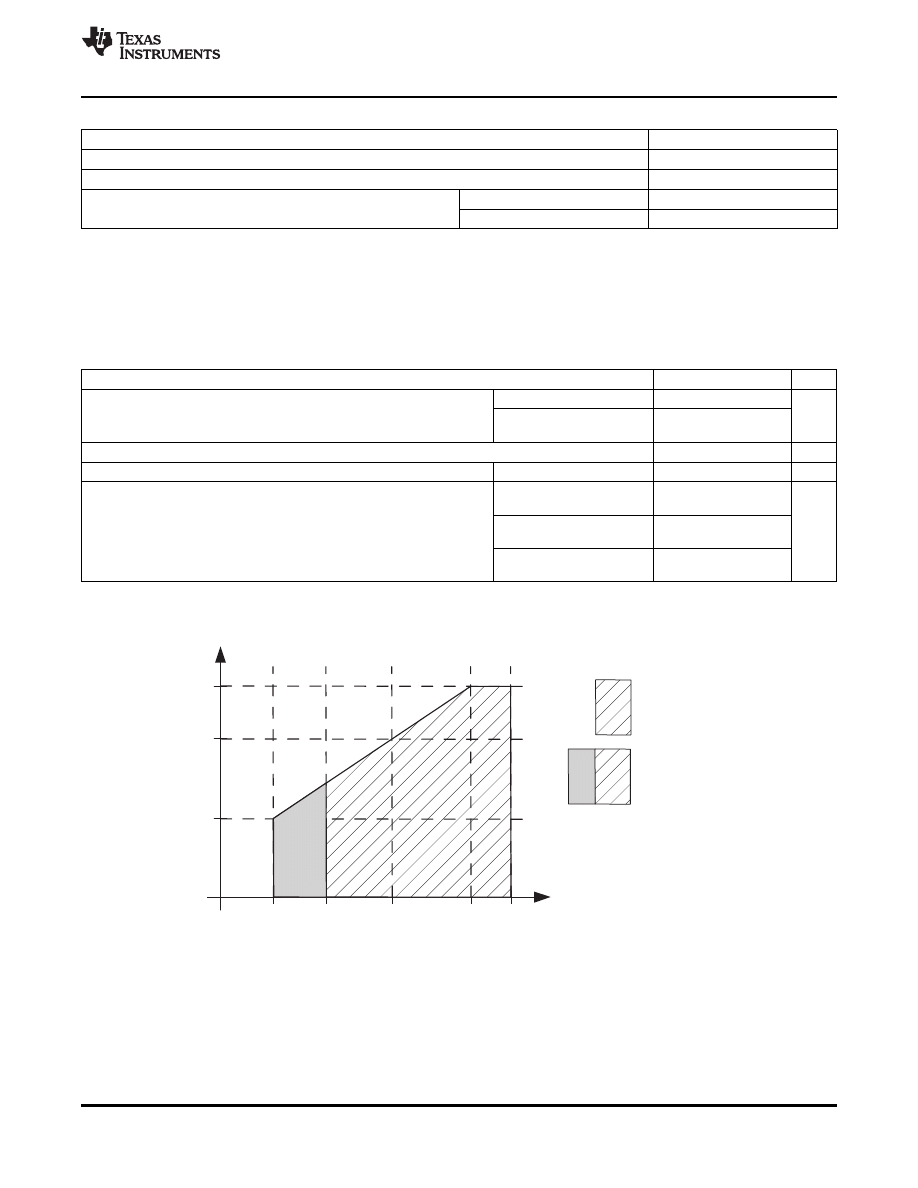
Supply voltage range,
during flash memory
programming
Supply voltage range,
during program execution
Legend :
16 MHz
System Frequency - MHz
12 MHz
6 MHz
1.8 V
Supply Voltage - V
3.3 V
2.7 V
2.2 V
3.6 V
MSP430G2x53
MSP430G2x13
SLAS735F – APRIL 2011 – REVISED MAY 2012
Absolute Maximum Ratings
(1)
Voltage applied at V
CC
to V
SS
–0.3 V to 4.1 V
Voltage applied to any pin
(2)
–0.3 V to V
CC
+ 0.3 V
Diode current at any device pin
±2 mA
Unprogrammed device
–55°C to 150°C
Storage temperature range, T
stg
(3)
Programmed device
–55°C to 150°C
(1)
Stresses beyond those listed under "absolute maximum ratings" may cause permanent damage to the device. These are stress ratings
only, and functional operation of the device at these or any other conditions beyond those indicated under "recommended operating
conditions" is not implied. Exposure to absolute-maximum-rated conditions for extended periods may affect device reliability.
(2)
All voltages referenced to V
SS
. The JTAG fuse-blow voltage, V
FB
, is allowed to exceed the absolute maximum rating. The voltage is
applied to the TEST pin when blowing the JTAG fuse.
(3)
Higher temperature may be applied during board soldering according to the current JEDEC J-STD-020 specification with peak reflow
temperatures not higher than classified on the device label on the shipping boxes or reels.
Recommended Operating Conditions
MIN
NOM
MAX
UNIT
During program execution
1.8
3.6
V
CC
Supply voltage
V
During flash
2.2
3.6
programming/erase
V
SS
Supply voltage
0
V
T
A
Operating free-air temperature
I version
–40
85
°C
V
CC
= 1.8 V,
dc
6
Duty cycle = 50% ± 10%
Processor frequency (maximum MCLK frequency using the
V
CC
= 2.7 V,
f
SYSTEM
dc
12
MHz
USART module)
(1) (2)
Duty cycle = 50% ± 10%
V
CC
= 3.3 V,
dc
16
Duty cycle = 50% ± 10%
(1)
The MSP430 CPU is clocked directly with MCLK. Both the high and low phase of MCLK must not exceed the pulse width of the
specified maximum frequency.
(2)
Modules might have a different maximum input clock specification. See the specification of the respective module in this data sheet.
Note:
Minimum processor frequency is defined by system clock. Flash program or erase operations require a minimum V
CC
of 2.2 V.
Figure 1. Safe Operating Area
Copyright © 2011–2012, Texas Instruments Incorporated
21
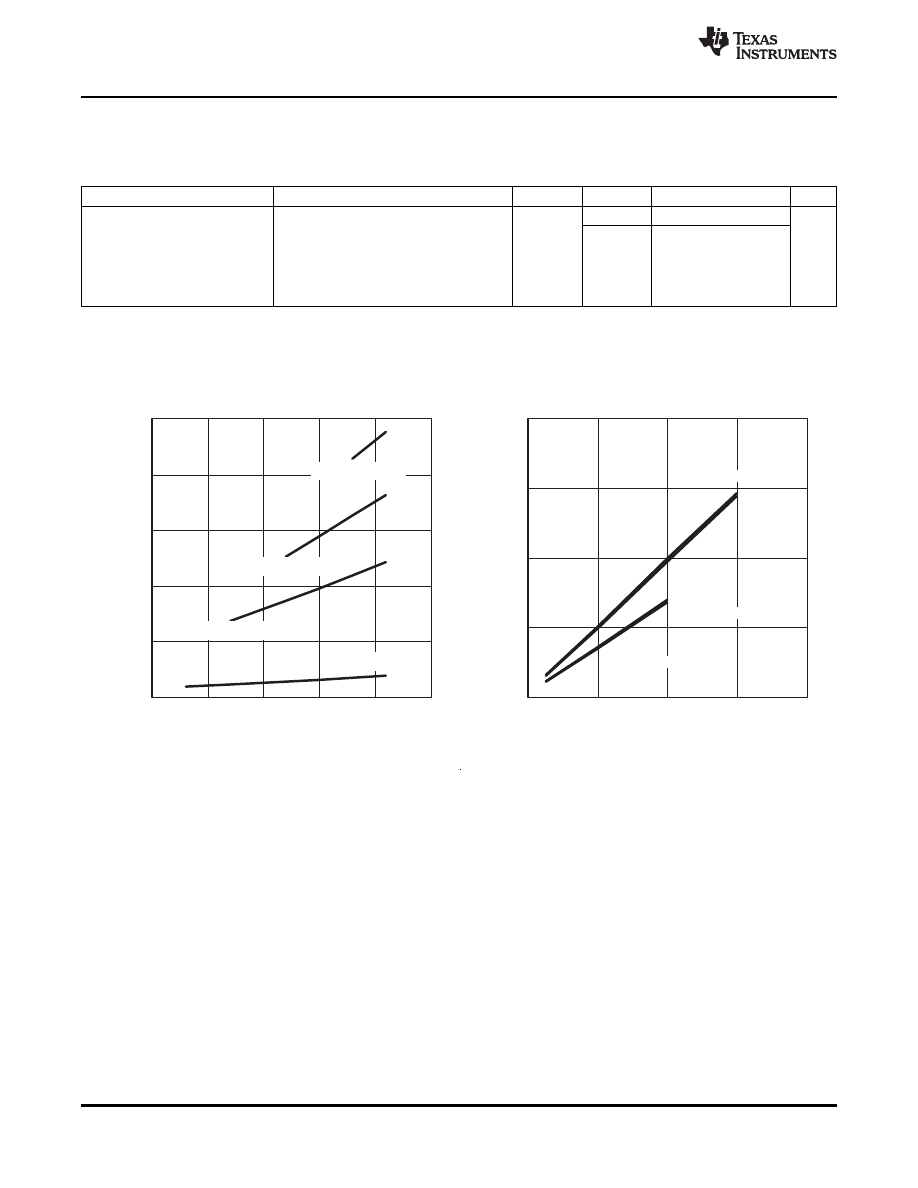
0.0
1.0
2.0
3.0
4.0
5.0
1.5
2.0
2.5
3.0
3.5
4.0
V
CC
− Supply Voltage − V
Active Mode Current
−
mA
f
DCO
= 1 MHz
f
DCO
= 8 MHz
f
DCO
= 12 MHz
f
DCO
= 16 MHz
0.0
1.0
2.0
3.0
4.0
0.0
4.0
8.0
12.0
16.0
f
DCO
− DCO Frequency − MHz
Active Mode Current
−
mA
T
A
= 25 °C
T
A
= 85 °C
V
CC
= 2.2 V
V
CC
= 3 V
T
A
= 25 °C
T
A
= 85 °C
MSP430G2x53
MSP430G2x13
SLAS735F – APRIL 2011 – REVISED MAY 2012
Electrical Characteristics
Active Mode Supply Current Into V
CC
Excluding External Current
over recommended ranges of supply voltage and operating free-air temperature (unless otherwise noted)
(1) (2)
PARAMETER
TEST CONDITIONS
T
A
V
CC
MIN
TYP
MAX
UNIT
f
DCO
= f
MCLK
= f
SMCLK
= 1 MHz,
2.2 V
230
f
ACLK
= 0 Hz,
Program executes in flash,
Active mode (AM)
I
AM,1MHz
BCSCTL1 = CALBC1_1MHZ,
µA
current at 1 MHz
3 V
330
420
DCOCTL = CALDCO_1MHZ,
CPUOFF = 0, SCG0 = 0, SCG1 = 0,
OSCOFF = 0
(1)
All inputs are tied to 0 V or to V
CC
. Outputs do not source or sink any current.
(2)
The currents are characterized with a Micro Crystal CC4V-T1A SMD crystal with a load capacitance of 9 pF. The internal and external
load capacitance is chosen to closely match the required 9 pF.
Typical Characteristics, Active Mode Supply Current (Into V
CC
)
Figure 2. Active Mode Current vs V
CC
, T
A
= 25°C
Figure 3. Active Mode Current vs DCO Frequency
22
Copyright © 2011–2012, Texas Instruments Incorporated
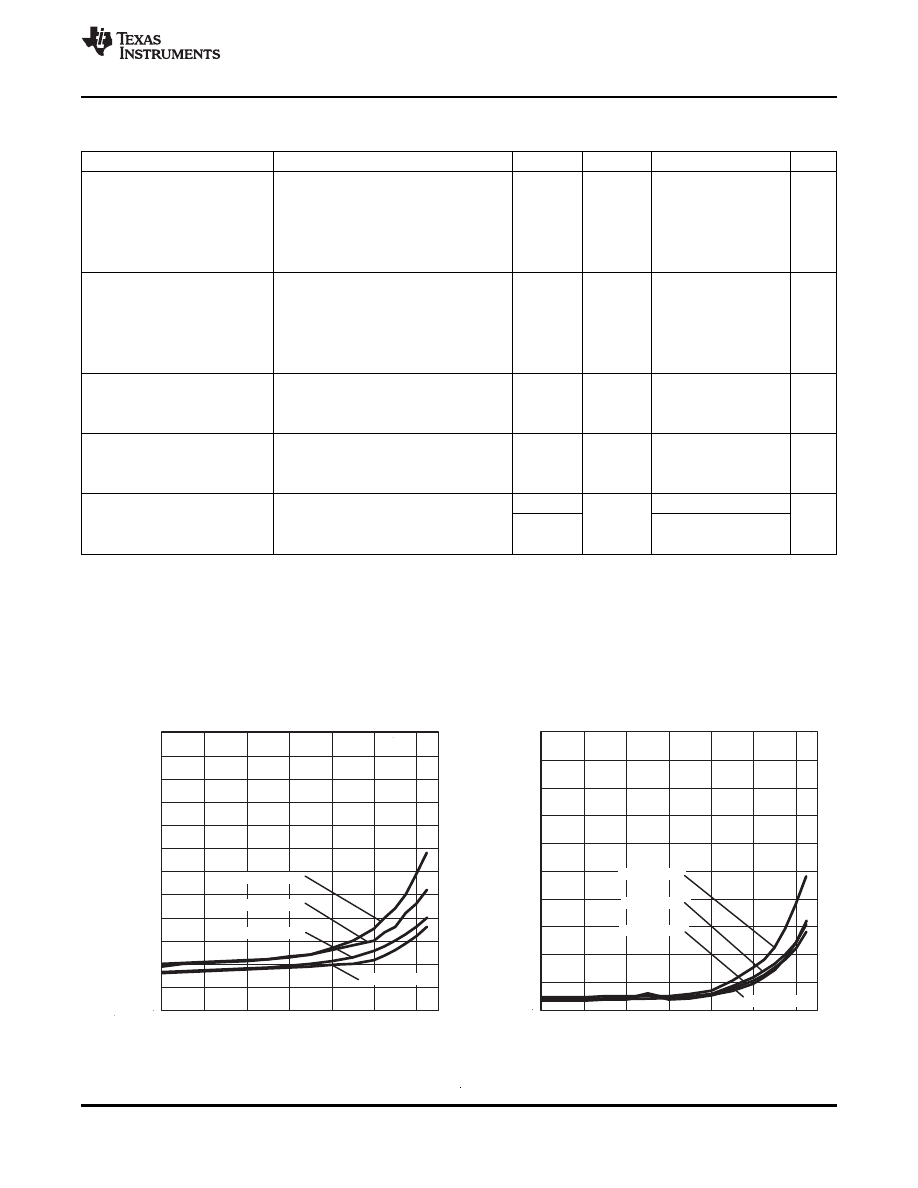
0.00
0.25
0.50
0.75
1.00
1.25
1.50
1.75
2.00
2.25
2.50
2.75
3.00
-40
I
–
Low-Power Mode Current
–
µA
LPM3
Vcc = 3.6 V
T – Temperature – °C
A
Vcc = 1.8 V
Vcc = 3 V
Vcc = 2.2 V
-20
0
20
40
60
80
0.00
0.25
0.50
0.75
1.00
1.25
1.50
1.75
2.00
2.25
2.50
-40
I
–
Low-Power Mode Current
–
µA
LPM4
Vcc = 3.6 V
T – Temperature – °C
A
Vcc = 1.8 V
Vcc = 3 V
Vcc = 2.2 V
-20
0
20
40
60
80
MSP430G2x53
MSP430G2x13
SLAS735F – APRIL 2011 – REVISED MAY 2012
Low-Power Mode Supply Currents (Into V
CC
) Excluding External Current
over recommended ranges of supply voltage and operating free-air temperature (unless otherwise noted)
(1) (2)
PARAMETER
TEST CONDITIONS
T
A
V
CC
MIN
TYP
MAX
UNIT
f
MCLK
= 0 MHz,
f
SMCLK
= f
DCO
= 1 MHz,
f
ACLK
= 32768 Hz,
Low-power mode 0
I
LPM0,1MHz
BCSCTL1 = CALBC1_1MHZ,
25°C
2.2 V
56
µA
(LPM0) current
(3)
DCOCTL = CALDCO_1MHZ,
CPUOFF = 1, SCG0 = 0, SCG1 = 0,
OSCOFF = 0
f
MCLK
= f
SMCLK
= 0 MHz,
f
DCO
= 1 MHz,
f
ACLK
= 32768 Hz,
Low-power mode 2
I
LPM2
BCSCTL1 = CALBC1_1MHZ,
25°C
2.2 V
22
µA
(LPM2) current
(4)
DCOCTL = CALDCO_1MHZ,
CPUOFF = 1, SCG0 = 0, SCG1 = 1,
OSCOFF = 0
f
DCO
= f
MCLK
= f
SMCLK
= 0 MHz,
Low-power mode 3
f
ACLK
= 32768 Hz,
I
LPM3,LFXT1
25°C
2.2 V
0.7
1.5
µA
(LPM3) current
(4)
CPUOFF = 1, SCG0 = 1, SCG1 = 1,
OSCOFF = 0
f
DCO
= f
MCLK
= f
SMCLK
= 0 MHz,
Low-power mode 3
f
ACLK
from internal LF oscillator (VLO),
I
LPM3,VLO
25°C
2.2 V
0.5
0.7
µA
current, (LPM3)
(4)
CPUOFF = 1, SCG0 = 1, SCG1 = 1,
OSCOFF = 0
f
DCO
= f
MCLK
= f
SMCLK
= 0 MHz,
25°C
0.1
0.5
Low-power mode 4
f
ACLK
= 0 Hz,
I
LPM4
2.2 V
µA
(LPM4) current
(5)
CPUOFF = 1, SCG0 = 1, SCG1 = 1,
85°C
0.8
1.7
OSCOFF = 1
(1)
All inputs are tied to 0 V or to V
CC
. Outputs do not source or sink any current.
(2)
The currents are characterized with a Micro Crystal CC4V-T1A SMD crystal with a load capacitance of 9 pF. The internal and external
load capacitance is chosen to closely match the required 9 pF.
(3)
Current for brownout and WDT clocked by SMCLK included.
(4)
Current for brownout and WDT clocked by ACLK included.
(5)
Current for brownout included.
Typical Characteristics, Low-Power Mode Supply Currents
over recommended ranges of supply voltage and operating free-air temperature (unless otherwise noted)
Figure 4. LPM3 Current vs Temperature
Figure 5. LPM4 Current vs Temperature
Copyright © 2011–2012, Texas Instruments Incorporated
23
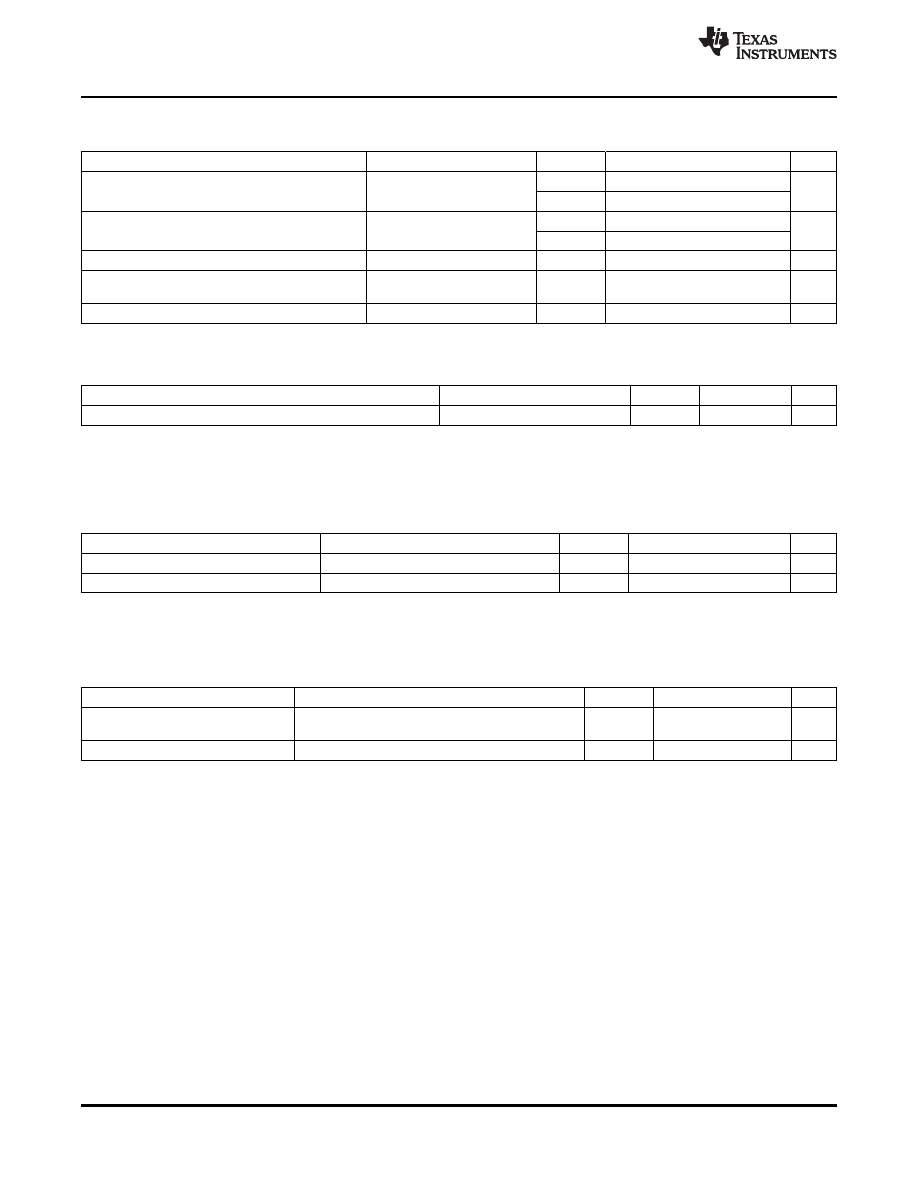
MSP430G2x53
MSP430G2x13
SLAS735F – APRIL 2011 – REVISED MAY 2012
Schmitt-Trigger Inputs, Ports Px
over recommended ranges of supply voltage and operating free-air temperature (unless otherwise noted)
PARAMETER
TEST CONDITIONS
V
CC
MIN
TYP
MAX
UNIT
0.45 V
CC
0.75 V
CC
V
IT+
Positive-going input threshold voltage
V
3 V
1.35
2.25
0.25 V
CC
0.55 V
CC
V
IT–
Negative-going input threshold voltage
V
3 V
0.75
1.65
V
hys
Input voltage hysteresis (V
IT+
– V
IT–
)
3 V
0.3
1
V
For pullup: V
IN
= V
SS
R
Pull
Pullup/pulldown resistor
3 V
20
35
50
k
Ω
For pulldown: V
IN
= V
CC
C
I
Input capacitance
V
IN
= V
SS
or V
CC
5
pF
Leakage Current, Ports Px
over recommended ranges of supply voltage and operating free-air temperature (unless otherwise noted)
PARAMETER
TEST CONDITIONS
V
CC
MIN
MAX
UNIT
I
lkg(Px.y)
High-impedance leakage current
(1) (2)
3 V
±50
nA
(1)
The leakage current is measured with V
SS
or V
CC
applied to the corresponding pin(s), unless otherwise noted.
(2)
The leakage of the digital port pins is measured individually. The port pin is selected for input and the pullup/pulldown resistor is
disabled.
Outputs, Ports Px
over recommended ranges of supply voltage and operating free-air temperature (unless otherwise noted)
PARAMETER
TEST CONDITIONS
V
CC
MIN
TYP
MAX
UNIT
V
OH
High-level output voltage
I
(OHmax)
= –6 mA
(1)
3 V
V
CC
– 0.3
V
V
OL
Low-level output voltage
I
(OLmax)
= 6 mA
(1)
3 V
V
SS
+ 0.3
V
(1)
The maximum total current, I
(OHmax)
and I
(OLmax)
, for all outputs combined should not exceed ±48 mA to hold the maximum voltage drop
specified.
Output Frequency, Ports Px
over recommended ranges of supply voltage and operating free-air temperature (unless otherwise noted)
PARAMETER
TEST CONDITIONS
V
CC
MIN
TYP
MAX
UNIT
Port output frequency
f
Px.y
Px.y, C
L
= 20 pF, R
L
= 1 k
Ω
(1) (2)
3 V
12
MHz
(with load)
f
Port_CLK
Clock output frequency
Px.y, C
L
= 20 pF
(2)
3 V
16
MHz
(1)
A resistive divider with two 0.5-k
Ω
resistors between V
CC
and V
SS
is used as load. The output is connected to the center tap of the
divider.
(2)
The output voltage reaches at least 10% and 90% V
CC
at the specified toggle frequency.
24
Copyright © 2011–2012, Texas Instruments Incorporated
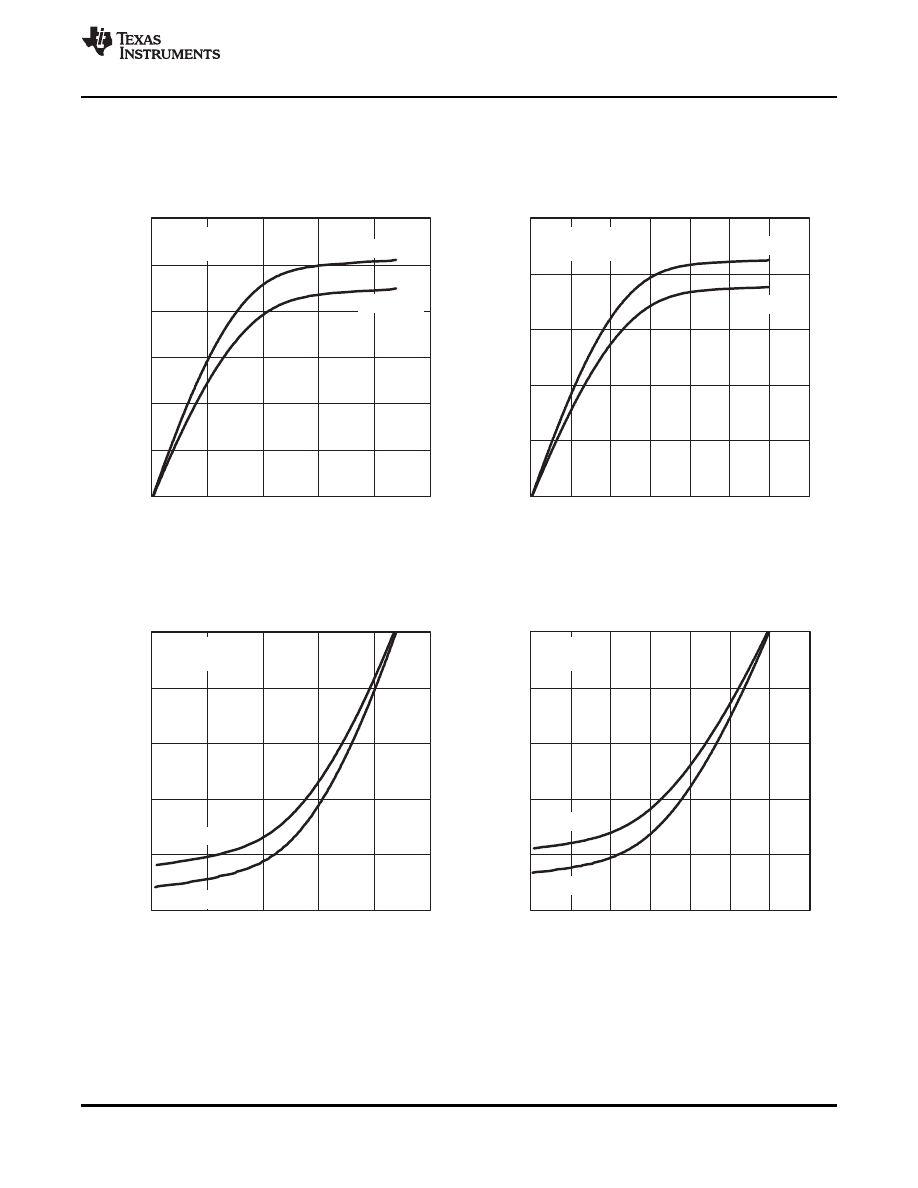
V
OH
− High-Level Output Voltage − V
−25
−20
−15
−10
−5
0
0
0.5
1
1.5
2
2.5
V
CC
= 2.2 V
P1.7
T
A
= 25°C
T
A
= 85°C
OH
I
−
T
ypical High-Level Output Current
−
mA
V
OH
− High-Level Output Voltage − V
−50
−40
−30
−20
−10
0
0
0.5
1
1.5
2
2.5
3
3.5
V
CC
= 3 V
P1.7
T
A
= 25°C
T
A
= 85°C
OH
I
−
T
ypical High-Level Output Current
−
mA
V
OL
− Low-Level Output Voltage − V
0
5
10
15
20
25
30
0
0.5
1
1.5
2
2.5
V
CC
= 2.2 V
P1.7
T
A
= 25°C
T
A
= 85°C
OL
I
−
T
ypical Low-Level Output Current
−
mA
V
OL
− Low-Level Output Voltage − V
0
10
20
30
40
50
0
0.5
1
1.5
2
2.5
3
3.5
V
CC
= 3 V
P1.7
T
A
= 25°C
T
A
= 85°C
OL
I
−
T
ypical Low-Level Output Current
−
mA
MSP430G2x53
MSP430G2x13
SLAS735F – APRIL 2011 – REVISED MAY 2012
Typical Characteristics, Outputs
over recommended ranges of supply voltage and operating free-air temperature (unless otherwise noted)
TYPICAL LOW-LEVEL OUTPUT CURRENT
TYPICAL LOW-LEVEL OUTPUT CURRENT
vs
vs
LOW-LEVEL OUTPUT VOLTAGE
LOW-LEVEL OUTPUT VOLTAGE
Figure 6.
Figure 7.
TYPICAL HIGH-LEVEL OUTPUT CURRENT
TYPICAL HIGH-LEVEL OUTPUT CURRENT
vs
vs
HIGH-LEVEL OUTPUT VOLTAGE
HIGH-LEVEL OUTPUT VOLTAGE
Figure 8.
Figure 9.
Copyright © 2011–2012, Texas Instruments Incorporated
25
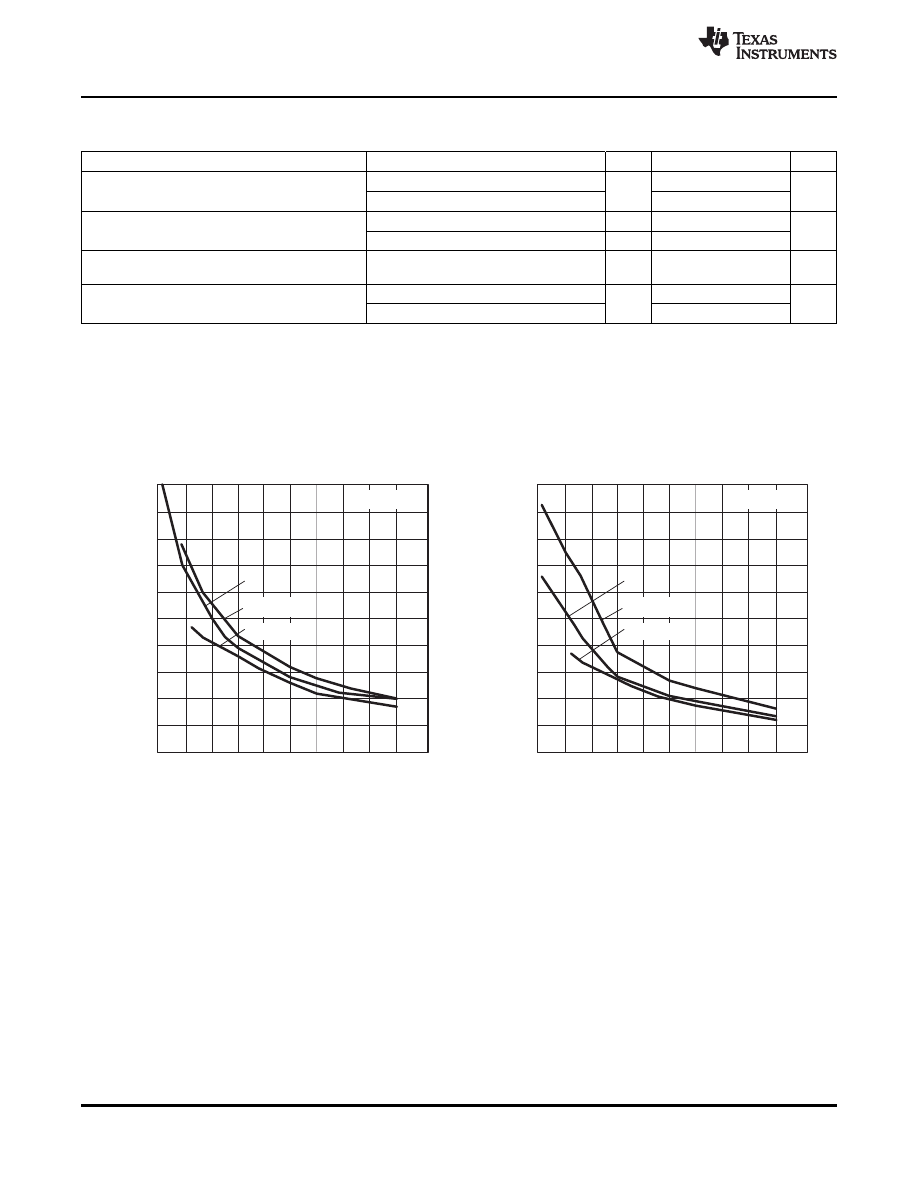
C
LOAD
− External Capacitance − pF
0.00
0.15
0.30
0.45
0.60
0.75
0.90
1.05
1.20
1.35
1.50
10
50
100
P1.y
P2.0 ... P2.5
P2.6, P2.7
V
CC
= 3.0 V
fosc
−
T
ypical Oscillation Frequency
−
MHz
C
LOAD
− External Capacitance − pF
0.00
0.15
0.30
0.45
0.60
0.75
0.90
1.05
1.20
1.35
1.50
10
50
100
P1.y
P2.0 ... P2.5
P2.6, P2.7
V
CC
= 2.2 V
fosc
−
T
ypical Oscillation Frequency
−
MHz
MSP430G2x53
MSP430G2x13
SLAS735F – APRIL 2011 – REVISED MAY 2012
Pin-Oscillator Frequency – Ports Px
over recommended ranges of supply voltage and operating free-air temperature (unless otherwise noted)
PARAMETER
TEST CONDITIONS
V
CC
MIN
TYP
MAX
UNIT
P1.y, C
L
= 10 pF, R
L
= 100 k
Ω
(1) (2)
1400
fo
P1.x
Port output oscillation frequency
3 V
kHz
P1.y, C
L
= 20 pF, R
L
= 100 k
Ω
(1) (2)
900
P2.0 to P2.5, C
L
= 10 pF, R
L
= 100 k
Ω
(1) (2)
1800
fo
P2.x
Port output oscillation frequency
kHz
P2.0 to P2.5, C
L
= 20 pF, R
L
= 100 k
Ω
(1) (2)
3 V
1000
P2.6 and P2.7, C
L
= 20 pF, R
L
= 100
fo
P2.6/7
Port output oscillation frequency
3 V
700
kHz
k
Ω
(1) (2)
P3.y, C
L
= 10 pF, R
L
= 100 k
Ω
(1) (2)
1800
fo
P3.x
Port output oscillation frequency
kHz
P3.y, C
L
= 20 pF, R
L
= 100 k
Ω
(1) (2)
1000
(1)
A resistive divider with two 0.5-k
Ω
resistors between V
CC
and V
SS
is used as load. The output is connected to the center tap of the
divider.
(2)
The output voltage reaches at least 10% and 90% V
CC
at the specified toggle frequency.
Typical Characteristics, Pin-Oscillator Frequency
TYPICAL OSCILLATING FREQUENCY
TYPICAL OSCILLATING FREQUENCY
vs
vs
LOAD CAPACITANCE
LOAD CAPACITANCE
A. One output active at a time.
A. One output active at a time.
Figure 10.
Figure 11.
26
Copyright © 2011–2012, Texas Instruments Incorporated
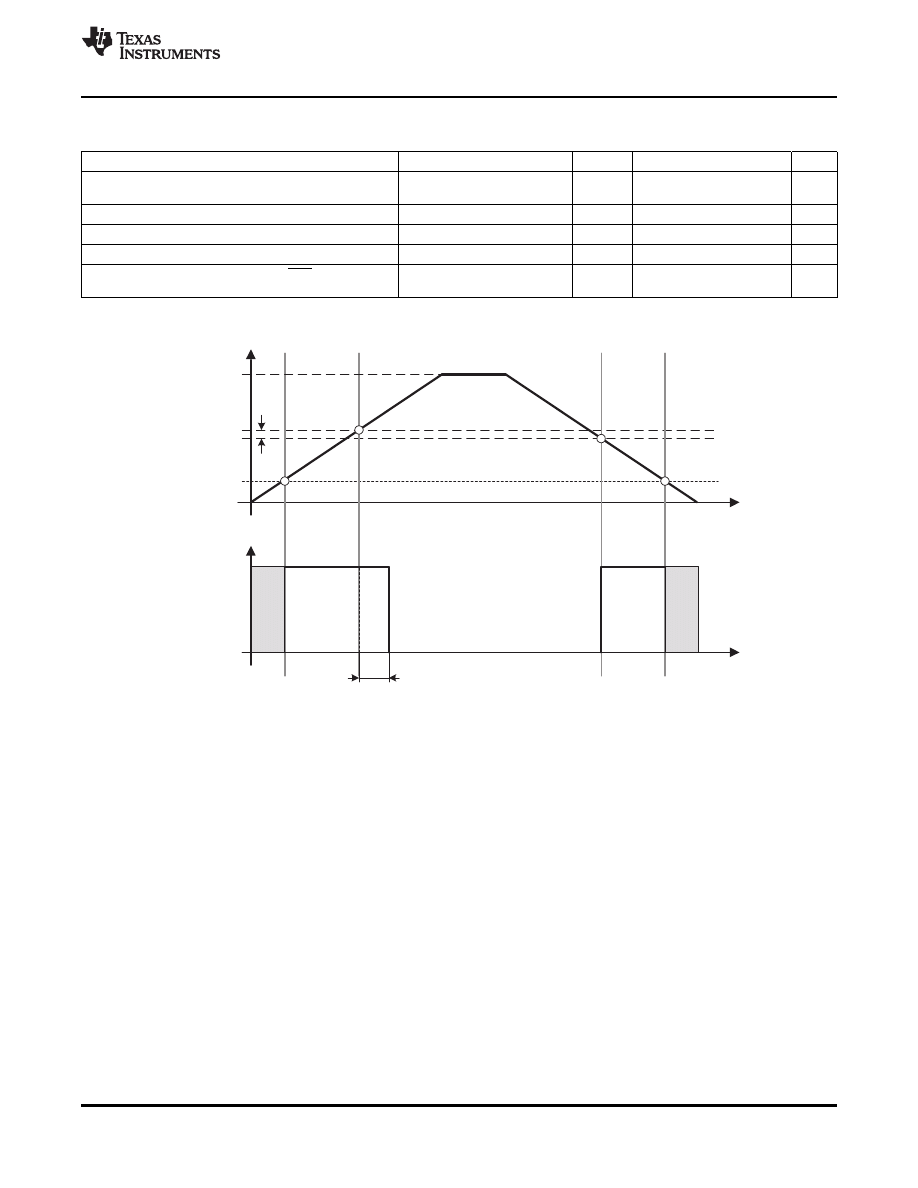
0
1
t d(BOR)
VCC
V(B_IT−)
Vhys(B_IT−)
V
CC(start)
MSP430G2x53
MSP430G2x13
SLAS735F – APRIL 2011 – REVISED MAY 2012
POR/Brownout Reset (BOR)
(1)
over recommended ranges of supply voltage and operating free-air temperature (unless otherwise noted)
PARAMETER
TEST CONDITIONS
V
CC
MIN
TYP
MAX
UNIT
0.7 ×
V
CC(start)
See
dV
CC
/dt
≤
3 V/s
V
V
(B_IT--)
V
(B_IT–)
See
through
dV
CC
/dt
≤
3 V/s
1.35
V
V
hys(B_IT–)
See
dV
CC
/dt
≤
3 V/s
140
mV
t
d(BOR)
See
2000
µs
Pulse length needed at RST/NMI pin to
t
(reset)
2.2 V
2
µs
accepted reset internally
(1)
The current consumption of the brownout module is already included in the I
CC
current consumption data. The voltage level V
(B_IT–)
+
V
hys(B_IT–)
is
≤
1.8 V.
Figure 12. POR/Brownout Reset (BOR) vs Supply Voltage
Copyright © 2011–2012, Texas Instruments Incorporated
27
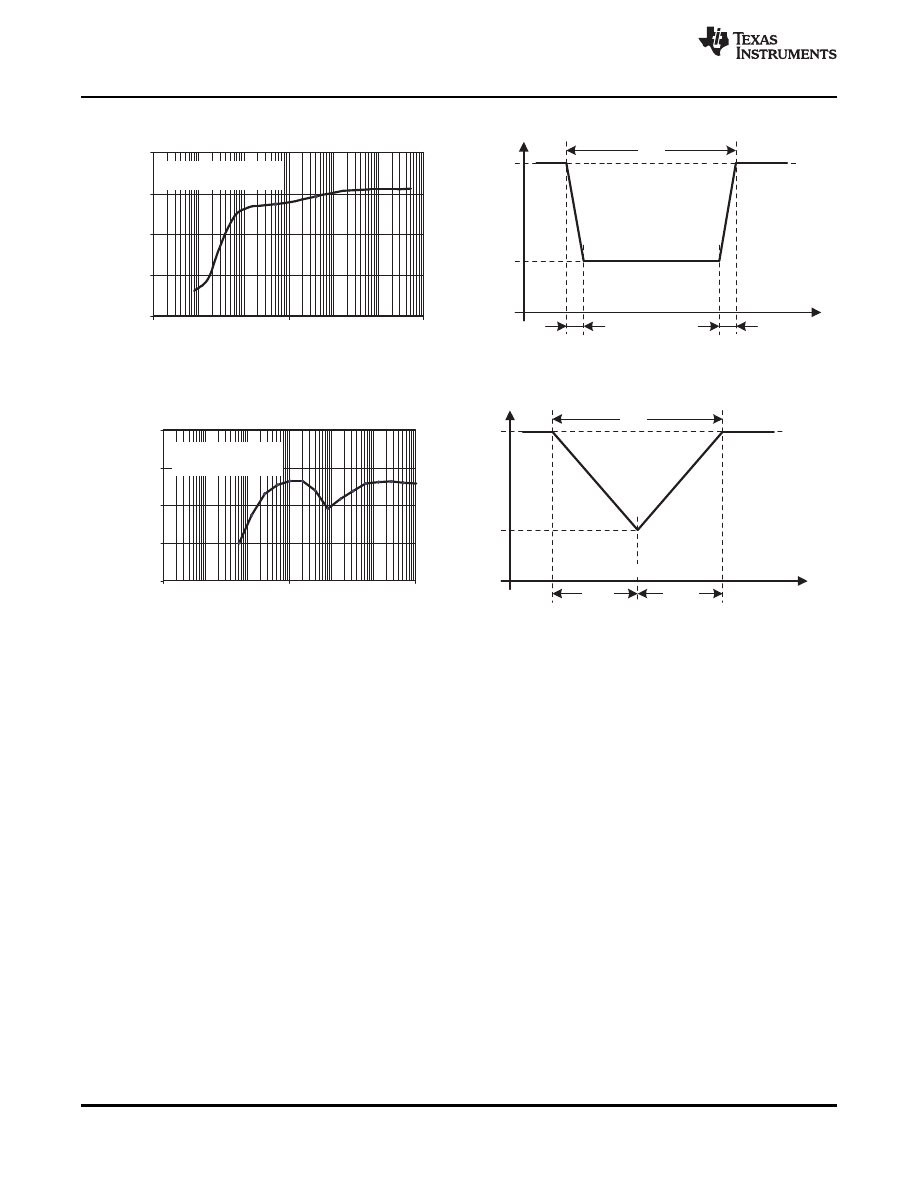
VCC
0
0.5
1
1.5
2
VCC(drop)
t pw
t
pw
− Pulse Width − µs
V
CC(drop)
−
V
3 V
0.001
1
1000
t
f
t
r
t
pw
− Pulse Width − µs
t
f
= t
r
Typical Conditions
V
CC
= 3 V
VCC(drop)
VCC
3 V
t pw
0
0.5
1
1.5
2
0.001
1
1000
Typical Conditions
1 ns
1 ns
t
pw
− Pulse Width − µs
V
CC(drop)
−
V
t
pw
− Pulse Width − µs
V
CC
= 3 V
MSP430G2x53
MSP430G2x13
SLAS735F – APRIL 2011 – REVISED MAY 2012
Typical Characteristics, POR/Brownout Reset (BOR)
Figure 13. V
CC(drop)
Level With a Square Voltage Drop to Generate a POR/Brownout Signal
Figure 14. V
CC(drop)
Level With a Triangle Voltage Drop to Generate a POR/Brownout Signal
28
Copyright © 2011–2012, Texas Instruments Incorporated
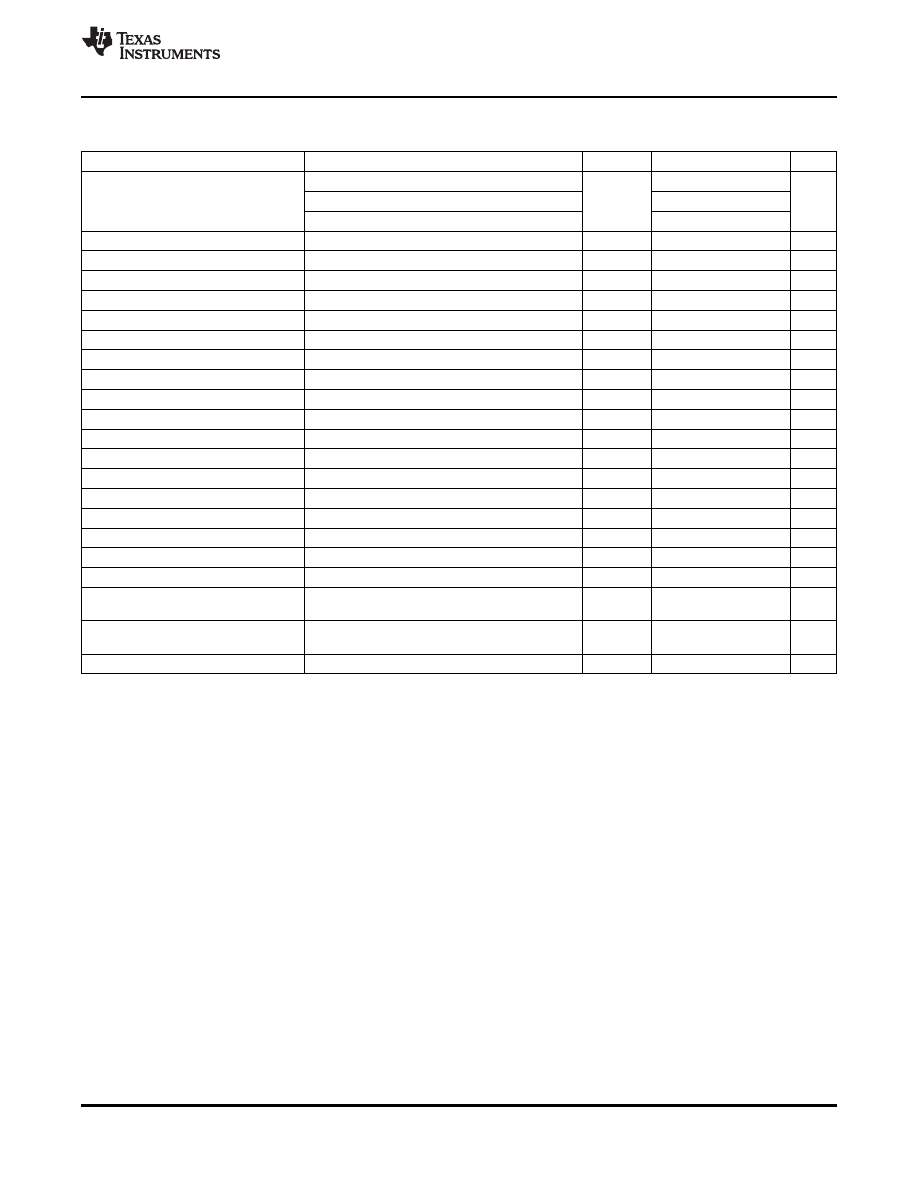
MSP430G2x53
MSP430G2x13
SLAS735F – APRIL 2011 – REVISED MAY 2012
DCO Frequency
over recommended ranges of supply voltage and operating free-air temperature (unless otherwise noted)
PARAMETER
TEST CONDITIONS
V
CC
MIN
TYP
MAX
UNIT
RSELx < 14
1.8
3.6
V
CC
Supply voltage
RSELx = 14
2.2
3.6
V
RSELx = 15
3
3.6
f
DCO(0,0)
DCO frequency (0, 0)
RSELx = 0, DCOx = 0, MODx = 0
3 V
0.06
0.14
MHz
f
DCO(0,3)
DCO frequency (0, 3)
RSELx = 0, DCOx = 3, MODx = 0
3 V
0.07
0.17
MHz
f
DCO(1,3)
DCO frequency (1, 3)
RSELx = 1, DCOx = 3, MODx = 0
3 V
0.15
MHz
f
DCO(2,3)
DCO frequency (2, 3)
RSELx = 2, DCOx = 3, MODx = 0
3 V
0.21
MHz
f
DCO(3,3)
DCO frequency (3, 3)
RSELx = 3, DCOx = 3, MODx = 0
3 V
0.30
MHz
f
DCO(4,3)
DCO frequency (4, 3)
RSELx = 4, DCOx = 3, MODx = 0
3 V
0.41
MHz
f
DCO(5,3)
DCO frequency (5, 3)
RSELx = 5, DCOx = 3, MODx = 0
3 V
0.58
MHz
f
DCO(6,3)
DCO frequency (6, 3)
RSELx = 6, DCOx = 3, MODx = 0
3 V
0.54
1.06
MHz
f
DCO(7,3)
DCO frequency (7, 3)
RSELx = 7, DCOx = 3, MODx = 0
3 V
0.80
1.50
MHz
f
DCO(8,3)
DCO frequency (8, 3)
RSELx = 8, DCOx = 3, MODx = 0
3 V
1.6
MHz
f
DCO(9,3)
DCO frequency (9, 3)
RSELx = 9, DCOx = 3, MODx = 0
3 V
2.3
MHz
f
DCO(10,3)
DCO frequency (10, 3)
RSELx = 10, DCOx = 3, MODx = 0
3 V
3.4
MHz
f
DCO(11,3)
DCO frequency (11, 3)
RSELx = 11, DCOx = 3, MODx = 0
3 V
4.25
MHz
f
DCO(12,3)
DCO frequency (12, 3)
RSELx = 12, DCOx = 3, MODx = 0
3 V
4.30
7.30
MHz
f
DCO(13,3)
DCO frequency (13, 3)
RSELx = 13, DCOx = 3, MODx = 0
3 V
6.00
7.8
9.60
MHz
f
DCO(14,3)
DCO frequency (14, 3)
RSELx = 14, DCOx = 3, MODx = 0
3 V
8.60
13.9
MHz
f
DCO(15,3)
DCO frequency (15, 3)
RSELx = 15, DCOx = 3, MODx = 0
3 V
12.0
18.5
MHz
f
DCO(15,7)
DCO frequency (15, 7)
RSELx = 15, DCOx = 7, MODx = 0
3 V
16.0
26.0
MHz
Frequency step between
S
RSEL
S
RSEL
= f
DCO(RSEL+1,DCO)
/f
DCO(RSEL,DCO)
3 V
1.35
ratio
range RSEL and RSEL+1
Frequency step between
S
DCO
S
DCO
= f
DCO(RSEL,DCO+1)
/f
DCO(RSEL,DCO)
3 V
1.08
ratio
tap DCO and DCO+1
Duty cycle
Measured at SMCLK output
3 V
50
%
Copyright © 2011–2012, Texas Instruments Incorporated
29

MSP430G2x53
MSP430G2x13
SLAS735F – APRIL 2011 – REVISED MAY 2012
Calibrated DCO Frequencies, Tolerance
over recommended ranges of supply voltage and operating free-air temperature (unless otherwise noted)
PARAMETER
TEST CONDITIONS
T
A
V
CC
MIN
TYP
MAX
UNIT
BCSCTL1 = CALBC1_1MHZ,
1-MHz tolerance over
DCOCTL = CALDCO_1MHZ,
0°C to 85°C
3 V
-3
±0.5
+3
%
temperature
(1)
calibrated at 30°C and 3 V
BCSCTL1 = CALBC1_1MHZ,
1-MHz tolerance over V
CC
DCOCTL = CALDCO_1MHZ,
30°C
1.8 V to 3.6 V
-3
±2
+3
%
calibrated at 30°C and 3 V
BCSCTL1 = CALBC1_1MHZ,
1-MHz tolerance overall
DCOCTL = CALDCO_1MHZ,
-40°C to 85°C
1.8 V to 3.6 V
-6
±3
+6
%
calibrated at 30°C and 3 V
BCSCTL1 = CALBC1_8MHZ,
8-MHz tolerance over
DCOCTL = CALDCO_8MHZ,
0°C to 85°C
3 V
-3
±0.5
+3
%
temperature
(1)
calibrated at 30°C and 3 V
BCSCTL1 = CALBC1_8MHZ,
8-MHz tolerance over V
CC
DCOCTL = CALDCO_8MHZ,
30°C
2.2 V to 3.6 V
-3
±2
+3
%
calibrated at 30°C and 3 V
BCSCTL1 = CALBC1_8MHZ,
8-MHz tolerance overall
DCOCTL = CALDCO_8MHZ,
-40°C to 85°C
2.2 V to 3.6 V
-6
±3
+6
%
calibrated at 30°C and 3 V
BCSCTL1 = CALBC1_12MHZ,
12-MHz tolerance over
DCOCTL = CALDCO_12MHZ,
0°C to 85°C
3 V
-3
±0.5
+3
%
temperature
(1)
calibrated at 30°C and 3 V
BCSCTL1 = CALBC1_12MHZ,
12-MHz tolerance over V
CC
DCOCTL = CALDCO_12MHZ,
30°C
2.7 V to 3.6 V
-3
±2
+3
%
calibrated at 30°C and 3 V
BCSCTL1 = CALBC1_12MHZ,
12-MHz tolerance overall
DCOCTL = CALDCO_12MHZ,
-40°C to 85°C
2.7 V to 3.6 V
-6
±3
+6
%
calibrated at 30°C and 3 V
BCSCTL1 = CALBC1_16MHZ,
16-MHz tolerance over
DCOCTL = CALDCO_16MHZ,
0°C to 85°C
3 V
-3
±0.5
+3
%
temperature
(1)
calibrated at 30°C and 3 V
BCSCTL1 = CALBC1_16MHZ,
16-MHz tolerance over V
CC
DCOCTL = CALDCO_16MHZ,
30°C
3.3 V to 3.6 V
-3
±2
+3
%
calibrated at 30°C and 3 V
BCSCTL1 = CALBC1_16MHZ,
16-MHz tolerance overall
DCOCTL = CALDCO_16MHZ,
-40°C to 85°C
3.3 V to 3.6 V
-6
±3
+6
%
calibrated at 30°C and 3 V
(1)
This is the frequency change from the measured frequency at 30°C over temperature.
30
Copyright © 2011–2012, Texas Instruments Incorporated
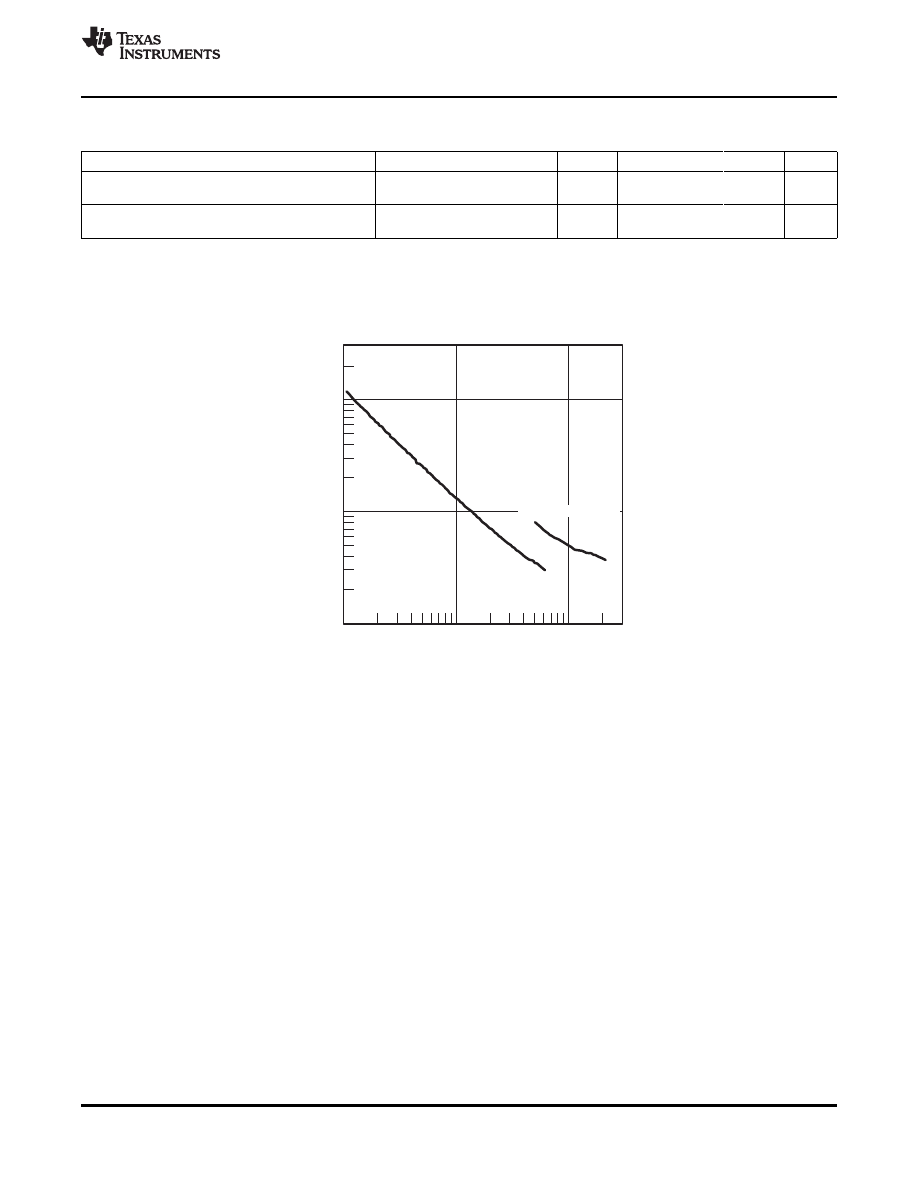
DCO Frequency − MHz
0.10
1.00
10.00
0.10
1.00
10.00
DCO W
ake
T
ime
−
µs
RSELx = 0...11
RSELx = 12...15
MSP430G2x53
MSP430G2x13
SLAS735F – APRIL 2011 – REVISED MAY 2012
Wake-Up From Lower-Power Modes (LPM3/4)
over recommended ranges of supply voltage and operating free-air temperature (unless otherwise noted)
PARAMETER
TEST CONDITIONS
V
CC
MIN
TYP
MAX
UNIT
DCO clock wake-up time from
BCSCTL1 = CALBC1_1MHz,
t
DCO,LPM3/4
3 V
1.5
µs
LPM3/4
(1)
DCOCTL = CALDCO_1MHz
1/f
MCLK
+
t
CPU,LPM3/4
CPU wake-up time from LPM3/4
(2)
t
Clock,LPM3/4
(1)
The DCO clock wake-up time is measured from the edge of an external wake-up signal (e.g., port interrupt) to the first clock edge
observable externally on a clock pin (MCLK or SMCLK).
(2)
Parameter applicable only if DCOCLK is used for MCLK.
Typical Characteristics, DCO Clock Wake-Up Time From LPM3/4
Figure 15. DCO Wake-Up Time From LPM3 vs DCO Frequency
Copyright © 2011–2012, Texas Instruments Incorporated
31
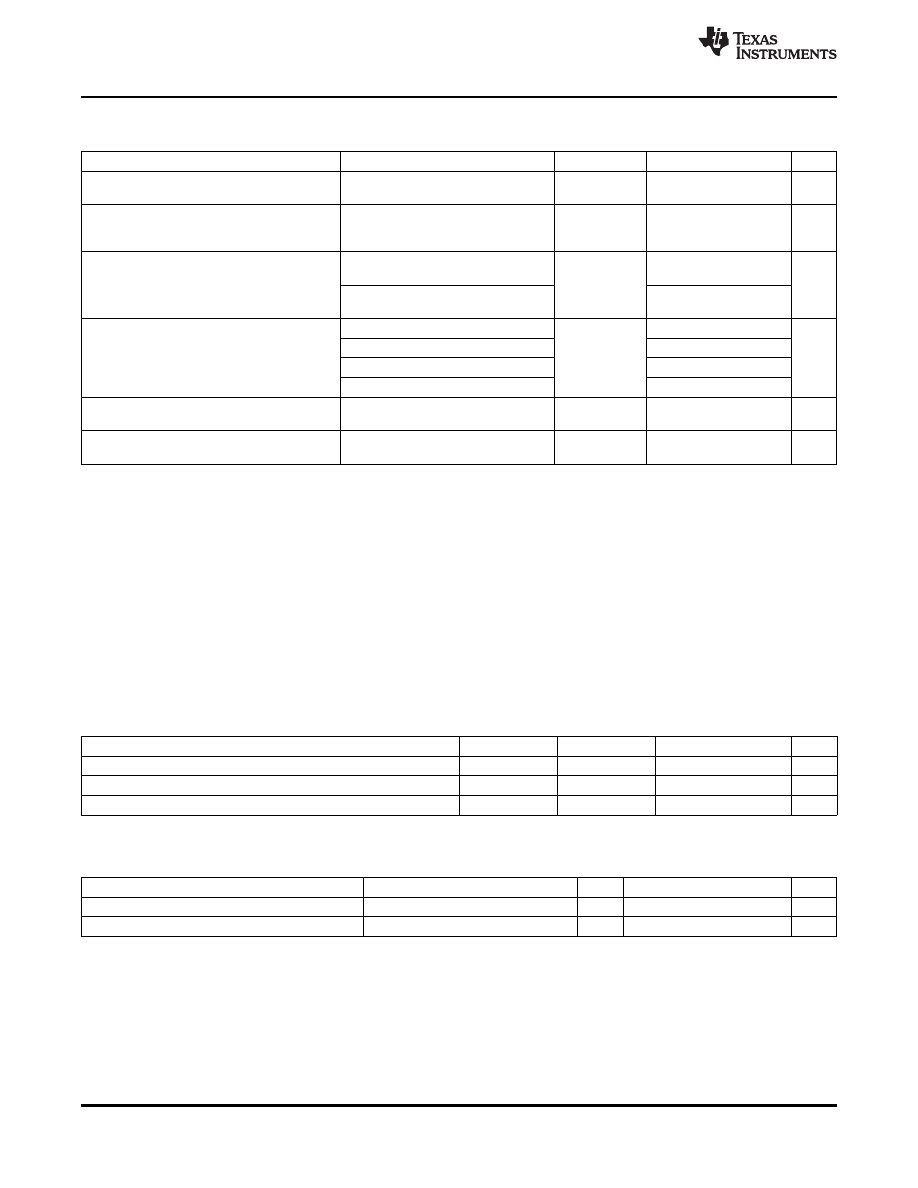
MSP430G2x53
MSP430G2x13
SLAS735F – APRIL 2011 – REVISED MAY 2012
Crystal Oscillator, XT1, Low-Frequency Mode
(1)
over recommended ranges of supply voltage and operating free-air temperature (unless otherwise noted)
PARAMETER
TEST CONDITIONS
V
CC
MIN
TYP
MAX
UNIT
LFXT1 oscillator crystal
f
LFXT1,LF
XTS = 0, LFXT1Sx = 0 or 1
1.8 V to 3.6 V
32768
Hz
frequency, LF mode 0, 1
LFXT1 oscillator logic level
f
LFXT1,LF,logic
square wave input frequency, XTS = 0, XCAPx = 0, LFXT1Sx = 3
1.8 V to 3.6 V
10000
32768
50000
Hz
LF mode
XTS = 0, LFXT1Sx = 0,
500
f
LFXT1,LF
= 32768 Hz, C
L,eff
= 6 pF
Oscillation allowance for
OA
LF
k
Ω
LF crystals
XTS = 0, LFXT1Sx = 0,
200
f
LFXT1,LF
= 32768 Hz, C
L,eff
= 12 pF
XTS = 0, XCAPx = 0
1
XTS = 0, XCAPx = 1
5.5
Integrated effective load
C
L,eff
pF
capacitance, LF mode
(2)
XTS = 0, XCAPx = 2
8.5
XTS = 0, XCAPx = 3
11
XTS = 0, Measured at P2.0/ACLK,
Duty cycle, LF mode
2.2 V
30
50
70
%
f
LFXT1,LF
= 32768 Hz
Oscillator fault frequency,
f
Fault,LF
XTS = 0, XCAPx = 0, LFXT1Sx = 3
(4)
2.2 V
10
10000
Hz
LF mode
(3)
(1)
To improve EMI on the XT1 oscillator, the following guidelines should be observed.
(a) Keep the trace between the device and the crystal as short as possible.
(b) Design a good ground plane around the oscillator pins.
(c) Prevent crosstalk from other clock or data lines into oscillator pins XIN and XOUT.
(d) Avoid running PCB traces underneath or adjacent to the XIN and XOUT pins.
(e) Use assembly materials and praxis to avoid any parasitic load on the oscillator XIN and XOUT pins.
(f) If conformal coating is used, ensure that it does not induce capacitive/resistive leakage between the oscillator pins.
(g) Do not route the XOUT line to the JTAG header to support the serial programming adapter as shown in other documentation. This
signal is no longer required for the serial programming adapter.
(2)
Includes parasitic bond and package capacitance (approximately 2 pF per pin).
Since the PCB adds additional capacitance, it is recommended to verify the correct load by measuring the ACLK frequency. For a
correct setup, the effective load capacitance should always match the specification of the used crystal.
(3)
Frequencies below the MIN specification set the fault flag. Frequencies above the MAX specification do not set the fault flag.
Frequencies in between might set the flag.
(4)
Measured with logic-level input frequency but also applies to operation with crystals.
Internal Very-Low-Power Low-Frequency Oscillator (VLO)
over recommended ranges of supply voltage and operating free-air temperature (unless otherwise noted)
PARAMETER
T
A
V
CC
MIN
TYP
MAX
UNIT
f
VLO
VLO frequency
-40°C to 85°C
3 V
4
12
20
kHz
df
VLO
/d
T
VLO frequency temperature drift
-40°C to 85°C
3 V
0.5
%/°C
df
VLO
/dV
CC
VLO frequency supply voltage drift
25°C
1.8 V to 3.6 V
4
%/V
Timer_A
over recommended ranges of supply voltage and operating free-air temperature (unless otherwise noted)
PARAMETER
TEST CONDITIONS
V
CC
MIN
TYP
MAX
UNIT
f
TA
Timer_A input clock frequency
SMCLK, duty cycle = 50% ± 10%
f
SYSTEM
MHz
t
TA,cap
Timer_A capture timing
TA0, TA1
3 V
20
ns
32
Copyright © 2011–2012, Texas Instruments Incorporated
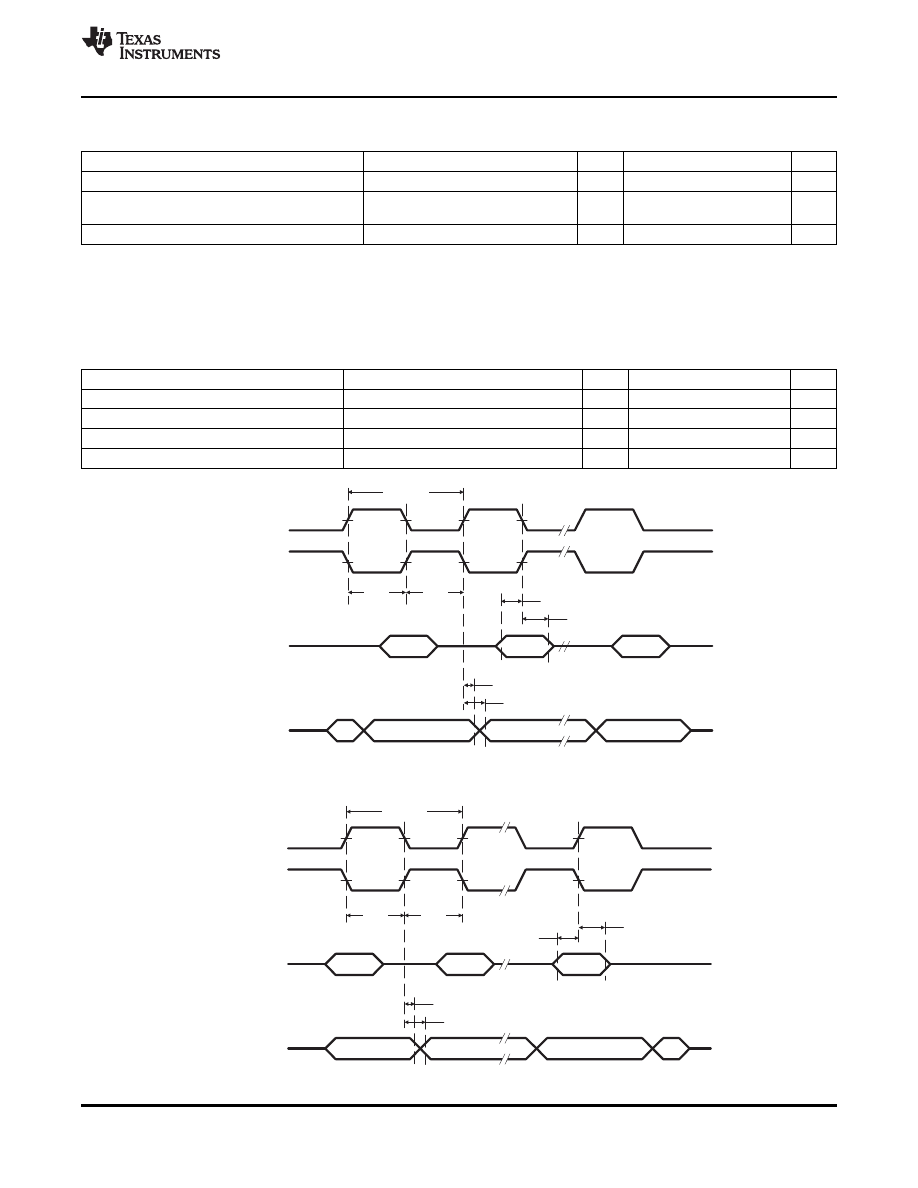
t
SU,MI
t
HD,MI
UCLK
SOMI
SIMO
t
VALID,MO
CKPL = 0
CKPL = 1
1/f
UCxCLK
t
HD,MO
t
LO/HI
t
LO/HI
t
SU,MI
t
HD,MI
UCLK
SOMI
SIMO
t
VALID,MO
t
HD,MO
CKPL = 0
CKPL = 1
t
LO/HI
t
LO/HI
1/f
UCxCLK
MSP430G2x53
MSP430G2x13
SLAS735F – APRIL 2011 – REVISED MAY 2012
USCI (UART Mode)
over recommended ranges of supply voltage and operating free-air temperature (unless otherwise noted)
PARAMETER
TEST CONDITIONS
V
CC
MIN
TYP
MAX
UNIT
f
USCI
USCI input clock frequency
SMCLK, duty cycle = 50% ± 10%
f
SYSTEM
MHz
Maximum BITCLK clock frequency
f
max,BITCLK
3 V
2
MHz
(equals baudrate in MBaud)
(1)
t
τ
UART receive deglitch time
(2)
3 V
50
100
600
ns
(1)
The DCO wake-up time must be considered in LPM3/4 for baud rates above 1 MHz.
(2)
Pulses on the UART receive input (UCxRX) shorter than the UART receive deglitch time are suppressed. To ensure that pulses are
correctly recognized, their width should exceed the maximum specification of the deglitch time.
USCI (SPI Master Mode)
over recommended ranges of supply voltage and operating free-air temperature (unless otherwise noted) (see
and
)
PARAMETER
TEST CONDITIONS
V
CC
MIN
TYP
MAX
UNIT
f
USCI
USCI input clock frequency
SMCLK, duty cycle = 50% ± 10%
f
SYSTEM
MHz
t
SU,MI
SOMI input data setup time
3 V
75
ns
t
HD,MI
SOMI input data hold time
3 V
0
ns
t
VALID,MO
SIMO output data valid time
UCLK edge to SIMO valid, C
L
= 20 pF
3 V
20
ns
Figure 16. SPI Master Mode, CKPH = 0
Figure 17. SPI Master Mode, CKPH = 1
Copyright © 2011–2012, Texas Instruments Incorporated
33
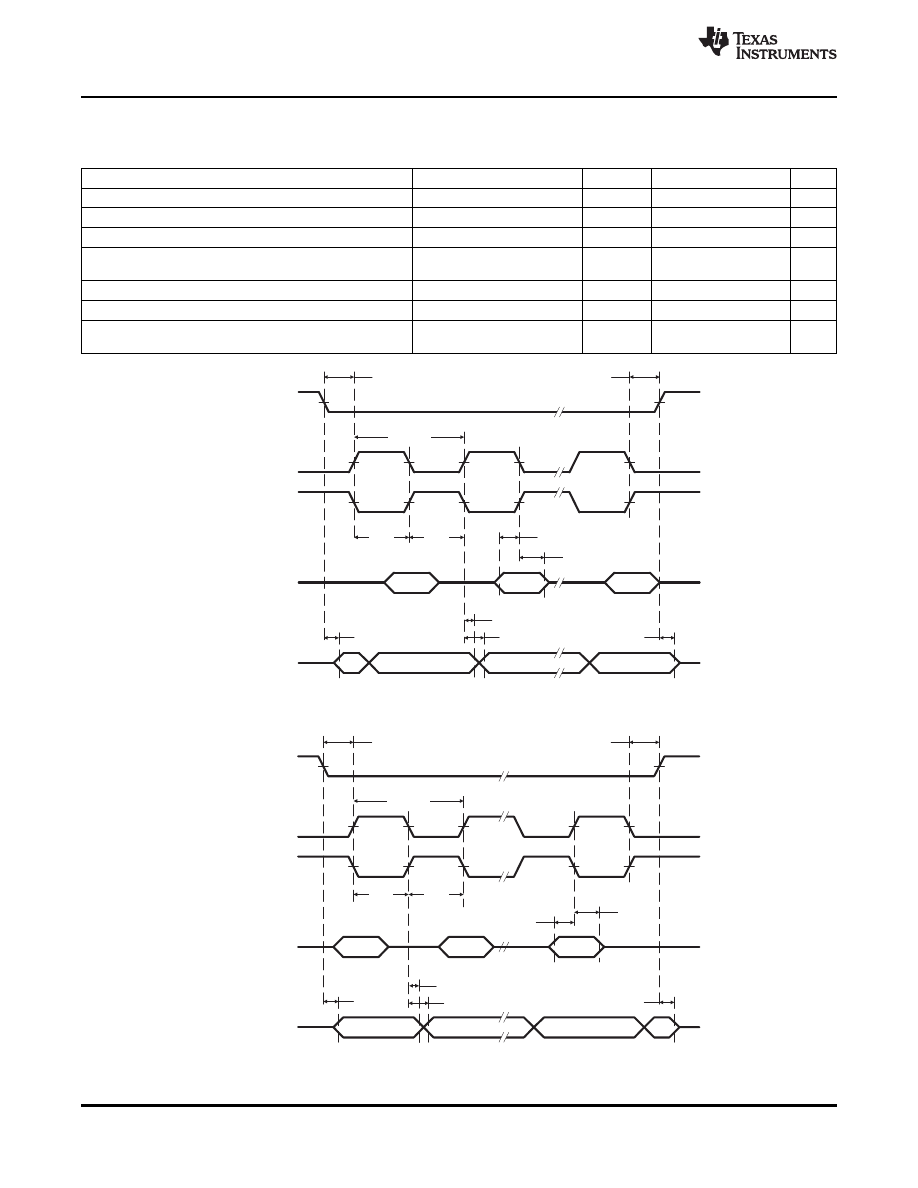
STE
UCLK
CKPL = 0
CKPL = 1
SOMI
SIMO
t
SU,SI
t
HD,SI
t
VALID,SO
t
STE,LEAD
1/f
UCxCLK
t
STE,LAG
t
STE,DIS
t
STE,ACC
t
HD,MO
t
LO/HI
t
LO/HI
STE
UCLK
CKPL = 0
CKPL = 1
SOMI
SIMO
t
SU,SI
t
HD,SI
t
VALID,SO
t
STE,LEAD
1/f
UCxCLK
t
LO/HI
t
LO/HI
t
STE,LAG
t
STE,DIS
t
STE,ACC
t
HD,SO
MSP430G2x53
MSP430G2x13
SLAS735F – APRIL 2011 – REVISED MAY 2012
USCI (SPI Slave Mode)
over recommended ranges of supply voltage and operating free-air temperature (unless otherwise noted) (see
and
)
PARAMETER
TEST CONDITIONS
V
CC
MIN
TYP
MAX
UNIT
t
STE,LEAD
STE lead time, STE low to clock
3 V
50
ns
t
STE,LAG
STE lag time, Last clock to STE high
3 V
10
ns
t
STE,ACC
STE access time, STE low to SOMI data out
3 V
50
ns
STE disable time, STE high to SOMI high
t
STE,DIS
3 V
50
ns
impedance
t
SU,SI
SIMO input data setup time
3 V
15
ns
t
HD,SI
SIMO input data hold time
3 V
10
ns
UCLK edge to SOMI valid,
t
VALID,SO
SOMI output data valid time
3 V
50
75
ns
C
L
= 20 pF
Figure 18. SPI Slave Mode, CKPH = 0
Figure 19. SPI Slave Mode, CKPH = 1
34
Copyright © 2011–2012, Texas Instruments Incorporated
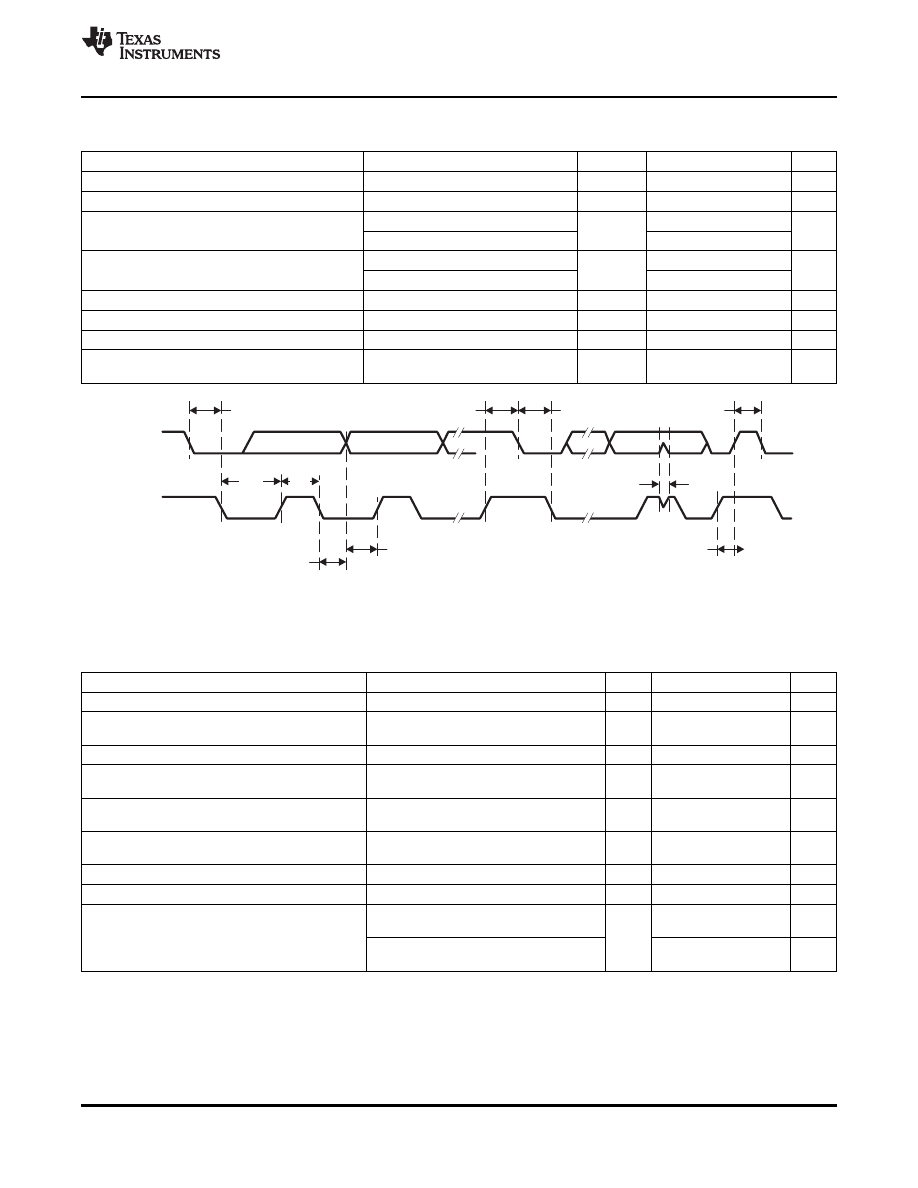
SDA
SCL
t
HD,DAT
t
SU,DAT
t
HD,STA
t
HIGH
t
LOW
t
BUF
t
HD,STA
t
SU,STA
t
SP
t
SU,STO
MSP430G2x53
MSP430G2x13
SLAS735F – APRIL 2011 – REVISED MAY 2012
USCI (I2C Mode)
over recommended ranges of supply voltage and operating free-air temperature (unless otherwise noted) (see
PARAMETER
TEST CONDITIONS
V
CC
MIN
TYP
MAX
UNIT
f
USCI
USCI input clock frequency
SMCLK, duty cycle = 50% ± 10%
f
SYSTEM
MHz
f
SCL
SCL clock frequency
3 V
0
400
kHz
f
SCL
≤
100 kHz
4.0
t
HD,STA
Hold time (repeated) START
3 V
µs
f
SCL
> 100 kHz
0.6
f
SCL
≤
100 kHz
4.7
t
SU,STA
Setup time for a repeated START
3 V
µs
f
SCL
> 100 kHz
0.6
t
HD,DAT
Data hold time
3 V
0
ns
t
SU,DAT
Data setup time
3 V
250
ns
t
SU,STO
Setup time for STOP
3 V
4.0
µs
Pulse width of spikes suppressed by
t
SP
3 V
50
100
600
ns
input filter
Figure 20. I2C Mode Timing
Comparator_A+
over recommended ranges of supply voltage and operating free-air temperature (unless otherwise noted)
PARAMETER
TEST CONDITIONS
V
CC
MIN
TYP
MAX
UNIT
I
(DD)
(1)
CAON = 1, CARSEL = 0, CAREF = 0
3 V
45
µA
I
(Refladder/
CAON = 1, CARSEL = 0, CAREF = 1/2/3,
3 V
45
µA
RefDiode)
No load at CA0 and CA1
V
(IC)
Common–mode input voltage
CAON = 1
3 V
0
V
CC
-1
V
PCA0 = 1, CARSEL = 1, CAREF = 1,
V
(Ref025)
(Voltage at 0.25 V
CC
node) / V
CC
3 V
0.24
No load at CA0 and CA1
PCA0 = 1, CARSEL = 1, CAREF = 2,
V
(Ref050)
(Voltage at 0.5 V
CC
node) / V
CC
3 V
0.48
No load at CA0 and CA1
PCA0 = 1, CARSEL = 1, CAREF = 3,
V
(RefVT)
See
and
3 V
490
mV
No load at CA0 and CA1, TA = 85°C
V
(offset)
Offset voltage
(2)
3 V
±10
mV
V
hys
Input hysteresis
CAON = 1
3 V
0.7
mV
T
A
= 25°C, Overdrive 10 mV,
120
ns
Without filter: CAF = 0
Response time
t
(response)
3 V
(low-high and high-low)
T
A
= 25°C, Overdrive 10 mV,
1.5
µs
With filter: CAF = 1
(1)
The leakage current for the Comparator_A+ terminals is identical to I
lkg(Px.y)
specification.
(2)
The input offset voltage can be cancelled by using the CAEX bit to invert the Comparator_A+ inputs on successive measurements. The
two successive measurements are then summed together.
Copyright © 2011–2012, Texas Instruments Incorporated
35
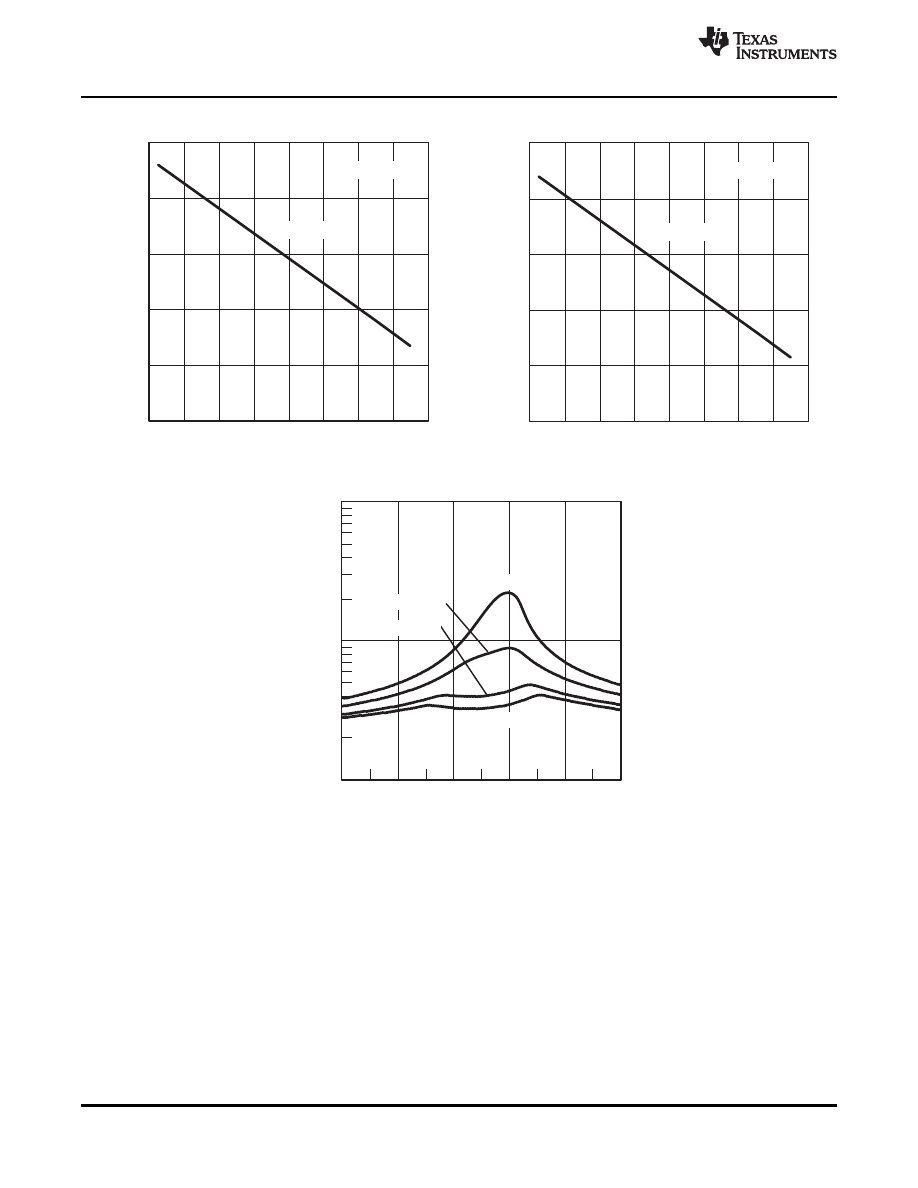
V /V
– Normalized Input Voltage – V/V
IN
CC
1
10
100
0
S
h
o
rt R
e
s
is
ta
n
c
e
–
kW
V
= 1.8 V
CC
V
= 3.6 V
CC
V
= 2.2 V
CC
V
= 3 V
CC
0.2
0.4
0.6
0.8
1
T – Free-Air Temperature – °C
A
400
450
500
550
600
650
V
= 3 V
CC
V
–
Reference V
oltage
–
mV
(R
efVT)
Typical
-45
-25
-5
15
35
55
75
95
115
400
450
500
550
600
650
V
= 2.2 V
CC
Typical
T – Free-Air Temperature – °C
A
V
–
Reference V
oltage
–
mV
(R
efVT)
-45
-25
-5
15
35
55
75
95
115
MSP430G2x53
MSP430G2x13
SLAS735F – APRIL 2011 – REVISED MAY 2012
Typical Characteristics – Comparator_A+
Figure 21. V
(RefVT)
vs Temperature, V
CC
= 3 V
Figure 22. V
(RefVT)
vs Temperature, V
CC
= 2.2 V
Figure 23. Short Resistance vs V
IN
/V
CC
36
Copyright © 2011–2012, Texas Instruments Incorporated

MSP430G2x53
MSP430G2x13
SLAS735F – APRIL 2011 – REVISED MAY 2012
10-Bit ADC, Power Supply and Input Range Conditions (MSP430G2x53 Only)
over recommended ranges of supply voltage and operating free-air temperature (unless otherwise noted)
(1)
PARAMETER
TEST CONDITIONS
T
A
V
CC
MIN
TYP
MAX
UNIT
V
CC
Analog supply voltage
V
SS
= 0 V
2.2
3.6
V
All Ax terminals, Analog inputs
V
Ax
Analog input voltage
(2)
3 V
0
V
CC
V
selected in ADC10AE register
f
ADC10CLK
= 5.0 MHz,
ADC10ON = 1, REFON = 0,
I
ADC10
ADC10 supply current
(3)
25°C
3 V
0.6
mA
ADC10SHT0 = 1, ADC10SHT1 = 0,
ADC10DIV = 0
f
ADC10CLK
= 5.0 MHz,
ADC10ON = 0, REF2_5V = 0,
0.25
REFON = 1, REFOUT = 0
Reference supply current,
I
REF+
25°C
3 V
mA
reference buffer disabled
(4)
f
ADC10CLK
= 5.0 MHz,
ADC10ON = 0, REF2_5V = 1,
0.25
REFON = 1, REFOUT = 0
f
ADC10CLK
= 5.0 MHz,
Reference buffer supply
ADC10ON = 0, REFON = 1,
I
REFB,0
25°C
3 V
1.1
mA
current with ADC10SR = 0
(4)
REF2_5V = 0, REFOUT = 1,
ADC10SR = 0
f
ADC10CLK
= 5.0 MHz,
Reference buffer supply
ADC10ON = 0, REFON = 1,
I
REFB,1
25°C
3 V
0.5
mA
current with ADC10SR = 1
(4)
REF2_5V = 0, REFOUT = 1,
ADC10SR = 1
Only one terminal Ax can be selected
C
I
Input capacitance
25°C
3 V
27
pF
at one time
R
I
Input MUX ON resistance
0 V
≤
V
Ax
≤
V
CC
25°C
3 V
1000
Ω
(1)
The leakage current is defined in the leakage current table with Px.y/Ax parameter.
(2)
The analog input voltage range must be within the selected reference voltage range V
R+
to V
R–
for valid conversion results.
(3)
The internal reference supply current is not included in current consumption parameter I
ADC10
.
(4)
The internal reference current is supplied via terminal V
CC
. Consumption is independent of the ADC10ON control bit, unless a
conversion is active. The REFON bit enables the built-in reference to settle before starting an A/D conversion.
Copyright © 2011–2012, Texas Instruments Incorporated
37

MSP430G2x53
MSP430G2x13
SLAS735F – APRIL 2011 – REVISED MAY 2012
10-Bit ADC, Built-In Voltage Reference (MSP430G2x53 Only)
over recommended ranges of supply voltage and operating free-air temperature (unless otherwise noted)
PARAMETER
TEST CONDITIONS
V
CC
MIN
TYP
MAX
UNIT
I
VREF+
≤
1 mA, REF2_5V = 0
2.2
Positive built-in reference
V
CC,REF+
V
analog supply voltage range I
VREF+
≤
1 mA, REF2_5V = 1
2.9
I
VREF+
≤
I
VREF+
max, REF2_5V = 0
1.41
1.5
1.59
Positive built-in reference
V
REF+
3 V
V
voltage
I
VREF+
≤
I
VREF+
max, REF2_5V = 1
2.35
2.5
2.65
Maximum VREF+ load
I
LD,VREF+
3 V
±1
mA
current
I
VREF+
= 500 µA ± 100 µA,
Analog input voltage V
Ax
≉
0.75 V,
±2
REF2_5V = 0
VREF+ load regulation
3 V
LSB
I
VREF+
= 500 µA ± 100 µA,
Analog input voltage V
Ax
≉
1.25 V,
±2
REF2_5V = 1
I
VREF+
= 100 µA
→
900 µA,
V
REF+
load regulation
V
Ax
≉
0.5 × VREF+,
3 V
400
ns
response time
Error of conversion result
≤
1 LSB,
ADC10SR = 0
Maximum capacitance at
C
VREF+
I
VREF+
≤
±1 mA, REFON = 1, REFOUT = 1
3 V
100
pF
pin VREF+
ppm/
TC
REF+
Temperature coefficient
(1)
I
VREF+
= const with 0 mA
≤
I
VREF+
≤
1 mA
3 V
±100
°C
Settling time of internal
I
VREF+
= 0.5 mA, REF2_5V = 0,
t
REFON
reference voltage to 99.9%
3.6 V
30
µs
REFON = 0
→
1
VREF
I
VREF+
= 0.5 mA,
Settling time of reference
t
REFBURST
REF2_5V = 1, REFON = 1,
3 V
2
µs
buffer to 99.9% VREF
REFBURST = 1, ADC10SR = 0
(1)
Calculated using the box method: (MAX(-40 to 85°C) – MIN(-40 to 85°C)) / MIN(-40 to 85°C) / (85°C – (–40°C))
38
Copyright © 2011–2012, Texas Instruments Incorporated
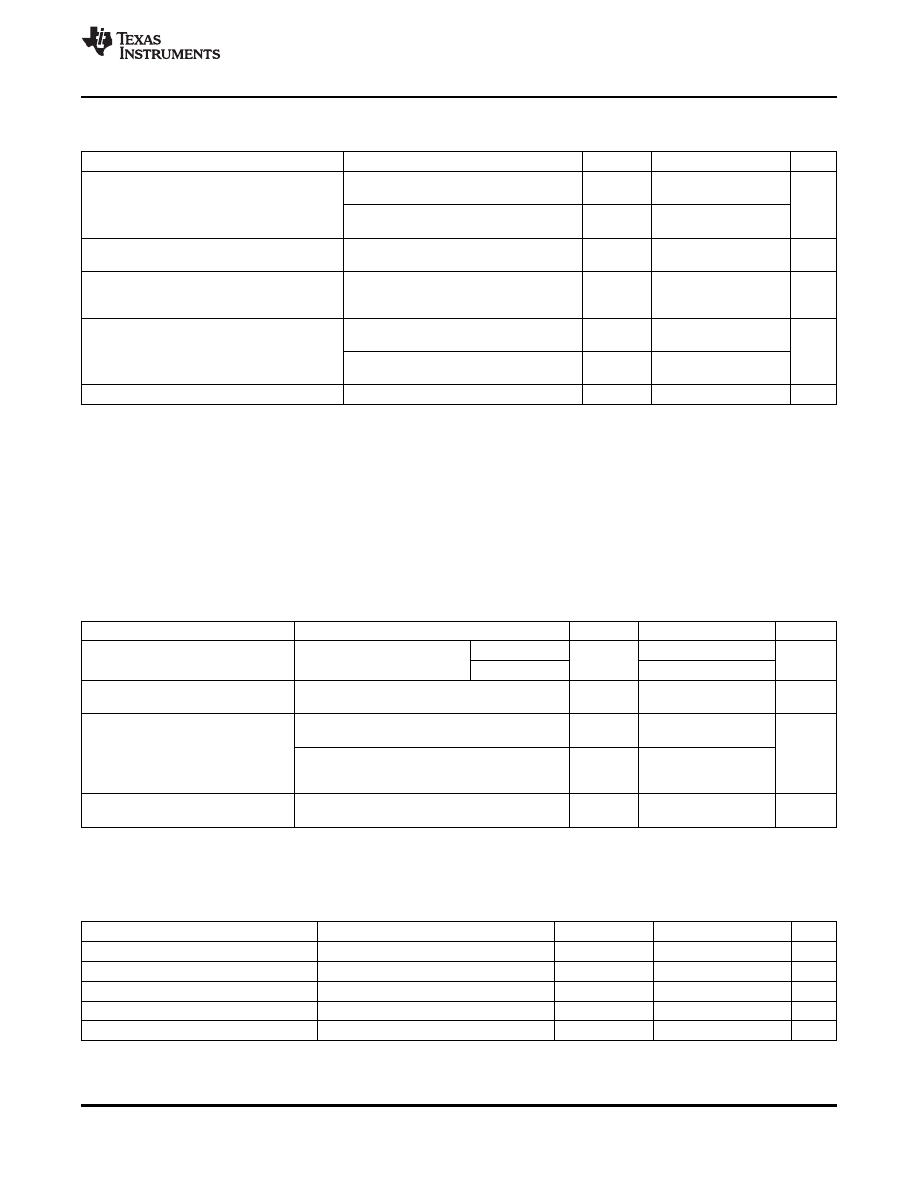
MSP430G2x53
MSP430G2x13
SLAS735F – APRIL 2011 – REVISED MAY 2012
10-Bit ADC, External Reference
(1)
(MSP430G2x53 Only)
over recommended ranges of supply voltage and operating free-air temperature (unless otherwise noted)
PARAMETER
TEST CONDITIONS
V
CC
MIN
TYP
MAX
UNIT
VEREF+ > VEREF–,
1.4
V
CC
SREF1 = 1, SREF0 = 0
Positive external reference input
VEREF+
V
voltage range
(2)
VEREF–
≤
VEREF+
≤
V
CC
– 0.15 V,
1.4
3
SREF1 = 1, SREF0 = 1
(3)
Negative external reference input
VEREF–
VEREF+ > VEREF–
0
1.2
V
voltage range
(4)
Differential external reference
Δ
VEREF
input voltage range,
VEREF+ > VEREF–
(5)
1.4
V
CC
V
Δ
VEREF = VEREF+ – VEREF–
0 V
≤
VEREF+
≤
V
CC
,
3 V
±1
SREF1 = 1, SREF0 = 0
I
VEREF+
Static input current into VEREF+
µA
0 V
≤
VEREF+
≤
V
CC
– 0.15 V
≤
3 V,
3 V
0
SREF1 = 1, SREF0 = 1
(3)
I
VEREF–
Static input current into VEREF–
0 V
≤
VEREF–
≤
V
CC
3 V
±1
µA
(1)
The external reference is used during conversion to charge and discharge the capacitance array. The input capacitance, C
I
, is also the
dynamic load for an external reference during conversion. The dynamic impedance of the reference supply should follow the
recommendations on analog-source impedance to allow the charge to settle for 10-bit accuracy.
(2)
The accuracy limits the minimum positive external reference voltage. Lower reference voltage levels may be applied with reduced
accuracy requirements.
(3)
Under this condition the external reference is internally buffered. The reference buffer is active and requires the reference buffer supply
current I
REFB
. The current consumption can be limited to the sample and conversion period with REBURST = 1.
(4)
The accuracy limits the maximum negative external reference voltage. Higher reference voltage levels may be applied with reduced
accuracy requirements.
(5)
The accuracy limits the minimum external differential reference voltage. Lower differential reference voltage levels may be applied with
reduced accuracy requirements.
10-Bit ADC, Timing Parameters (MSP430G2x53 Only)
over recommended ranges of supply voltage and operating free-air temperature (unless otherwise noted)
PARAMETER
TEST CONDITIONS
V
CC
MIN
TYP
MAX
UNIT
ADC10SR = 0
0.45
6.3
ADC10 input clock
For specified performance of
f
ADC10CLK
3 V
MHz
frequency
ADC10 linearity parameters
ADC10SR = 1
0.45
1.5
ADC10 built-in oscillator
ADC10DIVx = 0, ADC10SSELx = 0,
f
ADC10OSC
3 V
3.7
6.3
MHz
frequency
f
ADC10CLK
= f
ADC10OSC
ADC10 built-in oscillator, ADC10SSELx = 0,
3 V
2.06
3.51
f
ADC10CLK
= f
ADC10OSC
t
CONVERT
Conversion time
µs
13 ×
f
ADC10CLK
from ACLK, MCLK, or SMCLK:
ADC10DIV ×
ADC10SSELx
≠
0
1/f
ADC10CLK
Turn-on settling time of
t
ADC10ON
(1)
100
ns
the ADC
(1)
The condition is that the error in a conversion started after t
ADC10ON
is less than ±0.5 LSB. The reference and input signal are already
settled.
10-Bit ADC, Linearity Parameters (MSP430G2x53 Only)
over recommended ranges of supply voltage and operating free-air temperature (unless otherwise noted)
PARAMETER
TEST CONDITIONS
V
CC
MIN
TYP
MAX
UNIT
E
I
Integral linearity error
3 V
±1
LSB
E
D
Differential linearity error
3 V
±1
LSB
E
O
Offset error
Source impedance R
S
< 100
Ω
3 V
±1
LSB
E
G
Gain error
3 V
±1.1
±2
LSB
E
T
Total unadjusted error
3 V
±2
±5
LSB
Copyright © 2011–2012, Texas Instruments Incorporated
39
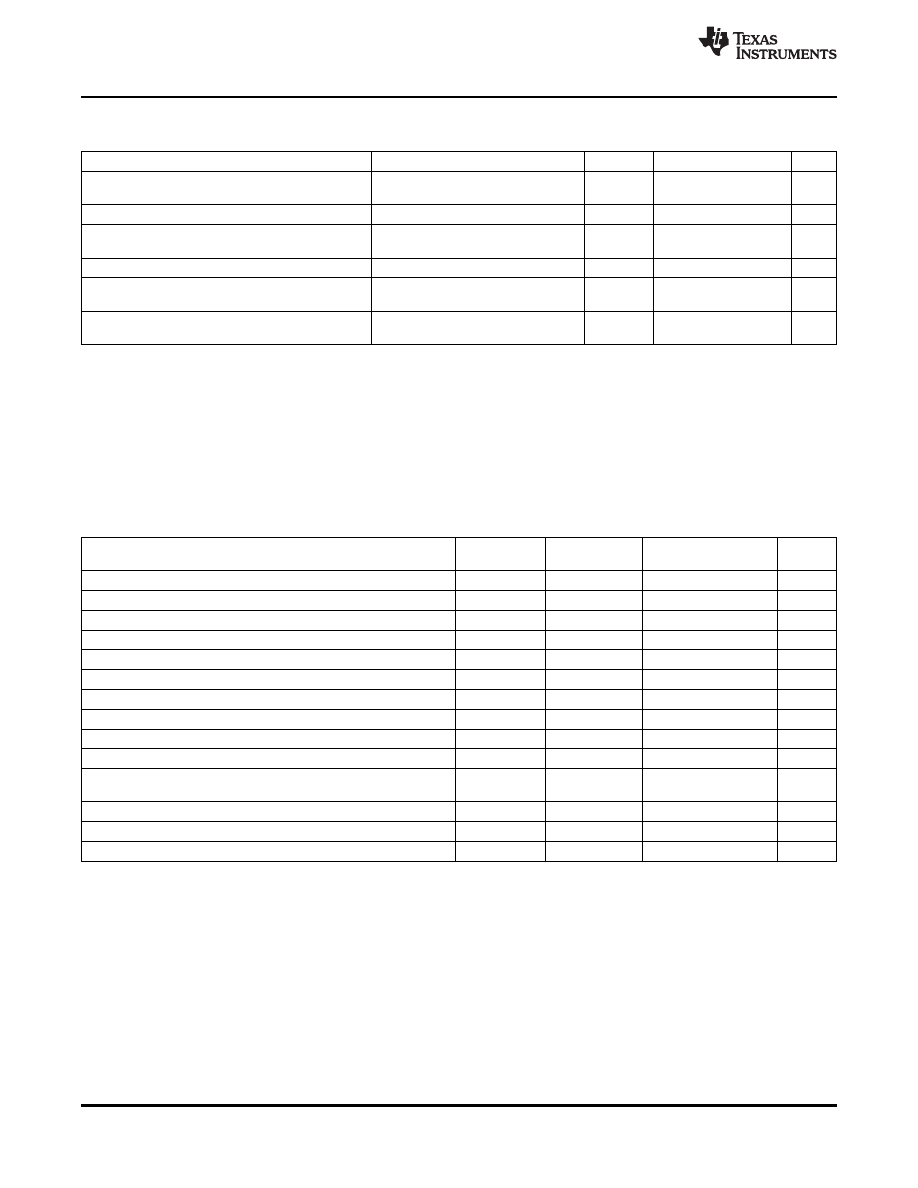
MSP430G2x53
MSP430G2x13
SLAS735F – APRIL 2011 – REVISED MAY 2012
10-Bit ADC, Temperature Sensor and Built-In V
MID
(MSP430G2x53 Only)
over recommended ranges of supply voltage and operating free-air temperature (unless otherwise noted)
PARAMETER
TEST CONDITIONS
V
CC
MIN
TYP
MAX
UNIT
Temperature sensor supply
REFON = 0, INCHx = 0Ah,
I
SENSOR
3 V
60
µA
current
(1)
T
A
= 25°C
TC
SENSOR
ADC10ON = 1, INCHx = 0Ah
(2)
3 V
3.55
mV/°C
Sample time required if channel
ADC10ON = 1, INCHx = 0Ah,
t
Sensor(sample)
3 V
30
µs
10 is selected
(3)
Error of conversion result
≤
1 LSB
I
VMID
Current into divider at channel 11
ADC10ON = 1, INCHx = 0Bh
3 V
(4)
µA
ADC10ON = 1, INCHx = 0Bh,
V
MID
V
CC
divider at channel 11
3 V
1.5
V
V
MID
≉
0.5 × V
CC
Sample time required if channel
ADC10ON = 1, INCHx = 0Bh,
t
VMID(sample)
3 V
1220
ns
11 is selected
(5)
Error of conversion result
≤
1 LSB
(1)
The sensor current I
SENSOR
is consumed if (ADC10ON = 1 and REFON = 1) or (ADC10ON = 1 and INCH = 0Ah and sample signal is
high). When REFON = 1, I
SENSOR
is included in I
REF+
. When REFON = 0, I
SENSOR
applies during conversion of the temperature sensor
input (INCH = 0Ah).
(2)
The following formula can be used to calculate the temperature sensor output voltage:
V
Sensor,typ
= TC
Sensor
(273 + T [°C] ) + V
Offset,sensor
[mV] or
V
Sensor,typ
= TC
Sensor
T [°C] + V
Sensor
(T
A
= 0°C) [mV]
(3)
The typical equivalent impedance of the sensor is 51 k
Ω
. The sample time required includes the sensor-on time t
SENSOR(on)
.
(4)
No additional current is needed. The V
MID
is used during sampling.
(5)
The on-time t
VMID(on)
is included in the sampling time t
VMID(sample)
; no additional on time is needed.
Flash Memory
over recommended ranges of supply voltage and operating free-air temperature (unless otherwise noted)
PARAMETER
TEST
V
CC
MIN
TYP
MAX
UNIT
CONDITIONS
V
CC(PGM/ERASE)
Program and erase supply voltage
2.2
3.6
V
f
FTG
Flash timing generator frequency
257
476
kHz
I
PGM
Supply current from V
CC
during program
2.2 V/3.6 V
1
5
mA
I
ERASE
Supply current from V
CC
during erase
2.2 V/3.6 V
1
7
mA
t
CPT
Cumulative program time
(1)
2.2 V/3.6 V
10
ms
t
CMErase
Cumulative mass erase time
2.2 V/3.6 V
20
ms
Program/erase endurance
10
4
10
5
cycles
t
Retention
Data retention duration
T
J
= 25°C
100
years
t
Word
Word or byte program time
(2)
30
t
FTG
t
Block, 0
Block program time for first byte or word
(2)
25
t
FTG
Block program time for each additional byte or
t
Block, 1-63
(2)
18
t
FTG
word
t
Block, End
Block program end-sequence wait time
(2)
6
t
FTG
t
Mass Erase
Mass erase time
(2)
10593
t
FTG
t
Seg Erase
Segment erase time
(2)
4819
t
FTG
(1)
The cumulative program time must not be exceeded when writing to a 64-byte flash block. This parameter applies to all programming
methods: individual word/byte write and block write modes.
(2)
These values are hardwired into the Flash Controller's state machine (t
FTG
= 1/f
FTG
).
40
Copyright © 2011–2012, Texas Instruments Incorporated
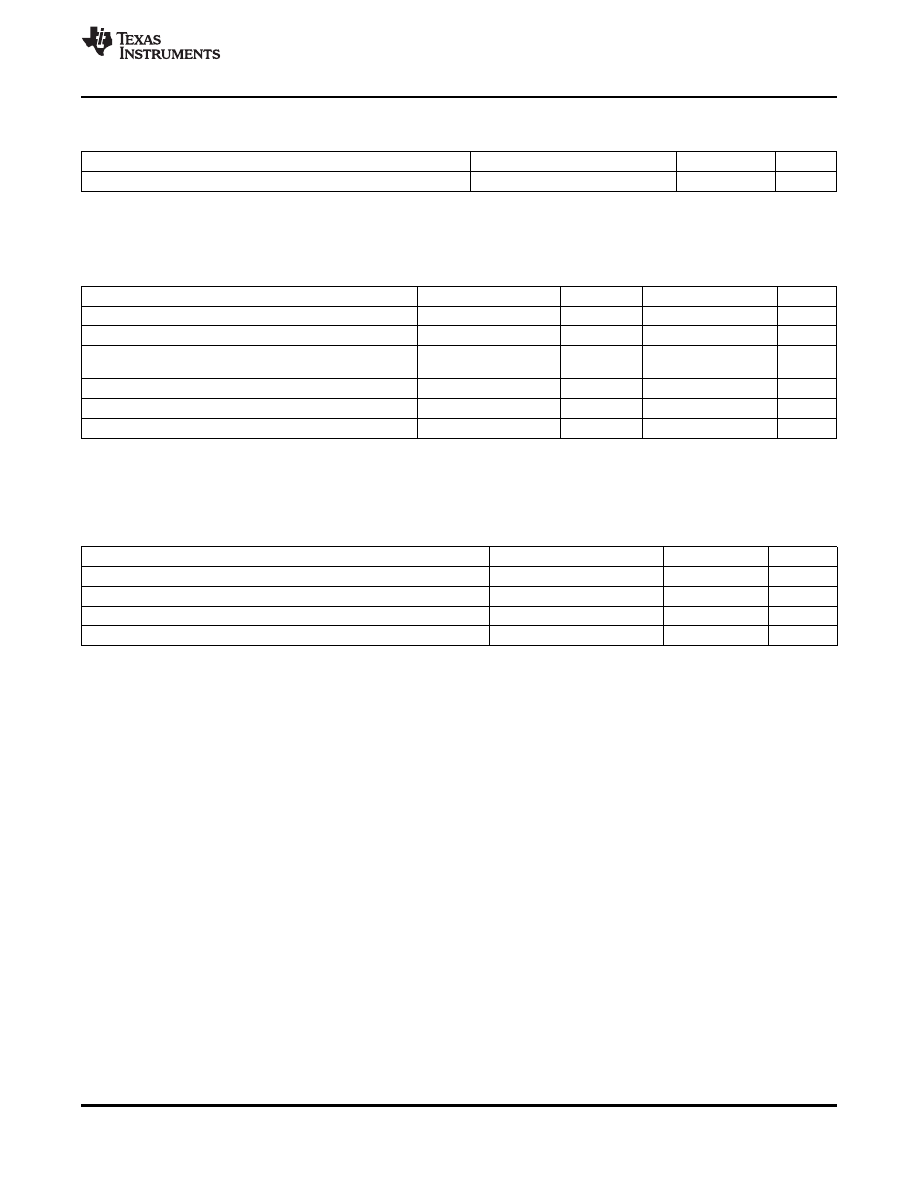
MSP430G2x53
MSP430G2x13
SLAS735F – APRIL 2011 – REVISED MAY 2012
RAM
over recommended ranges of supply voltage and operating free-air temperature (unless otherwise noted)
PARAMETER
TEST CONDITIONS
MIN
MAX
UNIT
V
(RAMh)
RAM retention supply voltage
(1)
CPU halted
1.6
V
(1)
This parameter defines the minimum supply voltage V
CC
when the data in RAM remains unchanged. No program execution should
happen during this supply voltage condition.
JTAG and Spy-Bi-Wire Interface
over recommended ranges of supply voltage and operating free-air temperature (unless otherwise noted)
PARAMETER
TEST CONDITIONS
V
CC
MIN
TYP
MAX
UNIT
f
SBW
Spy-Bi-Wire input frequency
2.2 V
0
20
MHz
t
SBW,Low
Spy-Bi-Wire low clock pulse length
2.2 V
0.025
15
µs
Spy-Bi-Wire enable time
t
SBW,En
2.2 V
1
µs
(TEST high to acceptance of first clock edge
(1)
)
t
SBW,Ret
Spy-Bi-Wire return to normal operation time
2.2 V
15
100
µs
f
TCK
TCK input frequency
(2)
2.2 V
0
5
MHz
R
Internal
Internal pulldown resistance on TEST
2.2 V
25
60
90
k
Ω
(1)
Tools accessing the Spy-Bi-Wire interface need to wait for the maximum t
SBW,En
time after pulling the TEST/SBWCLK pin high before
applying the first SBWCLK clock edge.
(2)
f
TCK
may be restricted to meet the timing requirements of the module selected.
JTAG Fuse
(1)
over recommended ranges of supply voltage and operating free-air temperature (unless otherwise noted)
PARAMETER
TEST CONDITIONS
MIN
MAX
UNIT
V
CC(FB)
Supply voltage during fuse-blow condition
T
A
= 25°C
2.5
V
V
FB
Voltage level on TEST for fuse blow
6
7
V
I
FB
Supply current into TEST during fuse blow
100
mA
t
FB
Time to blow fuse
1
ms
(1)
Once the fuse is blown, no further access to the JTAG/Test, Spy-Bi-Wire, and emulation feature is possible, and JTAG is switched to
bypass mode.
Copyright © 2011–2012, Texas Instruments Incorporated
41
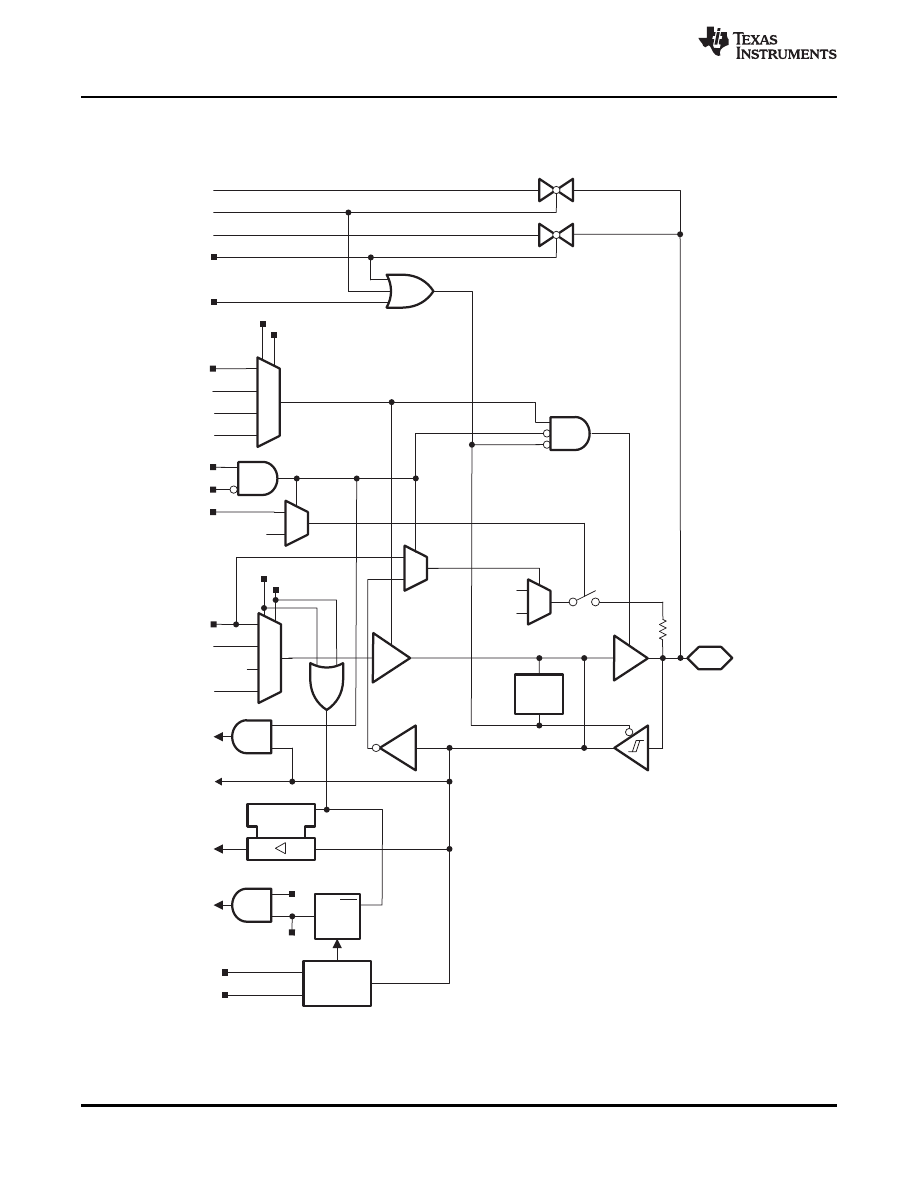
PxDIR.y
From Timer
P1.0/TA0CLK/ACLK/
A0*/CA0
P1.1/TA0.0/UCA0RXD/
UCA0SOMI/A1*/CA1
P1.2/TA0.1/UCA0TXD/
UCA0SIMO/A2*/CA2
From USCI
1
* Note: MSP430G2x53 devices only. MSP430G2x13 devices have no ADC10.
To Module
From Timer
PxOUT.y
DVSS
DVCC
1
TAx.y
TAxCLK
Bus
Keeper
EN
1
0
PxIN.y
EN
D
PxSEL.y
PxREN.y
1
0
PxSEL2.y
1
0
INCHx = y *
To ADC10 *
PxSEL.y
1
3
2
1
0
PxSEL2.y
PxIRQ.y
PxIE.y
EN
Set
Q
Interrupt
Edge
Select
PxSEL.y
PxIES.y
PxIFG.y
Direction
0: Input
1: Output
PxSEL.y
3
2
1
0
PxSEL2.y
From Comparator
To Comparator
CAPD.y
or ADC10AE0.y *
0
MSP430G2x53
MSP430G2x13
SLAS735F – APRIL 2011 – REVISED MAY 2012
PORT SCHEMATICS
Port P1 Pin Schematic: P1.0 to P1.2, Input/Output With Schmitt Trigger
42
Copyright © 2011–2012, Texas Instruments Incorporated
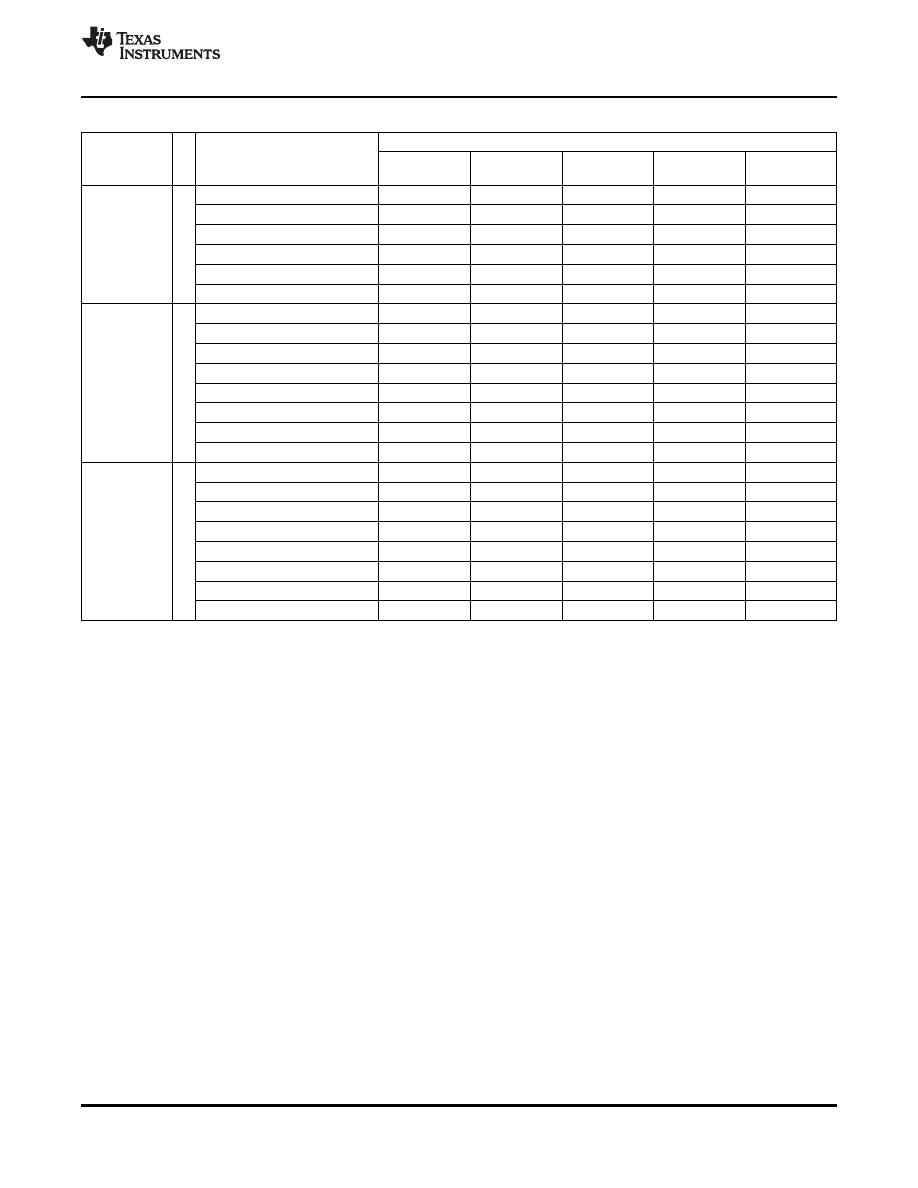
MSP430G2x53
MSP430G2x13
SLAS735F – APRIL 2011 – REVISED MAY 2012
Table 16. Port P1 (P1.0 to P1.2) Pin Functions
CONTROL BITS / SIGNALS
(1)
PIN NAME
x
FUNCTION
ADC10AE.x
(P1.x)
P1DIR.x
P1SEL.x
P1SEL2.x
CAPD.y
INCH.x=1
(2)
P1.0/
P1.x (I/O)
I: 0; O: 1
0
0
0
0
TA0CLK/
TA0.TACLK
0
1
0
0
0
ACLK/
ACLK
1
1
0
0
0
0
A0
(2)
/
A0
X
X
X
1 (y = 0)
0
CA0/
CA0
X
X
X
0
1 (y = 0)
Pin Osc
Capacitive sensing
X
0
1
0
0
P1.1/
P1.x (I/O)
I: 0; O: 1
0
0
0
0
TA0.0/
TA0.0
1
1
0
0
0
TA0.CCI0A
0
1
0
0
0
UCA0RXD/
UCA0RXD
from USCI
1
1
0
0
1
UCA0SOMI/
UCA0SOMI
from USCI
1
1
0
0
A1
(2)
/
A1
X
X
X
1 (y = 1)
0
CA1/
CA1
X
X
X
0
1 (y = 1)
Pin Osc
Capacitive sensing
X
0
1
0
0
P1.2/
P1.x (I/O)
I: 0; O: 1
0
0
0
0
TA0.1/
TA0.1
1
1
0
0
0
TA0.CCI1A
0
1
0
0
0
UCA0TXD/
UCA0TXD
from USCI
1
1
0
0
2
UCA0SIMO/
UCA0SIMO
from USCI
1
1
0
0
A2
(2)
/
A2
X
X
X
1 (y = 2)
0
CA2/
CA2
X
X
X
0
1 (y = 2)
Pin Osc
Capacitive sensing
X
0
1
0
0
(1)
X = don't care
(2)
MSP430G2x53 devices only
Copyright © 2011–2012, Texas Instruments Incorporated
43
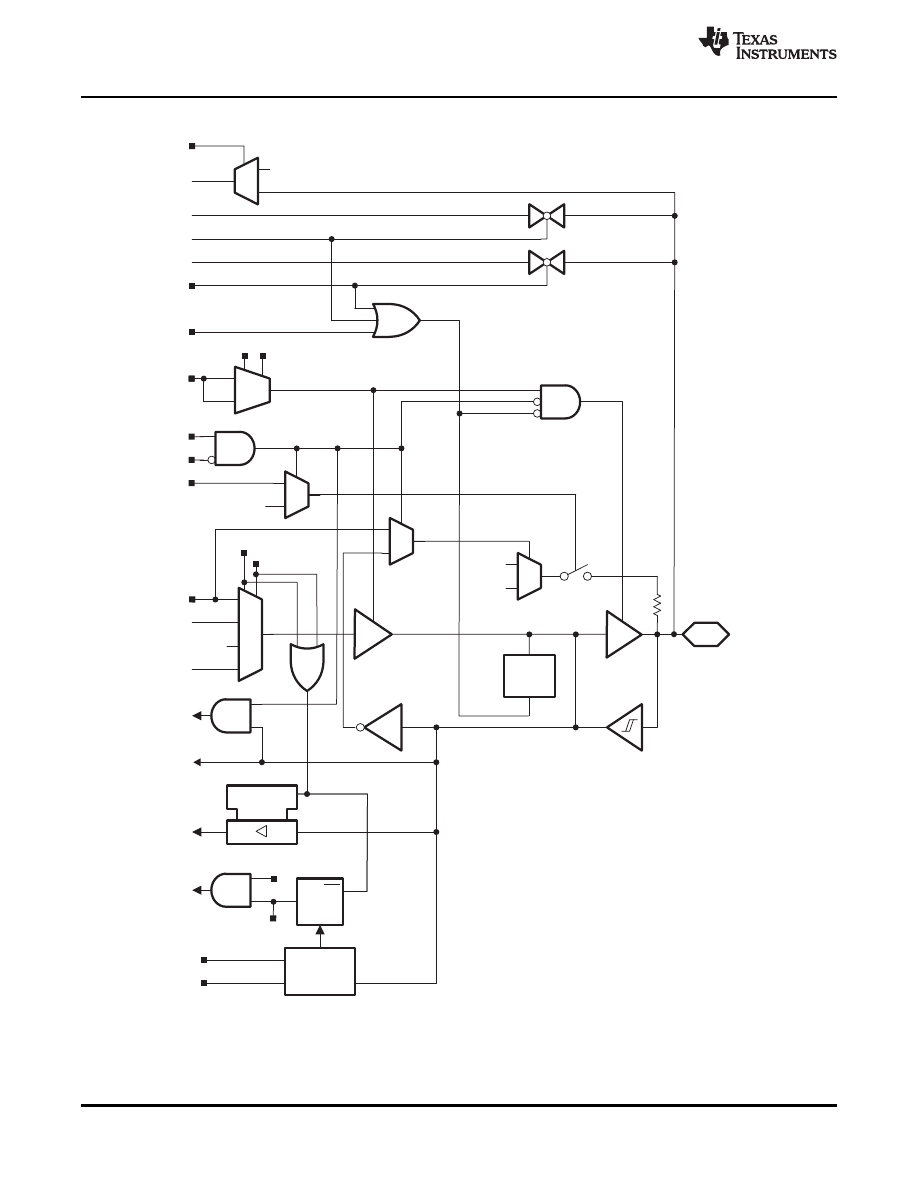
* Note: MSP430G2x53 devices only. MSP430G2x13 devices have no ADC10.
P1.3/ADC10CLK*/CAOUT/
A3*/VREF-*/VEREF-*/CA3
Direction
0: Input
1: Output
To Module
From ADC10 *
PxOUT.y
DVSS
DVCC
1
TAx.y
TAxCLK
Bus
Keeper
EN
1
0
PxIN.y
EN
D
PxSEL.y
PxREN.y
1
0
PxDIR.y
1
0,2,3
PxSEL2.y
PxSEL.y
1
0
INCHx = y *
from Comparator
To ADC10 *
To Comparator
To ADC10 VREF- *
1
0
VSS
SREF2 *
PxSEL.y
1
3
2
1
0
From Comparator
PxSEL2.y
PxIRQ.y
PxIE.y
EN
Set
Q
Interrupt
Edge
Select
PxSEL.y
PxIES.y
PxIFG.y
or ADC10AE0.y *
CAPD.y
PxSEL2.y
MSP430G2x53
MSP430G2x13
SLAS735F – APRIL 2011 – REVISED MAY 2012
Port P1 Pin Schematic: P1.3, Input/Output With Schmitt Trigger
44
Copyright © 2011–2012, Texas Instruments Incorporated
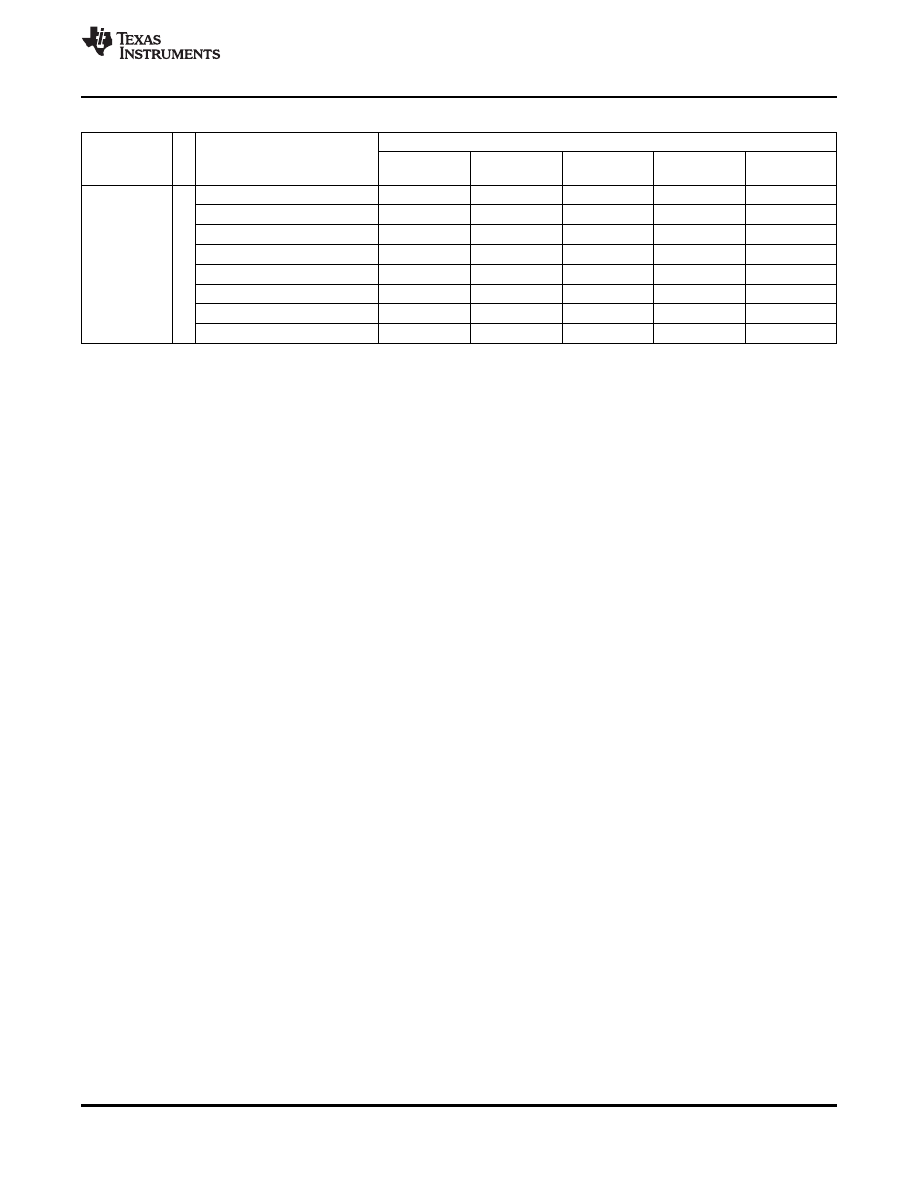
MSP430G2x53
MSP430G2x13
SLAS735F – APRIL 2011 – REVISED MAY 2012
Table 17. Port P1 (P1.3) Pin Functions
CONTROL BITS / SIGNALS
(1)
PIN NAME
x
FUNCTION
ADC10AE.x
(P1.x)
P1DIR.x
P1SEL.x
P1SEL2.x
CAPD.y
INCH.x=1
(2)
P1.3/
P1.x (I/O)
I: 0; O: 1
0
0
0
0
ADC10CLK
(2)
/
ADC10CLK
1
1
0
0
0
CAOUT/
CAOUT
1
1
1
0
0
A3
(2)
/
A3
X
X
X
1 (y = 3)
0
3
VREF-
(2)
/
VREF-
X
X
X
1
0
VEREF-
(2)
/
VEREF-
X
X
X
1
0
CA3/
CA3
X
X
X
0
1 (y = 3)
Pin Osc
Capacitive sensing
X
0
1
0
0
(1)
X = don't care
(2)
MSP430G2x53 devices only
Copyright © 2011–2012, Texas Instruments Incorporated
45
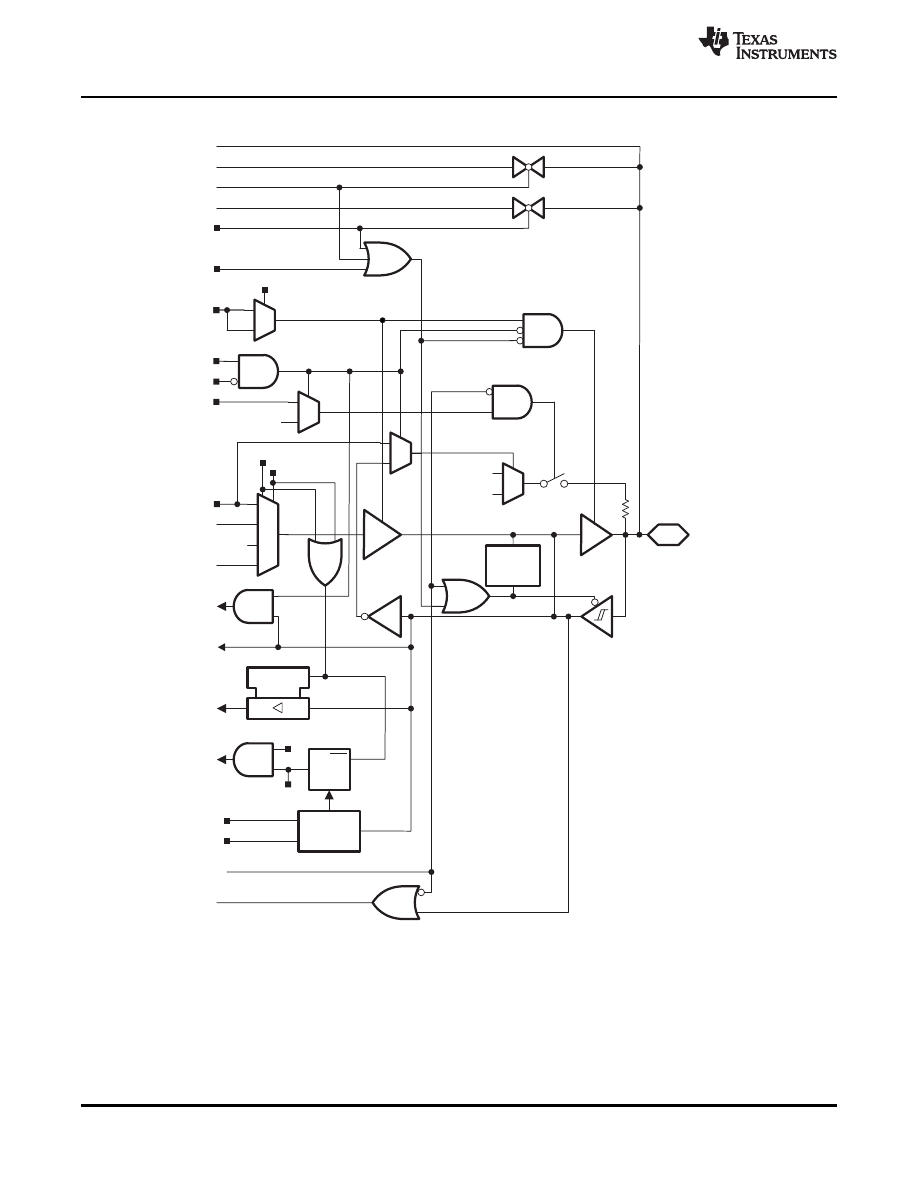
P1.4/SMCLK/UCB0STE/UCA0CLK/
VREF+*/VEREF+*/CA4/TCK
A4*/
Direction
0: Input
1: Output
To Module
SMCLK
PxOUT.y
DVSS
DVCC
1
TAx.y
TAxCLK
Bus
Keeper
EN
1
0
PxIN.y
EN
D
PxSEL.y
PxREN.y
1
0
PxDIR.y
1
0
PxSEL2.y
PxSEL.y
1
0
INCHx = y *
from Comparator
To ADC10 *
To Comparator
From/To ADC10 Ref+ *
PxSEL.y
1
3
2
1
0
PxSEL2.y
From JTAG
To JTAG
PxIRQ.y
PxIE.y
EN
Set
Q
Interrupt
Edge
Select
PxSEL.y
PxIES.y
PxIFG.y
CAPD.y
or ADC10AE0.y *
* Note: MSP430G2x52 devices only. MSP430G2x12 devices have no ADC10.
From Module
MSP430G2x53
MSP430G2x13
SLAS735F – APRIL 2011 – REVISED MAY 2012
Port P1 Pin Schematic: P1.4, Input/Output With Schmitt Trigger
46
Copyright © 2011–2012, Texas Instruments Incorporated
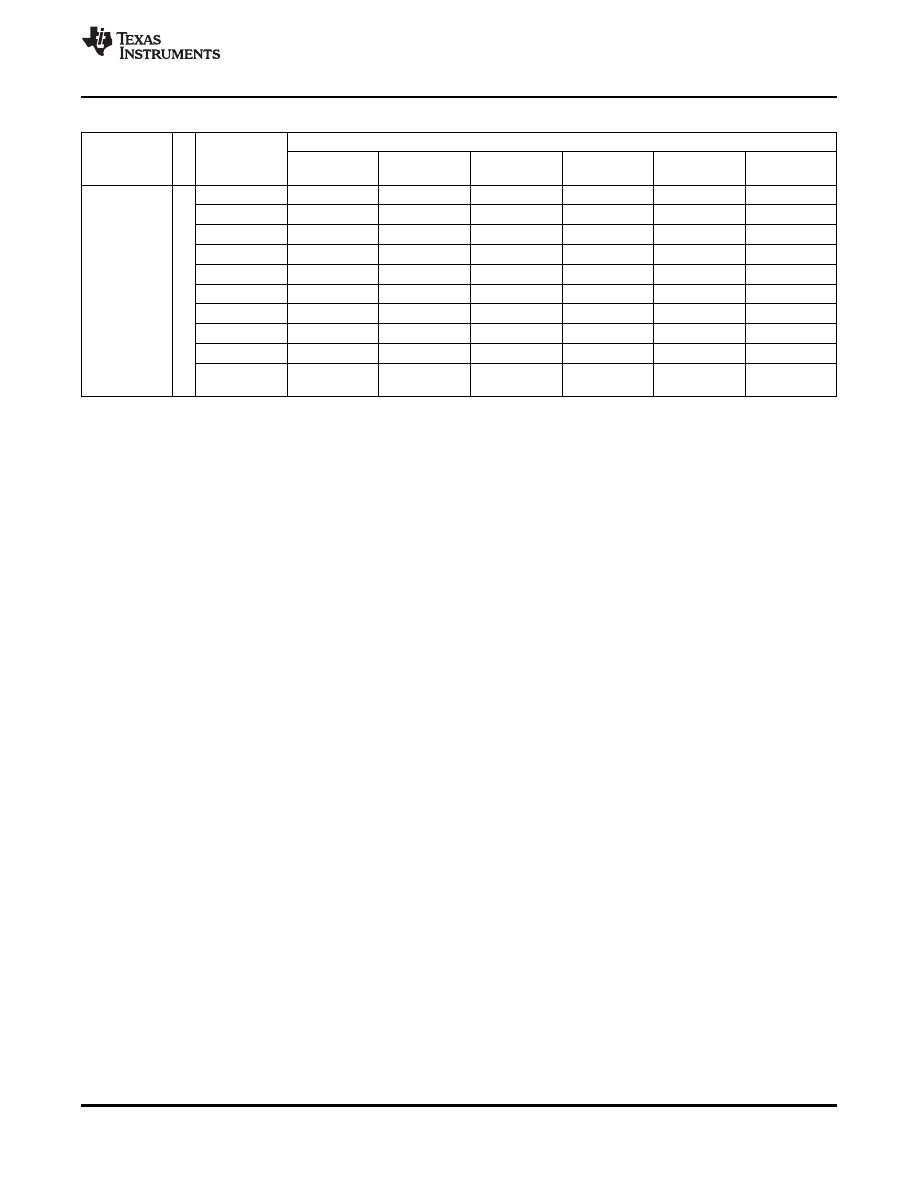
MSP430G2x53
MSP430G2x13
SLAS735F – APRIL 2011 – REVISED MAY 2012
Table 18. Port P1 (P1.4) Pin Functions
CONTROL BITS / SIGNALS
(1)
PIN NAME
x
FUNCTION
ADC10AE.x
(P1.x)
P1DIR.x
P1SEL.x
P1SEL2.x
JTAG Mode
CAPD.y
INCH.x=1
(2)
P1.4/
P1.x (I/O)
I: 0; O: 1
0
0
0
0
0
SMCLK/
SMCLK
1
1
0
0
0
0
UCB0STE/
UCB0STE
from USCI
1
1
0
0
0
UCA0CLK/
UCA0CLK
from USCI
1
1
0
0
0
VREF+
(2)
/
VREF+
X
X
X
1
0
0
4
VEREF+
(2)
/
VEREF+
X
X
X
1
0
0
A4
(2)
/
A4
X
X
X
1 (y = 4)
0
0
CA4
CA4
X
X
X
0
0
1 (y = 4)
TCK/
TCK
X
X
X
0
1
0
Capacitive
Pin Osc
X
0
1
0
0
0
sensing
(1)
X = don't care
(2)
MSP430G2x53 devices only
Copyright © 2011–2012, Texas Instruments Incorporated
47
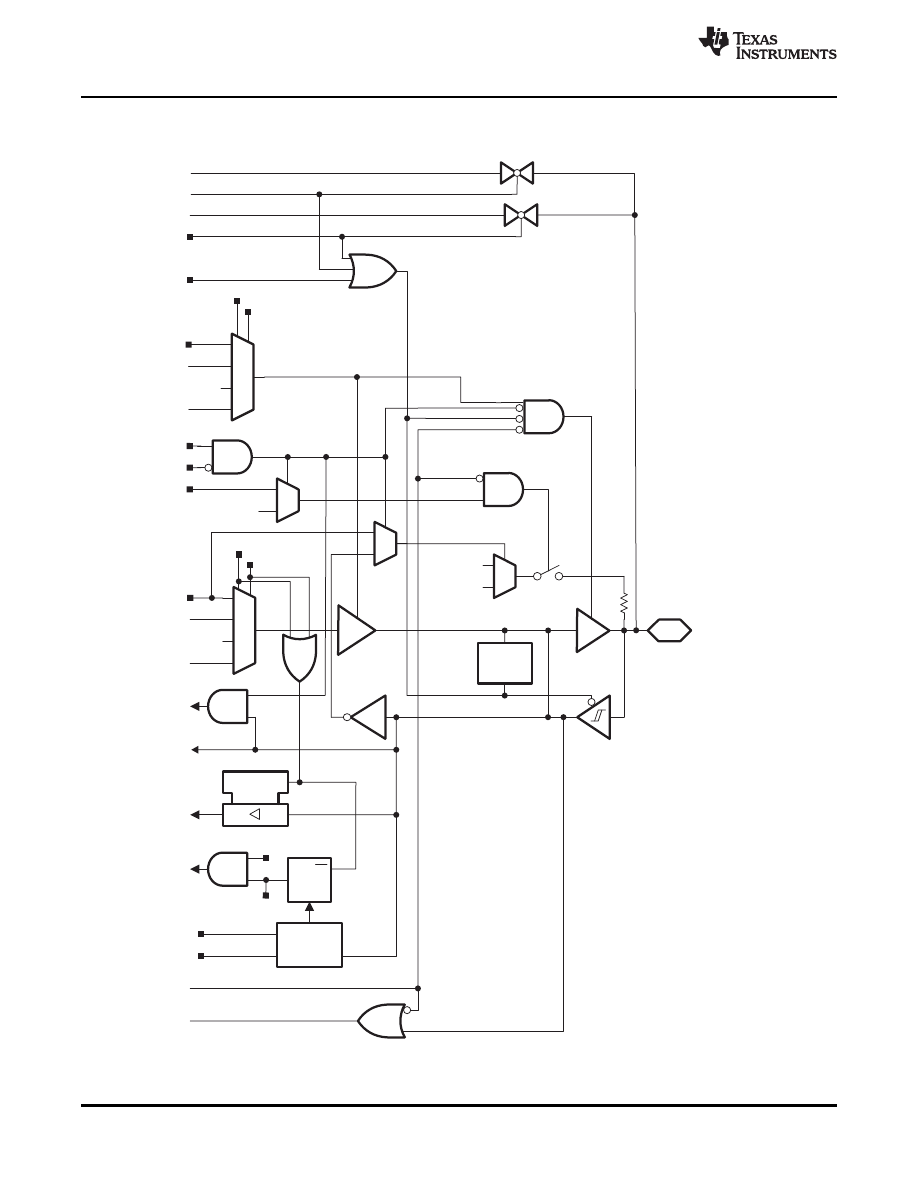
P1.5/TA0.0/UCB0CLK/UCA0STE/
A5*/CA5/TMS
P1.6/TA0.1/UCB0SOMI/UCB0SCL/
A6*/CA6/TDI/TCLK
P1.7/CAOUT/UCB0SIMO/UCB0SDA/
A7*/CA7/TDO/TDI
From Module
From Module
* Note: MSP430G2x53 devices only. MSP430G2x13 devices have no ADC10.
To Module
From Module
PxOUT.y
DVSS
DVCC
1
TAx.y
TAxCLK
Bus
Keeper
EN
1
0
PxIN.y
EN
D
PxSEL.y
PxREN.y
1
0
PxSEL2.y
1
0
INCHx = y *
To ADC10 *
PxSEL.y
1
3
2
1
0
PxSEL2.y
From JTAG
To JTAG
PxIRQ.y
PxIE.y
EN
Set
Q
Interrupt
Edge
Select
PxSEL.y
PxIES.y
PxIFG.y
Direction
0: Input
1: Output
PxDIR.y
From Module
PxSEL.y
3
2
1
0
PxSEL2.y
ADC10AE0.y *
From Comparator
To Comparator
CAPD.y
MSP430G2x53
MSP430G2x13
SLAS735F – APRIL 2011 – REVISED MAY 2012
Port P1 Pin Schematic: P1.5 to P1.7, Input/Output With Schmitt Trigger
48
Copyright © 2011–2012, Texas Instruments Incorporated
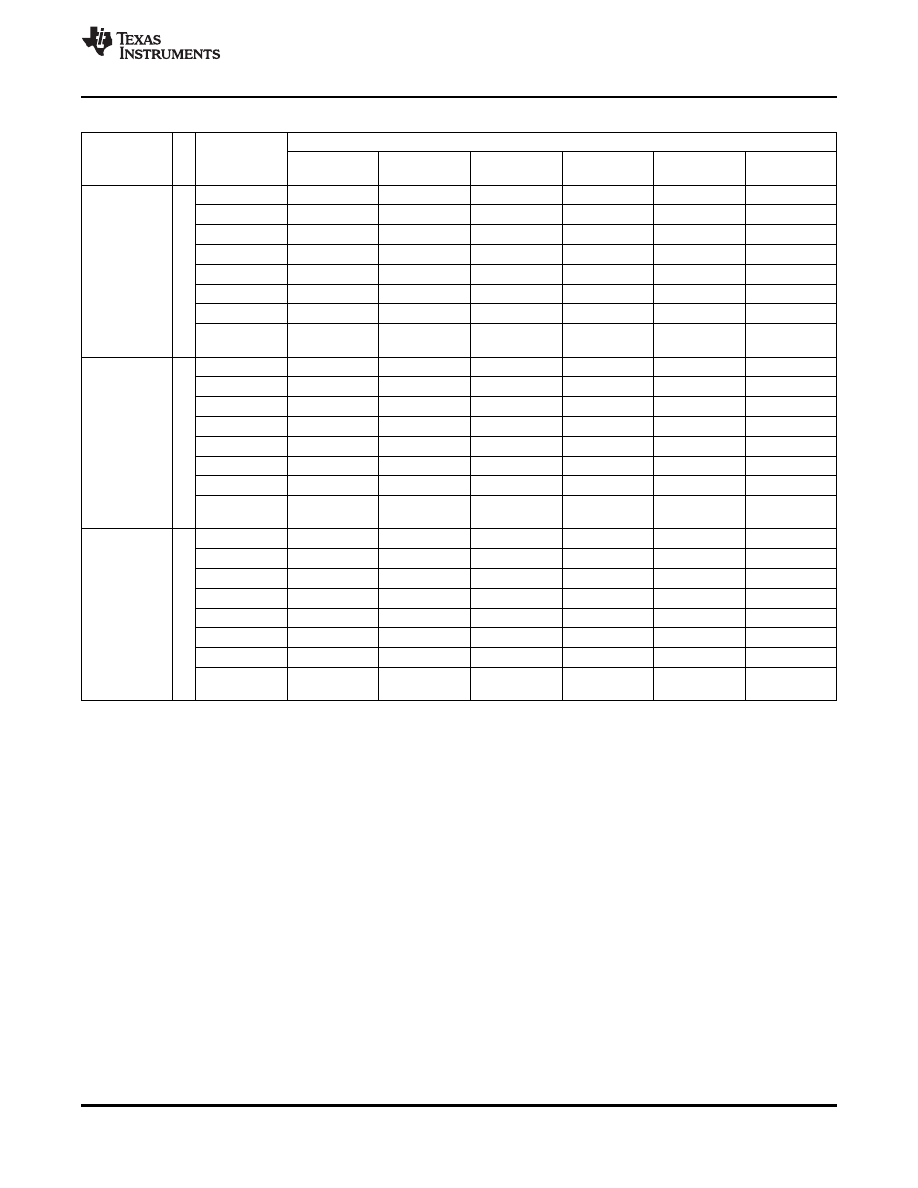
MSP430G2x53
MSP430G2x13
SLAS735F – APRIL 2011 – REVISED MAY 2012
Table 19. Port P1 (P1.5 to P1.7) Pin Functions
CONTROL BITS / SIGNALS
(1)
PIN NAME
x
FUNCTION
ADC10AE.x
(P1.x)
P1DIR.x
P1SEL.x
P1SEL2.x
JTAG Mode
CAPD.y
INCH.x=1
(2)
P1.5/
P1.x (I/O)
I: 0; O: 1
0
0
0
0
0
TA0.0/
TA0.0
1
1
0
0
0
0
UCB0CLK/
UCB0CLK
from USCI
1
1
0
0
0
UCA0STE/
UCA0STE
from USCI
1
1
0
0
0
5
A5
(2)
/
A5
X
X
X
1 (y = 5)
0
0
CA5
CA5
X
X
X
0
0
1 (y = 5)
TMS
TMS
X
X
X
0
1
0
Capacitive
Pin Osc
X
0
1
0
0
0
sensing
P1.6/
P1.x (I/O)
I: 0; O: 1
0
0
0
0
0
TA0.1/
TA0.1
1
1
0
0
0
0
UCB0SOMI/
UCB0SOMI
from USCI
1
1
0
0
0
UCB0SCL/
UCB0SCL
from USCI
1
1
0
0
0
6
A6
(2)
/
A6
X
X
X
1 (y = 6)
0
0
CA6
CA6
X
X
X
0
0
1 (y = 6)
TDI/TCLK/
TDI/TCLK
X
X
X
0
1
0
Capacitive
Pin Osc
X
0
1
0
0
0
sensing
P1.7/
P1.x (I/O)
I: 0; O: 1
0
0
0
0
0
UCB0SIMO/
UCB0SIMO
from USCI
1
1
0
0
0
UCB0SDA/
UCB0SDA
from USCI
1
1
0
0
0
A7
(2)
/
A7
X
X
X
1 (y = 7)
0
0
7
CA7
CA7
X
X
X
0
0
1 (y = 7)
CAOUT
CAOUT
1
1
0
0
0
0
TDO/TDI/
TDO/TDI
X
X
X
0
1
0
Capacitive
Pin Osc
X
0
1
0
0
0
sensing
(1)
X = don't care
(2)
MSP430G2x53 devices only
Copyright © 2011–2012, Texas Instruments Incorporated
49
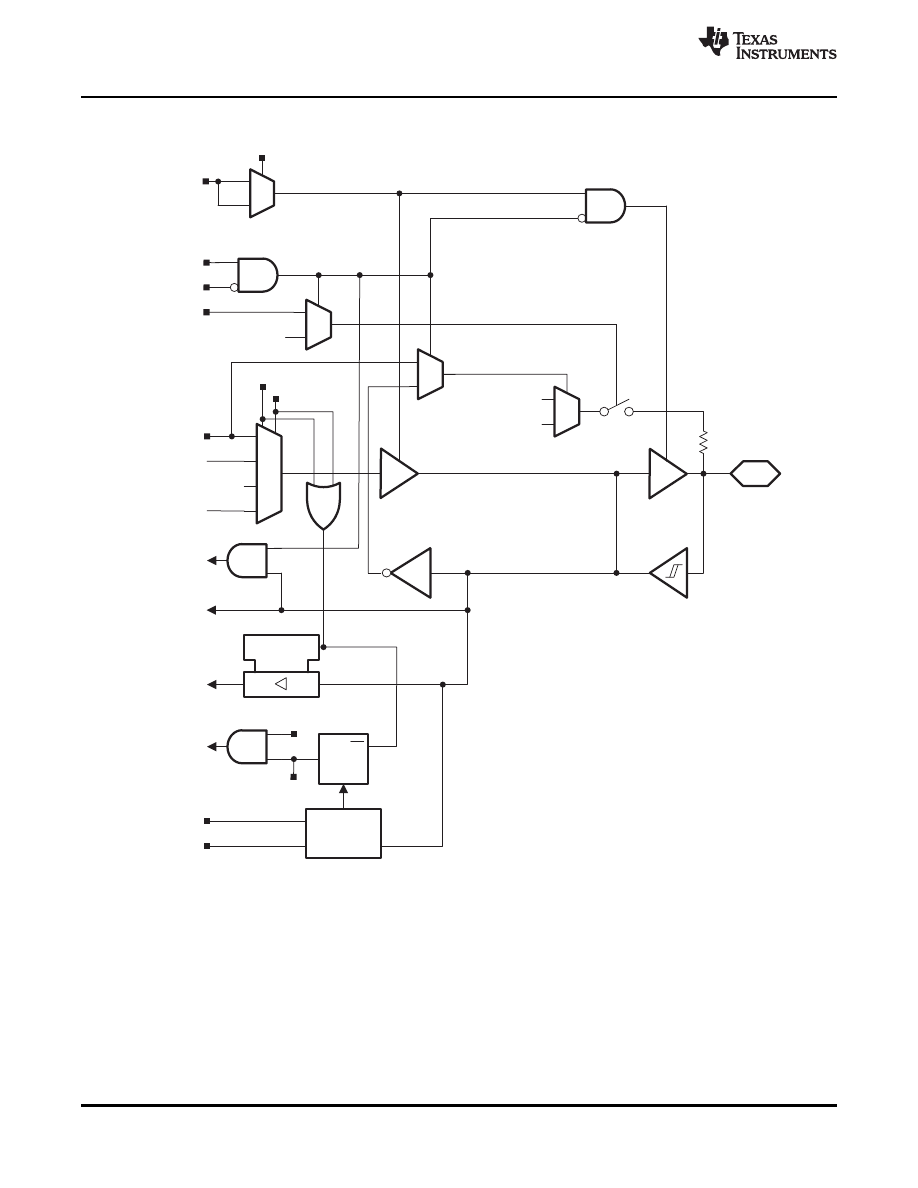
P2.0/TA1.0
P2.1/TA1.1
P2.2/TA1.1
P2.3/TA1.0
P2.4/TA1.2
P2.5/TA1.2
From Timer
Direction
0: Input
1: Output
To Module
PxOUT.y
DVSS
DVCC
1
TAx.y
TAxCLK
1
0
PxIN.y
EN
D
PxSEL.y
PxREN.y
1
0
PxSEL2.y
1
0
PxSEL.y
1
3
2
1
0
PxSEL2.y
PxIRQ.y
PxIE.y
EN
Set
Q
Interrupt
Edge
Select
PxSEL.y
PxIES.y
PxIFG.y
PxDIR.y
1
0
PxSEL.y
0
MSP430G2x53
MSP430G2x13
SLAS735F – APRIL 2011 – REVISED MAY 2012
Port P2 Pin Schematic: P2.0 to P2.5, Input/Output With Schmitt Trigger
50
Copyright © 2011–2012, Texas Instruments Incorporated
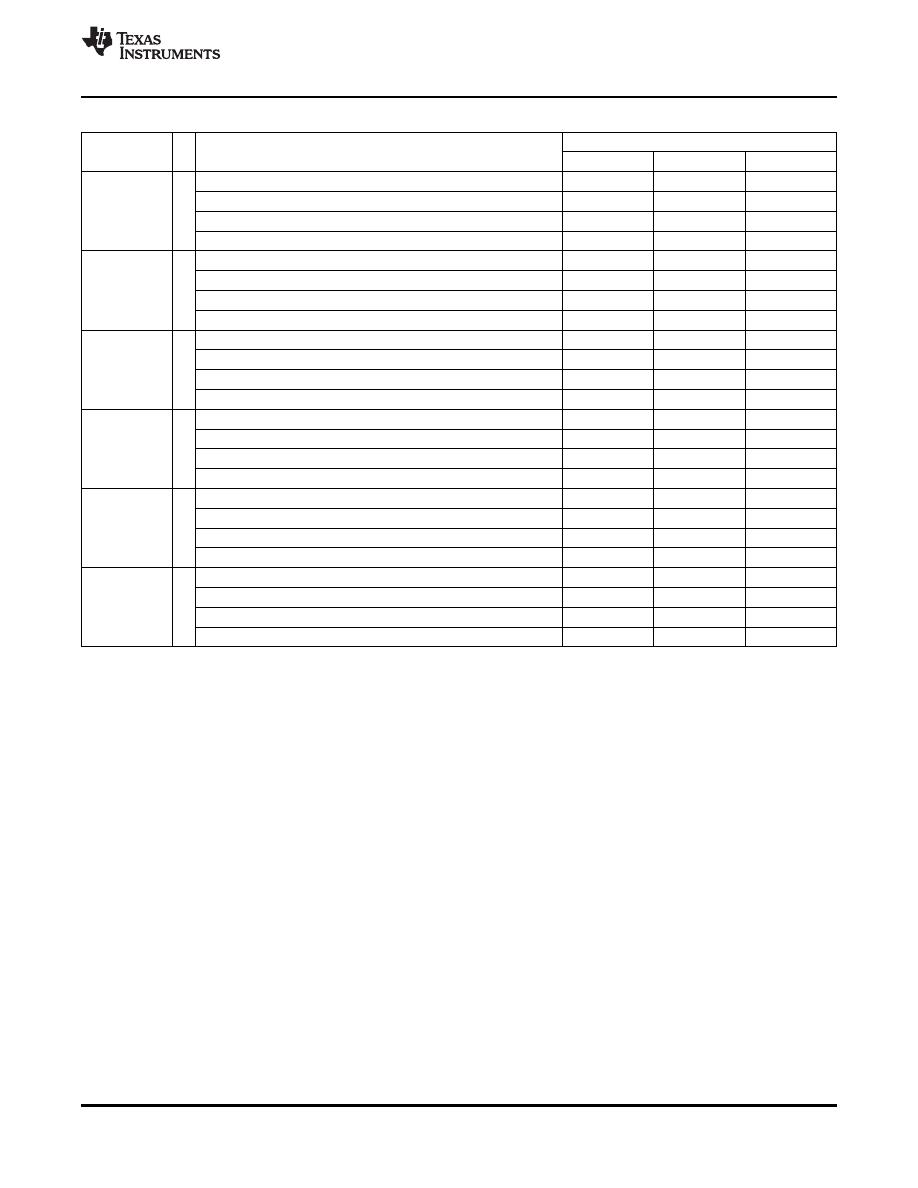
MSP430G2x53
MSP430G2x13
SLAS735F – APRIL 2011 – REVISED MAY 2012
Table 20. Port P2 (P2.0 to P2.5) Pin Functions
CONTROL BITS / SIGNALS
(1)
PIN NAME
x
FUNCTION
(P2.x)
P2DIR.x
P2SEL.x
P2SEL2.x
P2.0/
P2.x (I/O)
I: 0; O: 1
0
0
TA1.0/
Timer1_A3.CCI0A
0
1
0
0
Timer1_A3.TA0
1
1
0
Pin Osc
Capacitive sensing
X
0
1
P2.1/
P2.x (I/O)
I: 0; O: 1
0
0
TA1.1/
Timer1_A3.CCI1A
0
1
0
1
Timer1_A3.TA1
1
1
0
Pin Osc
Capacitive sensing
X
0
1
P2.2/
P2.x (I/O)
I: 0; O: 1
0
0
TA1.1/
Timer1_A3.CCI1B
0
1
0
2
Timer1_A3.TA1
1
1
0
Pin Osc
Capacitive sensing
X
0
1
P2.3/
P2.x (I/O)
I: 0; O: 1
0
0
TA1.0/
Timer1_A3.CCI0B
0
1
0
3
Timer1_A3.TA0
1
1
0
Pin Osc
Capacitive sensing
X
0
1
P2.4/
P2.x (I/O)
I: 0; O: 1
0
0
TA1.2/
Timer1_A3.CCI2A
0
1
0
4
Timer1_A3.TA2
1
1
0
Pin Osc
Capacitive sensing
X
0
1
P2.5/
P2.x (I/O)
I: 0; O: 1
0
0
TA1.2/
Timer1_A3.CCI2B
0
1
0
5
Timer1_A3.TA2
1
1
0
Pin Osc
Capacitive sensing
X
0
1
(1)
X = don't care
Copyright © 2011–2012, Texas Instruments Incorporated
51
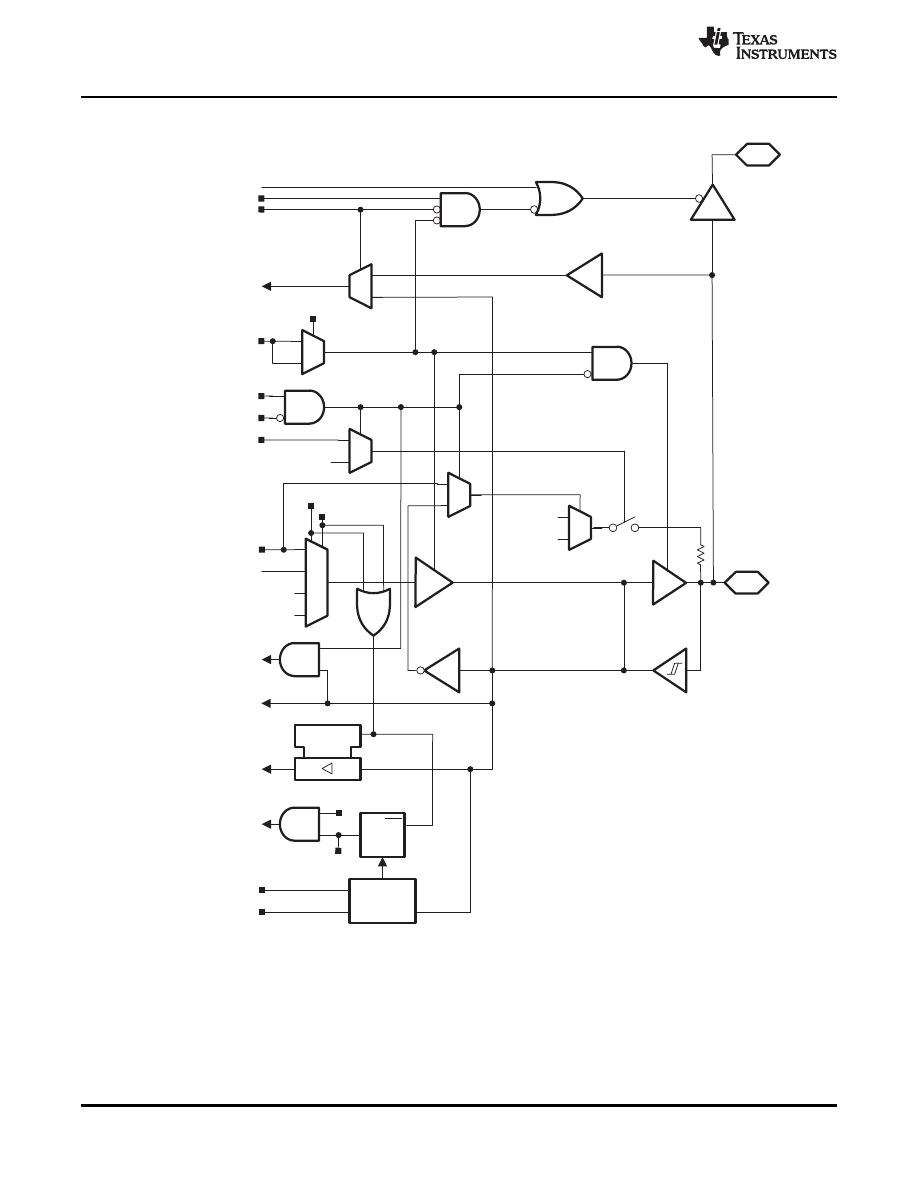
XIN/P2.6/TA0.1
Direction
0: Input
1: Output
To Module
From Module
PxOUT.y
DVSS
DVCC
1
TAx.y
TAxCLK
1
0
PxIN.y
EN
D
PxSEL.y
PxREN.y
1
0
PxDIR.y
1
0
PxSEL2.y
PxSEL.y
1
0
PxSEL.y
1
3
2
1
0
PxSEL2.y
PxIRQ.y
PxIE.y
EN
Set
Q
Interrupt
Edge
Select
PxSEL.y
PxIES.y
PxIFG.y
1
0
XOUT/P2.7
LF off
LFXT1CLK
PxSEL.6 and PxSEL.7
BCSCTL3.LFXT1Sx = 11
MSP430G2x53
MSP430G2x13
SLAS735F – APRIL 2011 – REVISED MAY 2012
Port P2 Pin Schematic: P2.6, Input/Output With Schmitt Trigger
52
Copyright © 2011–2012, Texas Instruments Incorporated

MSP430G2x53
MSP430G2x13
SLAS735F – APRIL 2011 – REVISED MAY 2012
Table 21. Port P2 (P2.6) Pin Functions
CONTROL BITS / SIGNALS
(1)
PIN NAME
x
FUNCTION
P2SEL.6
P2SEL2.6
(P2.x)
P2DIR.x
P2SEL.7
P2SEL2.7
1
0
XIN
XIN
0
1
0
0
0
P2.6
P2.x (I/O)
I: 0; O: 1
X
0
6
1
0
TA0.1
Timer0_A3.TA1
1
0
0
0
1
Pin Osc
Capacitive sensing
X
X
X
(1)
X = don't care
Copyright © 2011–2012, Texas Instruments Incorporated
53
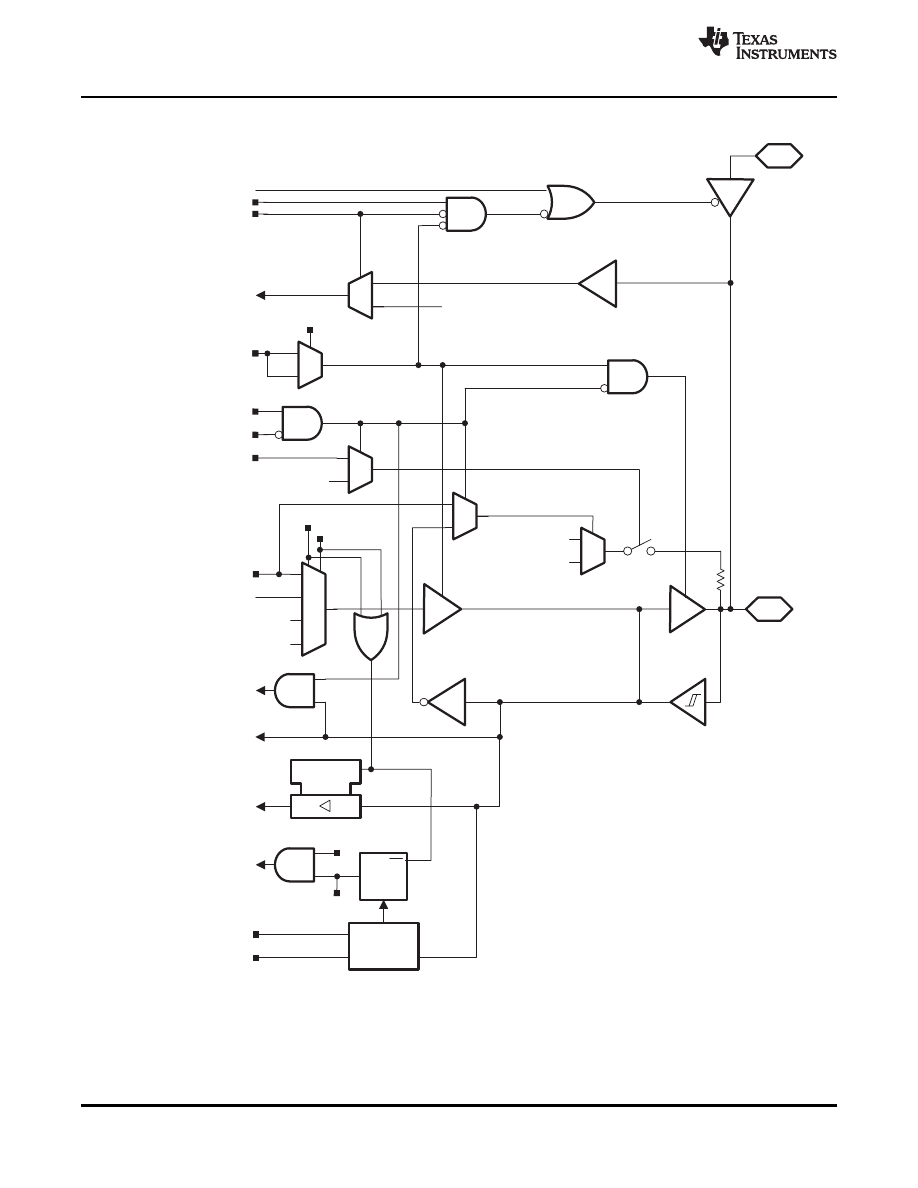
XOUT/P2.7
Direction
0: Input
1: Output
To Module
From Module
PxOUT.y
DVSS
DVCC
1
TAx.y
TAxCLK
1
0
PxIN.y
EN
D
PxSEL.y
PxREN.y
1
0
PxDIR.y
1
0
PxSEL2.y
PxSEL.y
1
0
PxSEL.y
1
3
2
1
0
PxSEL2.y
PxIRQ.y
PxIE.y
EN
Set
Q
Interrupt
Edge
Select
PxSEL.y
PxIES.y
PxIFG.y
1
0
XIN
LF off
LFXT1CLK
PxSEL.6 and PxSEL.7
BCSCTL3.LFXT1Sx = 11
from P2.6
MSP430G2x53
MSP430G2x13
SLAS735F – APRIL 2011 – REVISED MAY 2012
Port P2 Pin Schematic: P2.7, Input/Output With Schmitt Trigger
54
Copyright © 2011–2012, Texas Instruments Incorporated
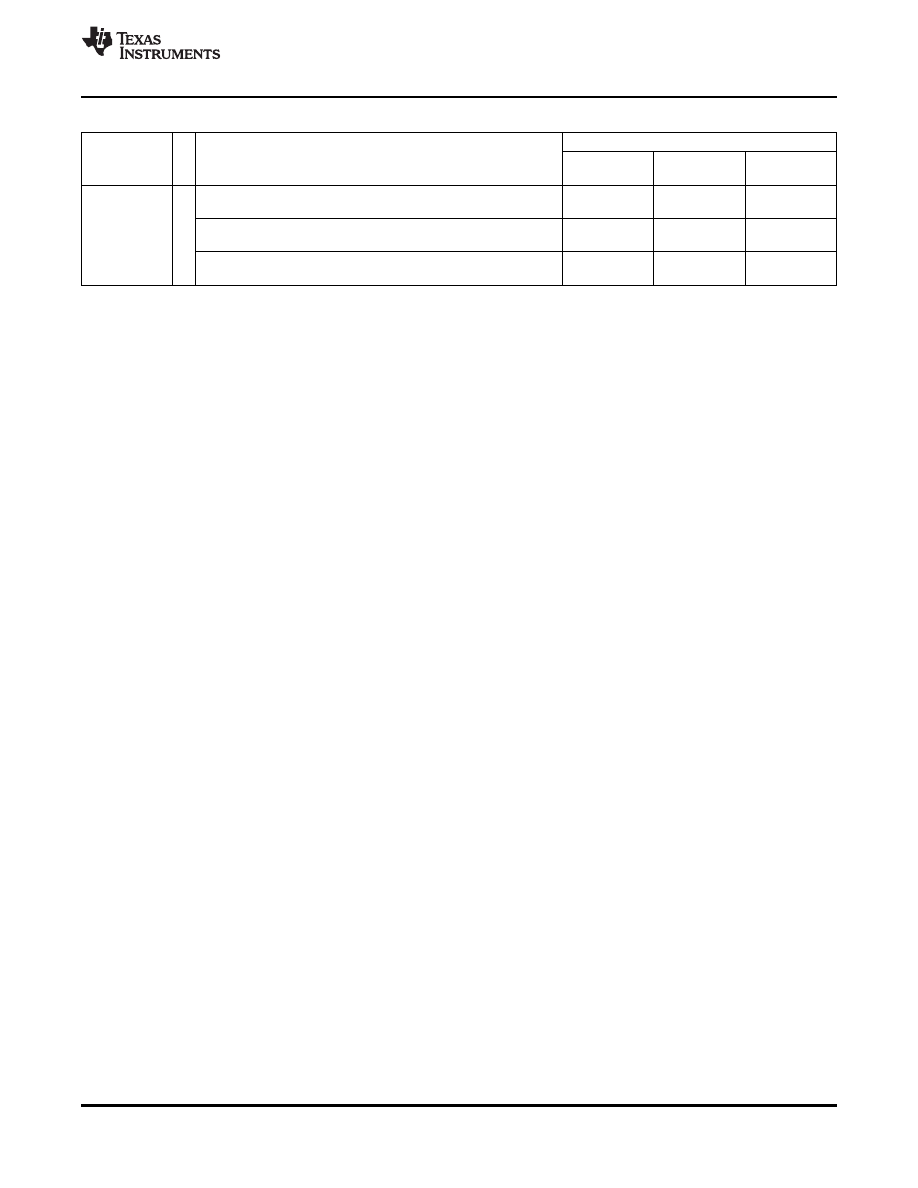
MSP430G2x53
MSP430G2x13
SLAS735F – APRIL 2011 – REVISED MAY 2012
Table 22. Port P2 (P2.7) Pin Functions
CONTROL BITS / SIGNALS
(1)
PIN NAME
x
FUNCTION
P2SEL.6
P2SEL2.6
(P2.x)
P2DIR.x
P2SEL.7
P2SEL2.7
1
0
XOUT/
XOUT
1
1
0
0
0
P2.7/
7
P2.x (I/O)
I: 0; O: 1
X
0
0
1
Pin Osc
Capacitive sensing
X
X
X
(1)
X = don't care
Copyright © 2011–2012, Texas Instruments Incorporated
55
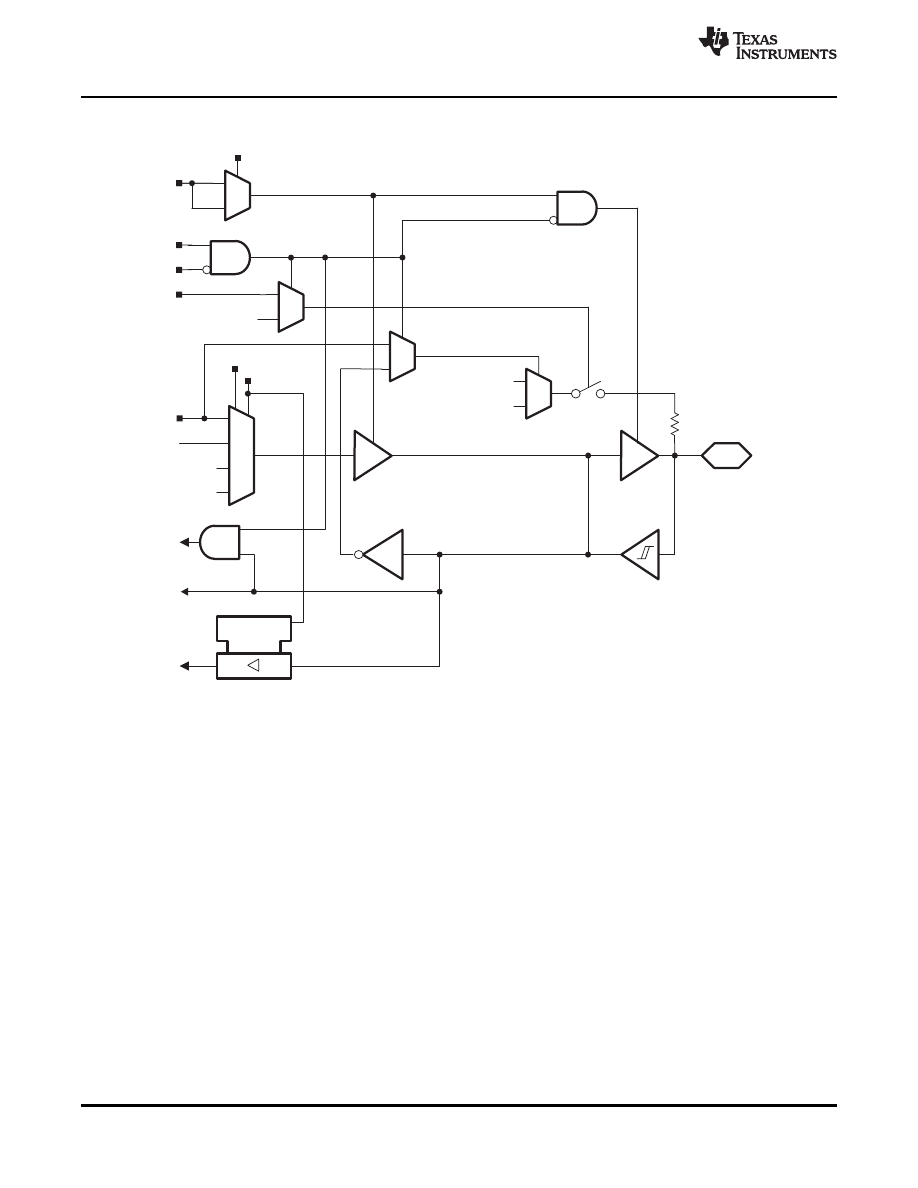
P3.0/TA0.2
P3.1/TA1.0
P3.2/TA1.1
P3.3/TA1.2
P3.4/TA0.0
P3.5/TA0.1
P3.6/TA0.2
P3.7/TA1CLK/CAOUT
Direction
0: Input
1: Output
To Module
From Module
PxOUT.y
DVSS
DVCC
1
TAx.y
TAxCLK
1
0
PxIN.y
EN
D
PxSEL.y
PxREN.y
1
0
PxDIR.y
1
0
PxSEL2.y
PxSEL.y
1
0
PxSEL.y
1
3
2
1
0
PxSEL2.y
MSP430G2x53
MSP430G2x13
SLAS735F – APRIL 2011 – REVISED MAY 2012
Port P3 Pin Schematic: P3.0 to P3.7, Input/Output With Schmitt Trigger (RHB Package Only)
56
Copyright © 2011–2012, Texas Instruments Incorporated
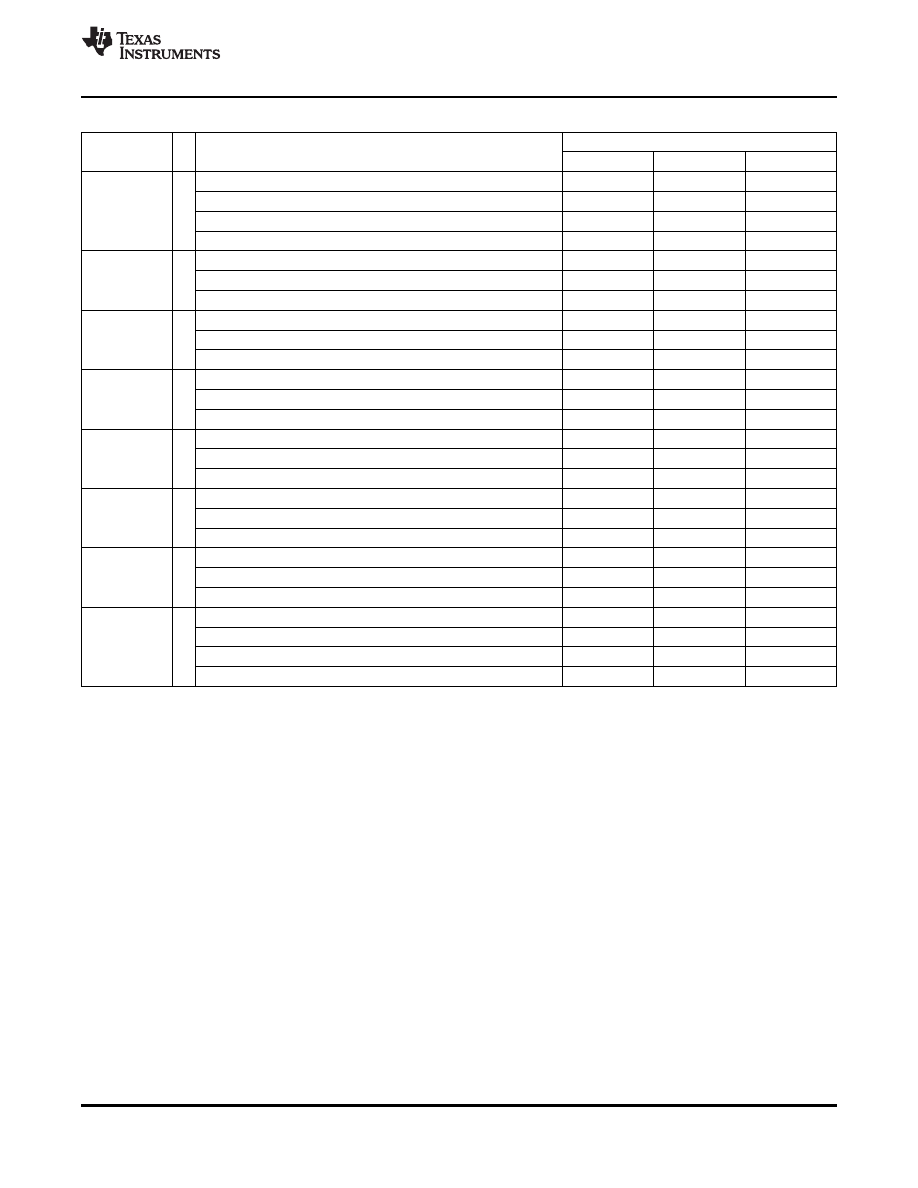
MSP430G2x53
MSP430G2x13
SLAS735F – APRIL 2011 – REVISED MAY 2012
Table 23. Port P3 (P3.0 to P3.7) Pin Functions (RHB Package Only)
CONTROL BITS / SIGNALS
(1)
PIN NAME
x
FUNCTION
(P3.x)
P3DIR.x
P3SEL.x
P3SEL2.x
P3.0/
P3.x (I/O)
I: 0; O: 1
0
0
TA0.2/
Timer0_A3.CCI2A
0
1
0
0
Timer0_A3.TA2
1
1
0
Pin Osc
Capacitive sensing
X
0
1
P3.1/
P3.x (I/O)
I: 0; O: 1
0
0
TA1.0/
1
Timer1_A3.TA0
1
1
0
Pin Osc
Capacitive sensing
X
0
1
P3.2/
P3.x (I/O)
I: 0; O: 1
0
0
TA1.1/
2
Timer1_A3.TA1
1
1
0
Pin Osc
Capacitive sensing
X
0
1
P3.3/
P3.x (I/O)
I: 0; O: 1
0
0
TA1.2/
3
Timer1_A3.TA2
1
1
0
Pin Osc
Capacitive sensing
X
0
1
P3.4/
P3.x (I/O)
I: 0; O: 1
0
0
TA0.0/
4
Timer0_A3.TA0
1
1
0
Pin Osc
Capacitive sensing
X
0
1
P3.5/
P3.x (I/O)
I: 0; O: 1
0
0
TA0.1/
5
Timer0_A3.TA1
1
1
0
Pin Osc
Capacitive sensing
X
0
1
P3.6/
P3.x (I/O)
I: 0; O: 1
0
0
TA0.2/
6
Timer0_A3.TA2
1
1
0
Pin Osc
Capacitive sensing
X
0
1
P3.7/
P3.x (I/O)
I: 0; O: 1
0
0
TA1CLK/
Timer1_A3.TACLK
0
1
0
7
CAOUT/
Comparator output
1
1
0
Pin Osc
Capacitive sensing
X
0
1
(1)
X = don't care
Copyright © 2011–2012, Texas Instruments Incorporated
57

MSP430G2x53
MSP430G2x13
SLAS735F – APRIL 2011 – REVISED MAY 2012
REVISION HISTORY
REVISION
DESCRIPTION
SLAS735
Initial release
Changed Control Bits / Signals column in
SLAS735A
Changed Pin Name and Function columns in
Changed Storage temperature range limit in
SLAS735B
Added BSL functions to P1.1 and P1.5 in
Added CAOUT information to
.
Changed T
stg
, Programmed device, to -55°C to 150°C in
SLAS735C
Changed TAG_ADC10_1 value to 0x10 in
.
Added AVCC (RHB package only, pin 29) to
Terminal Functions.
Corrected typo in P3.7/TA1CLK/CAOUT description in
.
SLAS735D
Corrected PW28 terminal assignment in Input and Output Pin Number columns in
.
Changed all port schematics (added buffer after PxOUT.y mux) in
.
SLAS735E
and
, Corrected Timer_A register names.
Added note on TC
REF+
in
10-Bit ADC, Built-In Voltage Reference (MSP430G2x53 Only)
SLAS735F
Corrected signal names on
Port P1 Pin Schematic: P1.4, Input/Output With Schmitt Trigger
58
Copyright © 2011–2012, Texas Instruments Incorporated
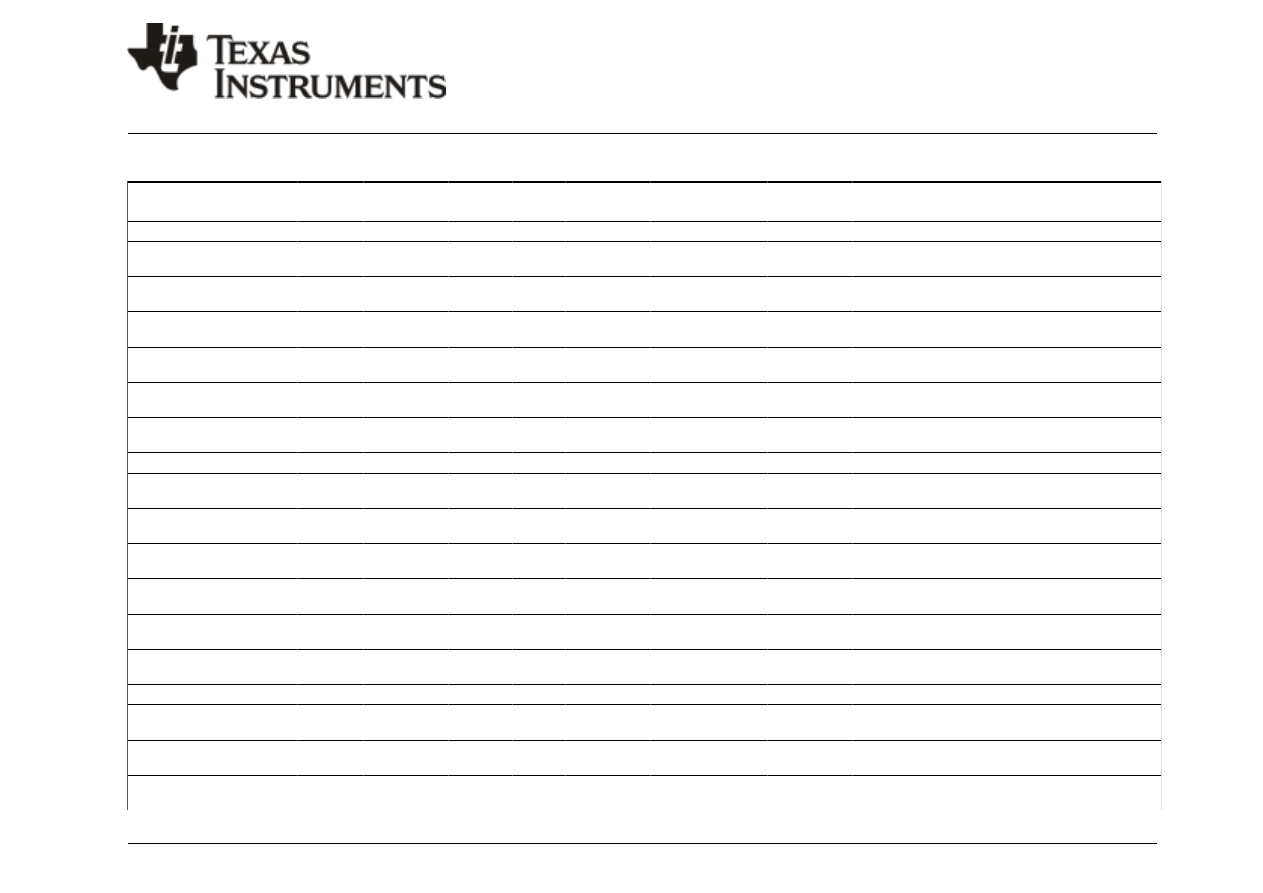
PACKAGE OPTION ADDENDUM
www.ti.com
15-May-2012
Addendum-Page 1
PACKAGING INFORMATION
Orderable Device
Status
(1)
Package Type Package
Drawing
Pins
Package Qty
Eco Plan
(2)
Lead/
Ball Finish
MSL Peak Temp
(3)
Samples
(Requires Login)
MSP430G2153IN20
ACTIVE
PDIP
N
20
20
Pb-Free (RoHS)
CU NIPDAU Level-1-260C-UNLIM
MSP430G2153IPW20
ACTIVE
TSSOP
PW
20
70
Green (RoHS
& no Sb/Br)
CU NIPDAU Level-1-260C-UNLIM
MSP430G2153IPW20R
ACTIVE
TSSOP
PW
20
2000
Green (RoHS
& no Sb/Br)
CU NIPDAU Level-1-260C-UNLIM
MSP430G2153IPW28
ACTIVE
TSSOP
PW
28
50
Green (RoHS
& no Sb/Br)
CU NIPDAU Level-1-260C-UNLIM
MSP430G2153IPW28R
ACTIVE
TSSOP
PW
28
2000
Green (RoHS
& no Sb/Br)
CU NIPDAU Level-1-260C-UNLIM
MSP430G2153IRHB32R
ACTIVE
QFN
RHB
32
3000
Green (RoHS
& no Sb/Br)
CU NIPDAU Level-2-260C-1 YEAR
MSP430G2153IRHB32T
ACTIVE
QFN
RHB
32
250
Green (RoHS
& no Sb/Br)
CU NIPDAU Level-2-260C-1 YEAR
MSP430G2213IN20
ACTIVE
PDIP
N
20
20
Pb-Free (RoHS)
CU NIPDAU Level-1-260C-UNLIM
MSP430G2213IPW20
ACTIVE
TSSOP
PW
20
70
Green (RoHS
& no Sb/Br)
CU NIPDAU Level-1-260C-UNLIM
MSP430G2213IPW20R
ACTIVE
TSSOP
PW
20
2000
Green (RoHS
& no Sb/Br)
CU NIPDAU Level-1-260C-UNLIM
MSP430G2213IPW28
ACTIVE
TSSOP
PW
28
50
Green (RoHS
& no Sb/Br)
CU NIPDAU Level-1-260C-UNLIM
MSP430G2213IPW28R
ACTIVE
TSSOP
PW
28
2000
Green (RoHS
& no Sb/Br)
CU NIPDAU Level-1-260C-UNLIM
MSP430G2213IRHB32R
ACTIVE
QFN
RHB
32
3000
Green (RoHS
& no Sb/Br)
CU NIPDAU Level-2-260C-1 YEAR
MSP430G2213IRHB32T
ACTIVE
QFN
RHB
32
250
Green (RoHS
& no Sb/Br)
CU NIPDAU Level-2-260C-1 YEAR
MSP430G2253IN20
ACTIVE
PDIP
N
20
20
Pb-Free (RoHS)
CU NIPDAU Level-1-260C-UNLIM
MSP430G2253IPW20
ACTIVE
TSSOP
PW
20
70
Green (RoHS
& no Sb/Br)
CU NIPDAU Level-1-260C-UNLIM
MSP430G2253IPW20R
ACTIVE
TSSOP
PW
20
2000
Green (RoHS
& no Sb/Br)
CU NIPDAU Level-1-260C-UNLIM
MSP430G2253IPW28
ACTIVE
TSSOP
PW
28
50
Green (RoHS
& no Sb/Br)
CU NIPDAU Level-1-260C-UNLIM
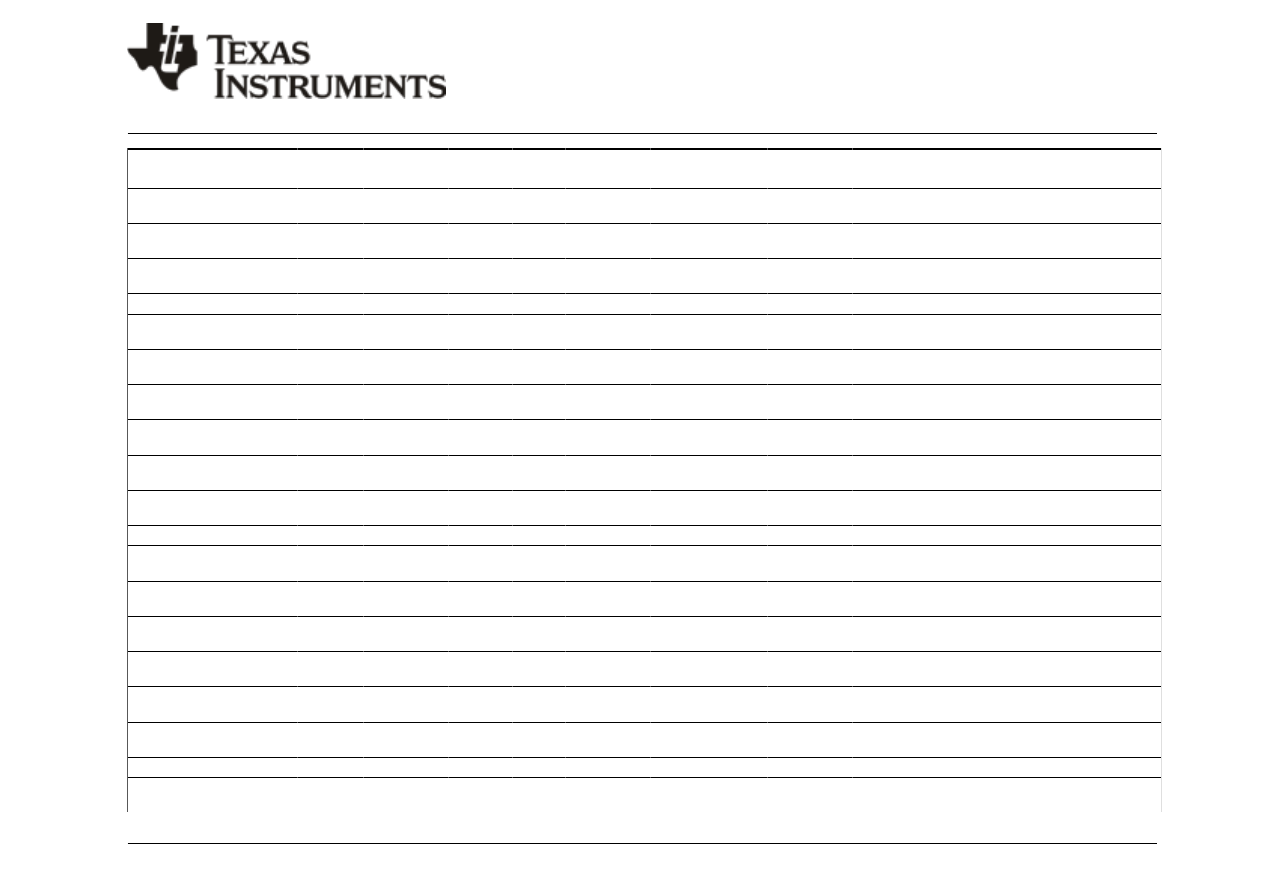
PACKAGE OPTION ADDENDUM
www.ti.com
15-May-2012
Addendum-Page 2
Orderable Device
Status
(1)
Package Type Package
Drawing
Pins
Package Qty
Eco Plan
(2)
Lead/
Ball Finish
MSL Peak Temp
(3)
Samples
(Requires Login)
MSP430G2253IPW28R
ACTIVE
TSSOP
PW
28
2000
Green (RoHS
& no Sb/Br)
CU NIPDAU Level-1-260C-UNLIM
MSP430G2253IRHB32R
ACTIVE
QFN
RHB
32
3000
Green (RoHS
& no Sb/Br)
CU NIPDAU Level-2-260C-1 YEAR
MSP430G2253IRHB32T
ACTIVE
QFN
RHB
32
250
Green (RoHS
& no Sb/Br)
CU NIPDAU Level-2-260C-1 YEAR
MSP430G2313IN20
ACTIVE
PDIP
N
20
20
Pb-Free (RoHS)
CU NIPDAU Level-1-260C-UNLIM
MSP430G2313IPW20
ACTIVE
TSSOP
PW
20
70
Green (RoHS
& no Sb/Br)
CU NIPDAU Level-1-260C-UNLIM
MSP430G2313IPW20R
ACTIVE
TSSOP
PW
20
2000
Green (RoHS
& no Sb/Br)
CU NIPDAU Level-1-260C-UNLIM
MSP430G2313IPW28
ACTIVE
TSSOP
PW
28
50
Green (RoHS
& no Sb/Br)
CU NIPDAU Level-1-260C-UNLIM
MSP430G2313IPW28R
ACTIVE
TSSOP
PW
28
2000
Green (RoHS
& no Sb/Br)
CU NIPDAU Level-1-260C-UNLIM
MSP430G2313IRHB32R
ACTIVE
QFN
RHB
32
3000
Green (RoHS
& no Sb/Br)
CU NIPDAU Level-2-260C-1 YEAR
MSP430G2313IRHB32T
ACTIVE
QFN
RHB
32
250
Green (RoHS
& no Sb/Br)
CU NIPDAU Level-2-260C-1 YEAR
MSP430G2353IN20
ACTIVE
PDIP
N
20
20
Pb-Free (RoHS)
CU NIPDAU Level-1-260C-UNLIM
MSP430G2353IPW20
ACTIVE
TSSOP
PW
20
70
Green (RoHS
& no Sb/Br)
CU NIPDAU Level-1-260C-UNLIM
MSP430G2353IPW20R
ACTIVE
TSSOP
PW
20
2000
Green (RoHS
& no Sb/Br)
CU NIPDAU Level-1-260C-UNLIM
MSP430G2353IPW28
ACTIVE
TSSOP
PW
28
50
Green (RoHS
& no Sb/Br)
CU NIPDAU Level-1-260C-UNLIM
MSP430G2353IPW28R
ACTIVE
TSSOP
PW
28
2000
Green (RoHS
& no Sb/Br)
CU NIPDAU Level-1-260C-UNLIM
MSP430G2353IRHB32R
ACTIVE
QFN
RHB
32
3000
Green (RoHS
& no Sb/Br)
CU NIPDAU Level-2-260C-1 YEAR
MSP430G2353IRHB32T
ACTIVE
QFN
RHB
32
250
Green (RoHS
& no Sb/Br)
CU NIPDAU Level-2-260C-1 YEAR
MSP430G2413IN20
ACTIVE
PDIP
N
20
20
Pb-Free (RoHS)
CU NIPDAU Level-1-260C-UNLIM
MSP430G2413IPW20
ACTIVE
TSSOP
PW
20
70
Green (RoHS
& no Sb/Br)
CU NIPDAU Level-1-260C-UNLIM
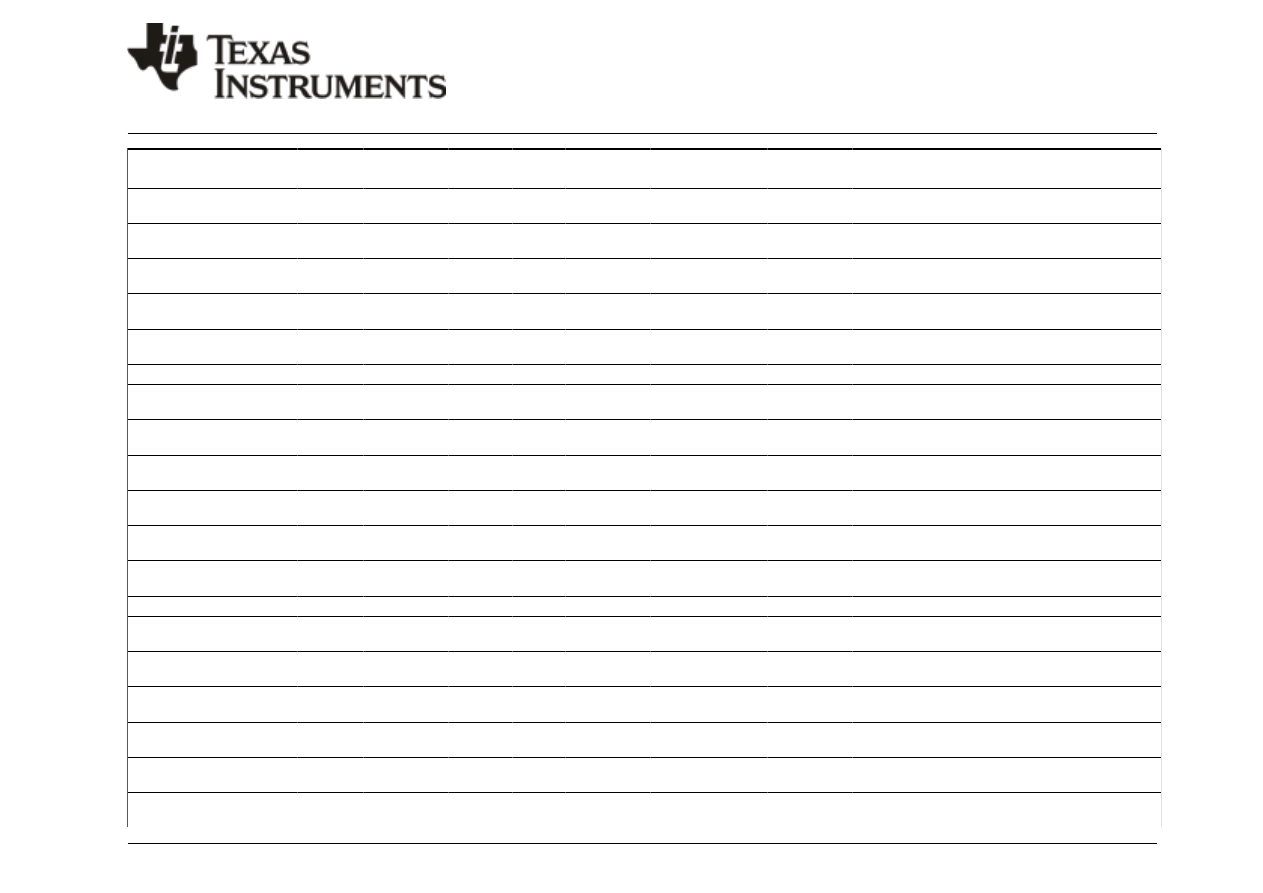
PACKAGE OPTION ADDENDUM
www.ti.com
15-May-2012
Addendum-Page 3
Orderable Device
Status
(1)
Package Type Package
Drawing
Pins
Package Qty
Eco Plan
(2)
Lead/
Ball Finish
MSL Peak Temp
(3)
Samples
(Requires Login)
MSP430G2413IPW20R
ACTIVE
TSSOP
PW
20
2000
Green (RoHS
& no Sb/Br)
CU NIPDAU Level-1-260C-UNLIM
MSP430G2413IPW28
ACTIVE
TSSOP
PW
28
50
Green (RoHS
& no Sb/Br)
CU NIPDAU Level-1-260C-UNLIM
MSP430G2413IPW28R
ACTIVE
TSSOP
PW
28
2000
Green (RoHS
& no Sb/Br)
CU NIPDAU Level-1-260C-UNLIM
MSP430G2413IRHB32R
ACTIVE
QFN
RHB
32
3000
Green (RoHS
& no Sb/Br)
CU NIPDAU Level-2-260C-1 YEAR
MSP430G2413IRHB32T
ACTIVE
QFN
RHB
32
250
Green (RoHS
& no Sb/Br)
CU NIPDAU Level-2-260C-1 YEAR
MSP430G2453IN20
ACTIVE
PDIP
N
20
20
Pb-Free (RoHS)
CU NIPDAU Level-1-260C-UNLIM
MSP430G2453IPW20
ACTIVE
TSSOP
PW
20
70
Green (RoHS
& no Sb/Br)
CU NIPDAU Level-1-260C-UNLIM
MSP430G2453IPW20R
ACTIVE
TSSOP
PW
20
2000
Green (RoHS
& no Sb/Br)
CU NIPDAU Level-1-260C-UNLIM
MSP430G2453IPW28
ACTIVE
TSSOP
PW
28
50
Green (RoHS
& no Sb/Br)
CU NIPDAU Level-1-260C-UNLIM
MSP430G2453IPW28R
ACTIVE
TSSOP
PW
28
2000
Green (RoHS
& no Sb/Br)
CU NIPDAU Level-1-260C-UNLIM
MSP430G2453IRHB32R
ACTIVE
QFN
RHB
32
3000
Green (RoHS
& no Sb/Br)
CU NIPDAU Level-2-260C-1 YEAR
MSP430G2453IRHB32T
ACTIVE
QFN
RHB
32
250
Green (RoHS
& no Sb/Br)
CU NIPDAU Level-2-260C-1 YEAR
MSP430G2513IN20
ACTIVE
PDIP
N
20
20
Pb-Free (RoHS)
CU NIPDAU Level-1-260C-UNLIM
MSP430G2513IPW20
ACTIVE
TSSOP
PW
20
70
Green (RoHS
& no Sb/Br)
CU NIPDAU Level-1-260C-UNLIM
MSP430G2513IPW20R
ACTIVE
TSSOP
PW
20
2000
Green (RoHS
& no Sb/Br)
CU NIPDAU Level-1-260C-UNLIM
MSP430G2513IPW28
ACTIVE
TSSOP
PW
28
50
Green (RoHS
& no Sb/Br)
CU NIPDAU Level-1-260C-UNLIM
MSP430G2513IPW28R
ACTIVE
TSSOP
PW
28
2000
Green (RoHS
& no Sb/Br)
CU NIPDAU Level-1-260C-UNLIM
MSP430G2513IRHB32R
ACTIVE
QFN
RHB
32
3000
Green (RoHS
& no Sb/Br)
CU NIPDAU Level-2-260C-1 YEAR
MSP430G2513IRHB32T
ACTIVE
QFN
RHB
32
250
Green (RoHS
& no Sb/Br)
CU NIPDAU Level-2-260C-1 YEAR
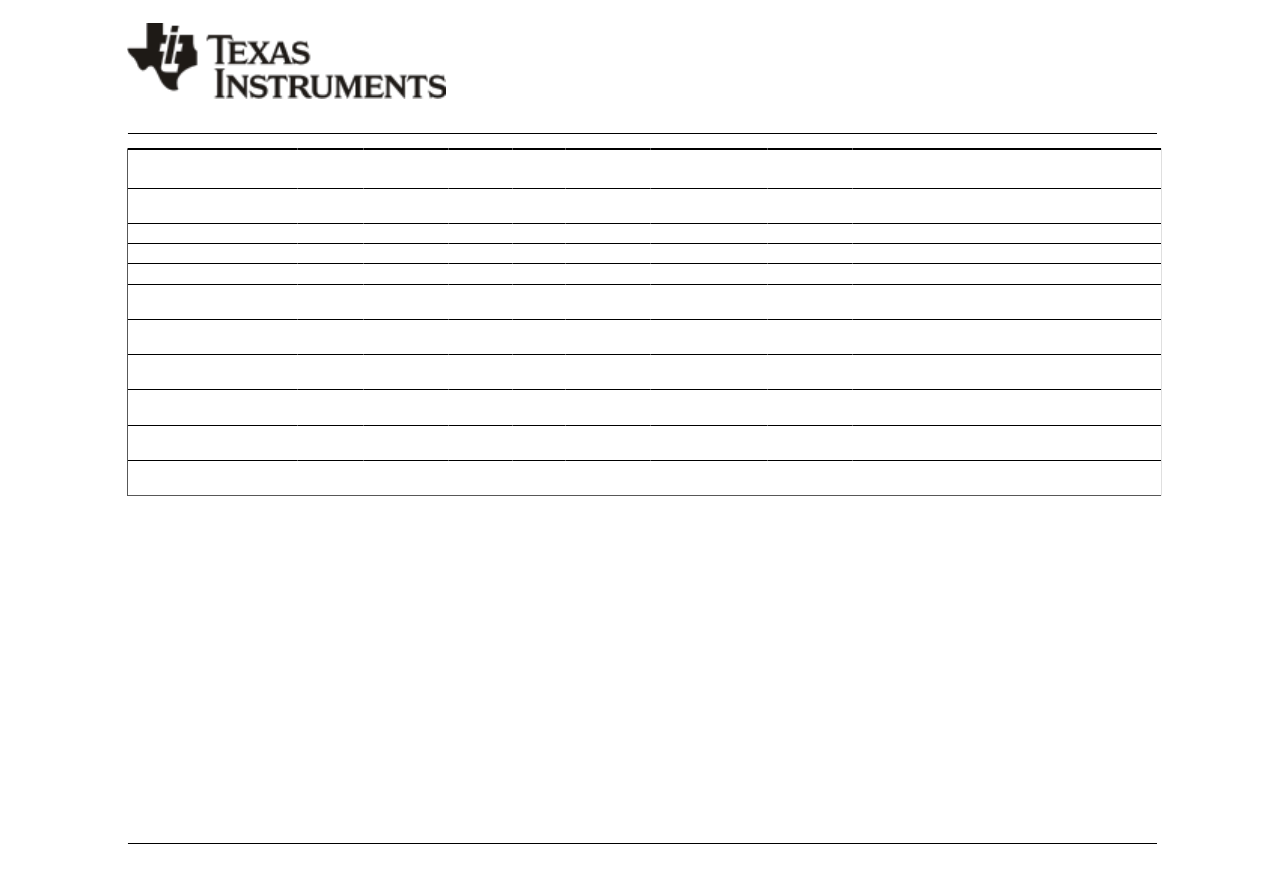
PACKAGE OPTION ADDENDUM
www.ti.com
15-May-2012
Addendum-Page 4
Orderable Device
Status
(1)
Package Type Package
Drawing
Pins
Package Qty
Eco Plan
(2)
Lead/
Ball Finish
MSL Peak Temp
(3)
Samples
(Requires Login)
MSP430G2553CY
PREVIEW
DIESALE
Y
0
405
Green (RoHS
& no Sb/Br)
Call TI
N / A for Pkg Type
MSP430G2553CYS
PREVIEW WAFERSALE
YS
0
TBD
Call TI
Call TI
MSP430G2553GACYS
PREVIEW WAFERSALE
YS
0
1
TBD
Call TI
Call TI
MSP430G2553IN20
ACTIVE
PDIP
N
20
20
Pb-Free (RoHS)
CU NIPDAU Level-1-260C-UNLIM
MSP430G2553IPW20
ACTIVE
TSSOP
PW
20
70
Green (RoHS
& no Sb/Br)
CU NIPDAU Level-1-260C-UNLIM
MSP430G2553IPW20R
ACTIVE
TSSOP
PW
20
2000
Green (RoHS
& no Sb/Br)
CU NIPDAU Level-1-260C-UNLIM
MSP430G2553IPW28
ACTIVE
TSSOP
PW
28
50
Green (RoHS
& no Sb/Br)
CU NIPDAU Level-1-260C-UNLIM
MSP430G2553IPW28R
ACTIVE
TSSOP
PW
28
2000
Green (RoHS
& no Sb/Br)
CU NIPDAU Level-1-260C-UNLIM
MSP430G2553IRHB32R
ACTIVE
QFN
RHB
32
3000
Green (RoHS
& no Sb/Br)
CU NIPDAU Level-2-260C-1 YEAR
MSP430G2553IRHB32T
ACTIVE
QFN
RHB
32
250
Green (RoHS
& no Sb/Br)
CU NIPDAU Level-2-260C-1 YEAR
(1)
The marketing status values are defined as follows:
ACTIVE: Product device recommended for new designs.
LIFEBUY: TI has announced that the device will be discontinued, and a lifetime-buy period is in effect.
NRND: Not recommended for new designs. Device is in production to support existing customers, but TI does not recommend using this part in a new design.
PREVIEW: Device has been announced but is not in production. Samples may or may not be available.
OBSOLETE: TI has discontinued the production of the device.
(2)
Eco Plan - The planned eco-friendly classification: Pb-Free (RoHS), Pb-Free (RoHS Exempt), or Green (RoHS & no Sb/Br) - please check
http://www.ti.com/productcontent
for the latest availability
information and additional product content details.
TBD: The Pb-Free/Green conversion plan has not been defined.
Pb-Free (RoHS): TI's terms "Lead-Free" or "Pb-Free" mean semiconductor products that are compatible with the current RoHS requirements for all 6 substances, including the requirement that
lead not exceed 0.1% by weight in homogeneous materials. Where designed to be soldered at high temperatures, TI Pb-Free products are suitable for use in specified lead-free processes.
Pb-Free (RoHS Exempt): This component has a RoHS exemption for either 1) lead-based flip-chip solder bumps used between the die and package, or 2) lead-based die adhesive used between
the die and leadframe. The component is otherwise considered Pb-Free (RoHS compatible) as defined above.
Green (RoHS & no Sb/Br): TI defines "Green" to mean Pb-Free (RoHS compatible), and free of Bromine (Br) and Antimony (Sb) based flame retardants (Br or Sb do not exceed 0.1% by weight
in homogeneous material)
(3)
MSL, Peak Temp. -- The Moisture Sensitivity Level rating according to the JEDEC industry standard classifications, and peak solder temperature.
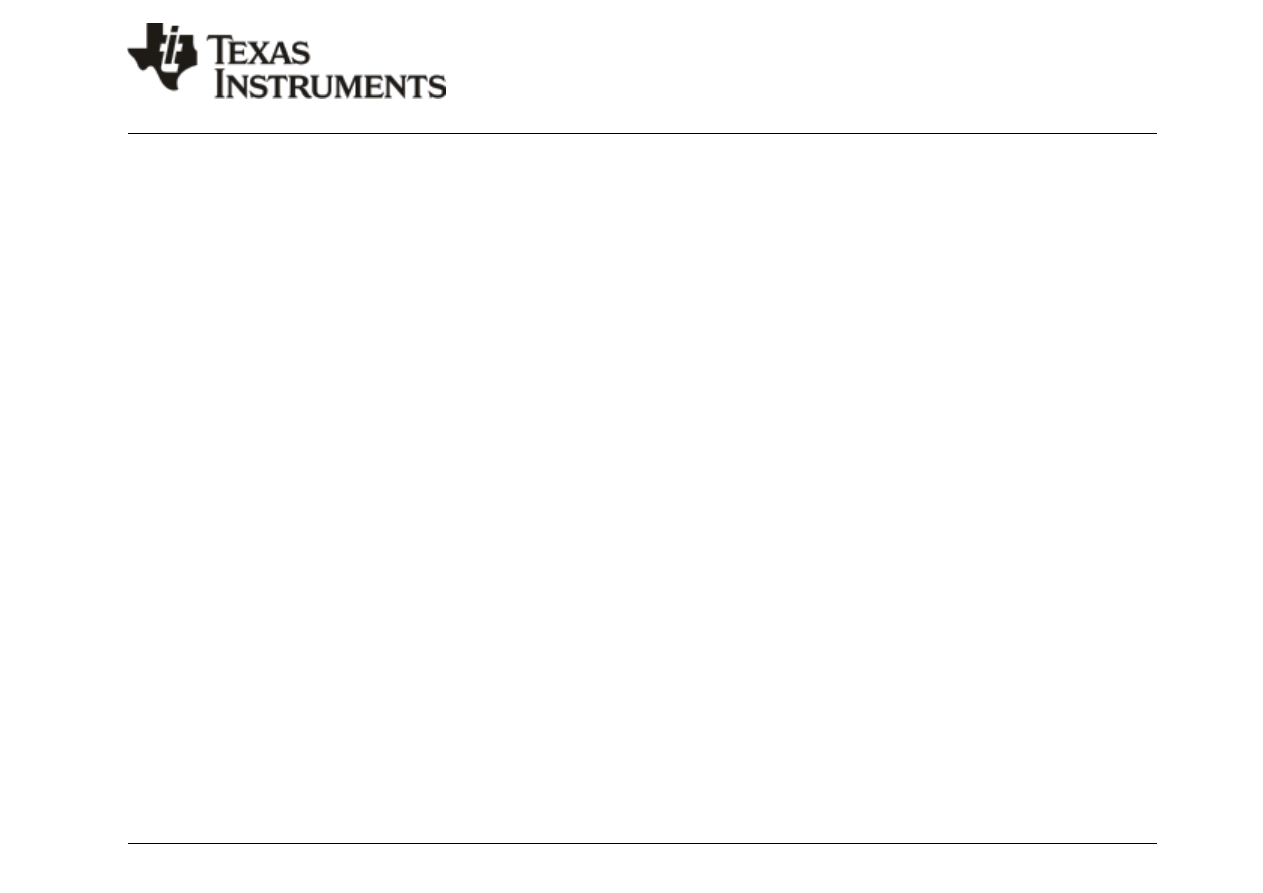
PACKAGE OPTION ADDENDUM
www.ti.com
15-May-2012
Addendum-Page 5
Important Information and Disclaimer:The information provided on this page represents TI's knowledge and belief as of the date that it is provided. TI bases its knowledge and belief on information
provided by third parties, and makes no representation or warranty as to the accuracy of such information. Efforts are underway to better integrate information from third parties. TI has taken and
continues to take reasonable steps to provide representative and accurate information but may not have conducted destructive testing or chemical analysis on incoming materials and chemicals.
TI and TI suppliers consider certain information to be proprietary, and thus CAS numbers and other limited information may not be available for release.
In no event shall TI's liability arising out of such information exceed the total purchase price of the TI part(s) at issue in this document sold by TI to Customer on an annual basis.
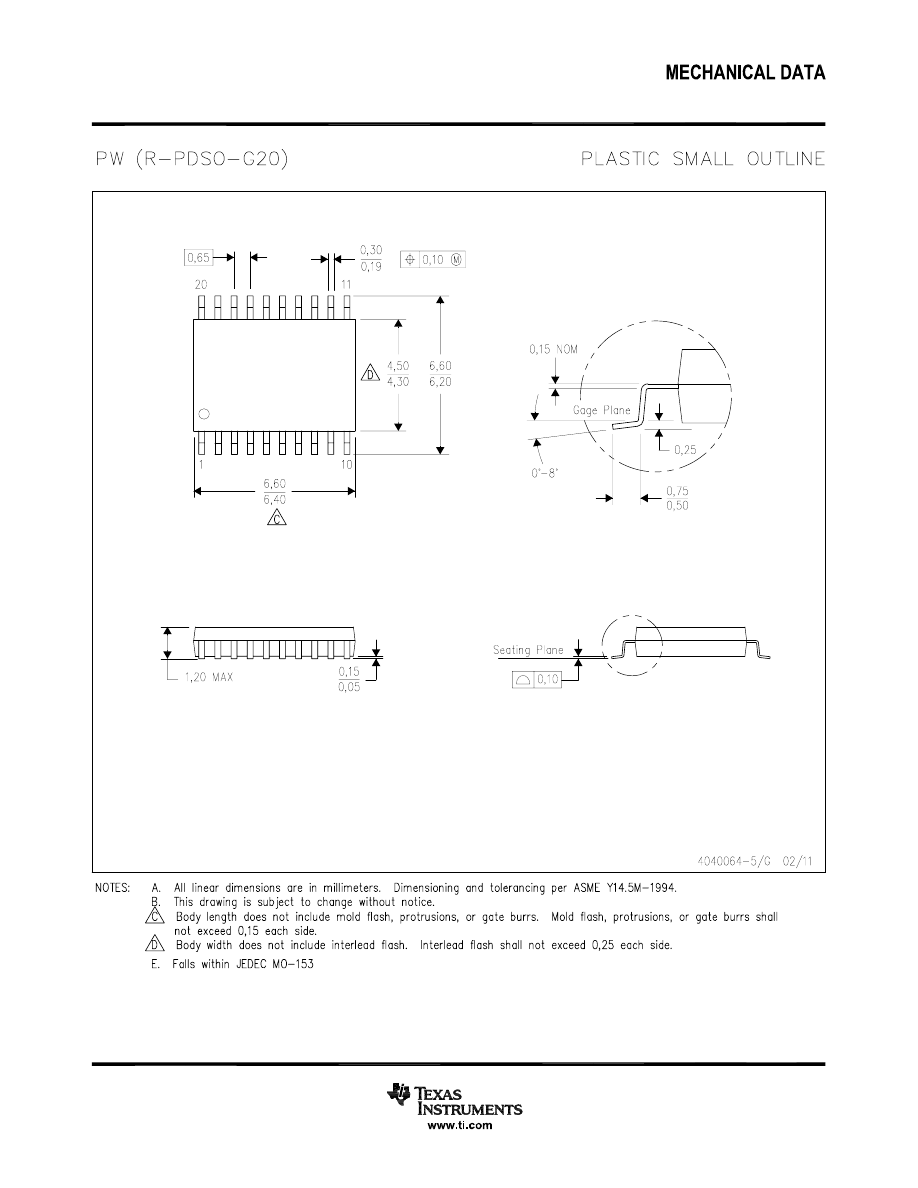
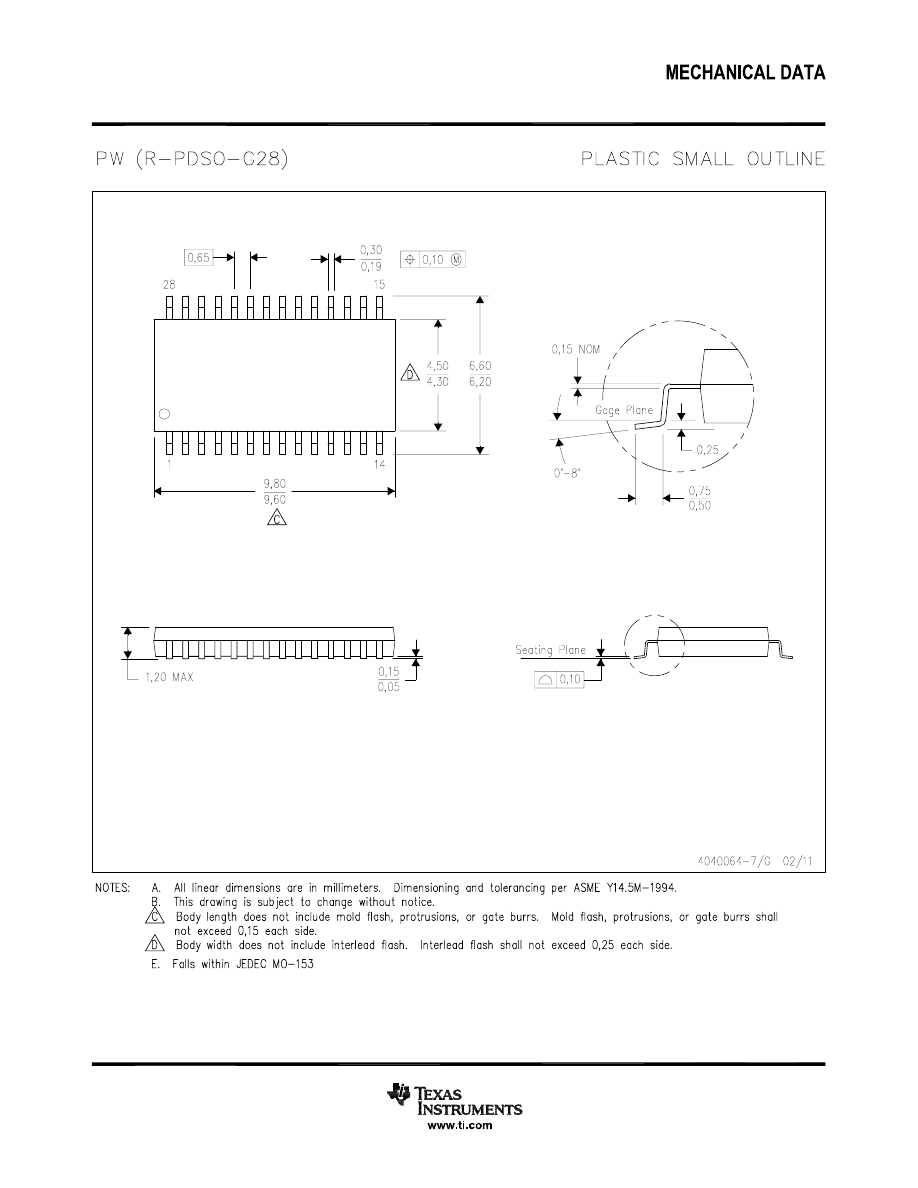

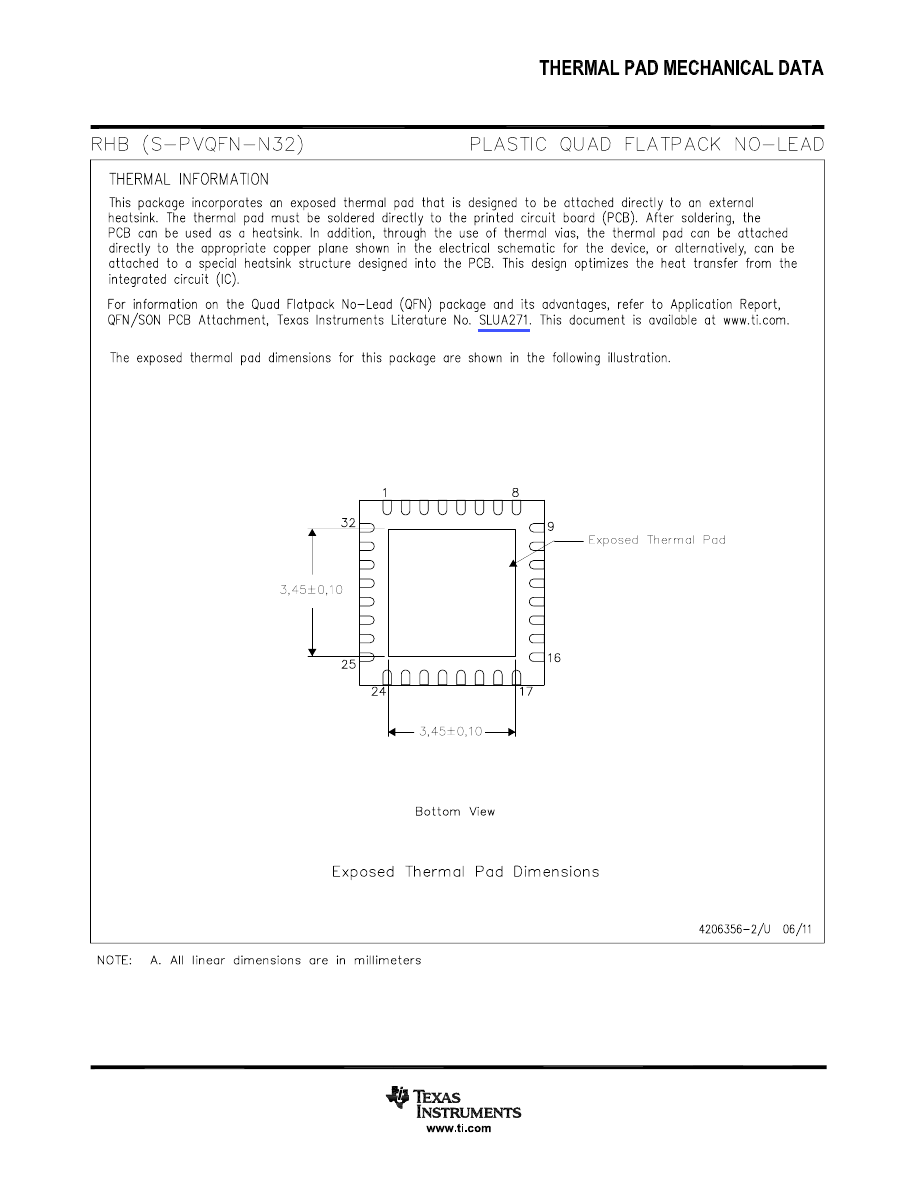
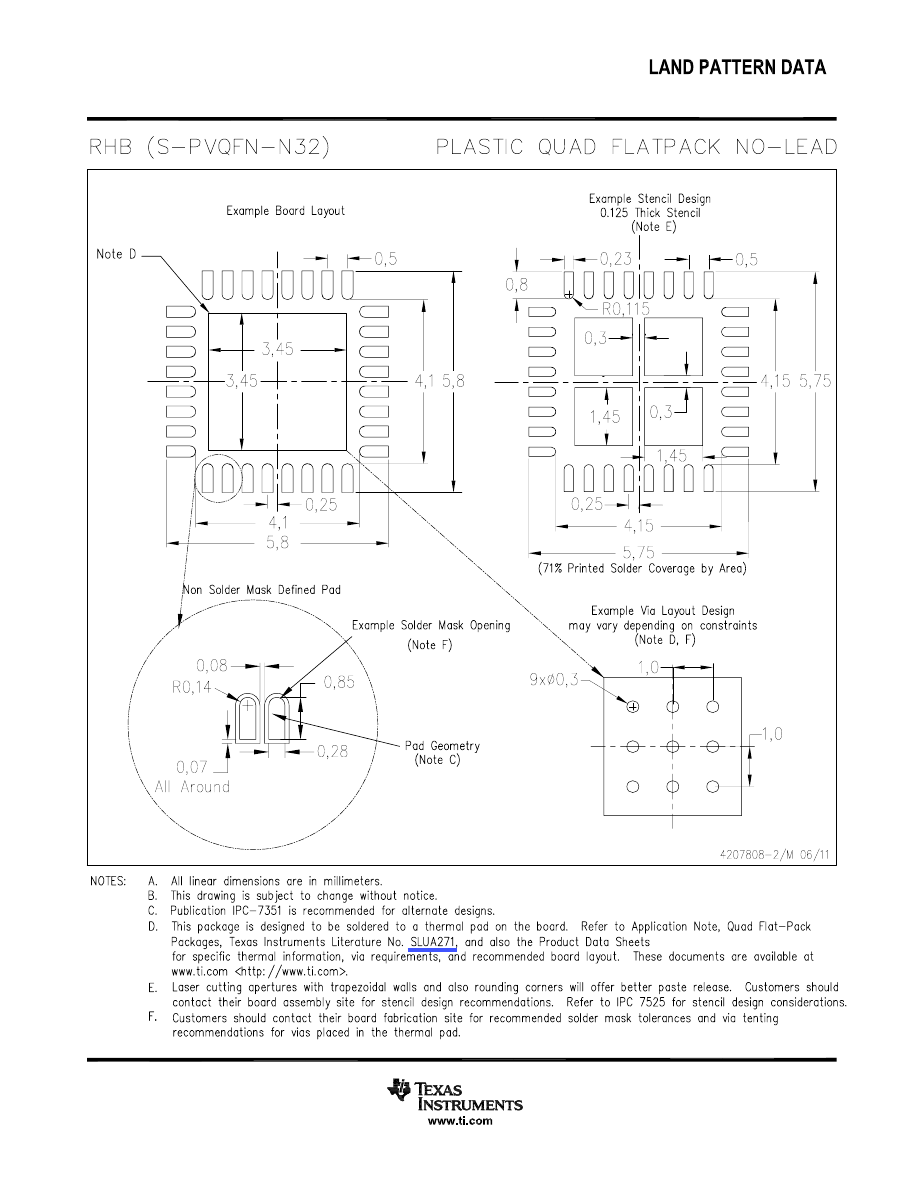

IMPORTANT NOTICE
Texas Instruments Incorporated and its subsidiaries (TI) reserve the right to make corrections, modifications, enhancements, improvements,
and other changes to its products and services at any time and to discontinue any product or service without notice. Customers should
obtain the latest relevant information before placing orders and should verify that such information is current and complete. All products are
sold subject to TI
’
s terms and conditions of sale supplied at the time of order acknowledgment.
TI warrants performance of its hardware products to the specifications applicable at the time of sale in accordance with TI
’
s standard
warranty. Testing and other quality control techniques are used to the extent TI deems necessary to support this warranty. Except where
mandated by government requirements, testing of all parameters of each product is not necessarily performed.
TI assumes no liability for applications assistance or customer product design. Customers are responsible for their products and
applications using TI components. To minimize the risks associated with customer products and applications, customers should provide
adequate design and operating safeguards.
TI does not warrant or represent that any license, either express or implied, is granted under any TI patent right, copyright, mask work right,
or other TI intellectual property right relating to any combination, machine, or process in which TI products or services are used. Information
published by TI regarding third-party products or services does not constitute a license from TI to use such products or services or a
warranty or endorsement thereof. Use of such information may require a license from a third party under the patents or other intellectual
property of the third party, or a license from TI under the patents or other intellectual property of TI.
Reproduction of TI information in TI data books or data sheets is permissible only if reproduction is without alteration and is accompanied
by all associated warranties, conditions, limitations, and notices. Reproduction of this information with alteration is an unfair and deceptive
business practice. TI is not responsible or liable for such altered documentation. Information of third parties may be subject to additional
restrictions.
Resale of TI products or services with statements different from or beyond the parameters stated by TI for that product or service voids all
express and any implied warranties for the associated TI product or service and is an unfair and deceptive business practice. TI is not
responsible or liable for any such statements.
TI products are not authorized for use in safety-critical applications (such as life support) where a failure of the TI product would reasonably
be expected to cause severe personal injury or death, unless officers of the parties have executed an agreement specifically governing
such use. Buyers represent that they have all necessary expertise in the safety and regulatory ramifications of their applications, and
acknowledge and agree that they are solely responsible for all legal, regulatory and safety-related requirements concerning their products
and any use of TI products in such safety-critical applications, notwithstanding any applications-related information or support that may be
provided by TI. Further, Buyers must fully indemnify TI and its representatives against any damages arising out of the use of TI products in
such safety-critical applications.
TI products are neither designed nor intended for use in military/aerospace applications or environments unless the TI products are
specifically designated by TI as military-grade or
"
enhanced plastic.
"
Only products designated by TI as military-grade meet military
specifications. Buyers acknowledge and agree that any such use of TI products which TI has not designated as military-grade is solely at
the Buyer
'
s risk, and that they are solely responsible for compliance with all legal and regulatory requirements in connection with such use.
TI products are neither designed nor intended for use in automotive applications or environments unless the specific TI products are
designated by TI as compliant with ISO/TS 16949 requirements. Buyers acknowledge and agree that, if they use any non-designated
products in automotive applications, TI will not be responsible for any failure to meet such requirements.
Following are URLs where you can obtain information on other Texas Instruments products and application solutions:
Products
Applications
Audio
Automotive and Transportation
Amplifiers
Communications and Telecom
Data Converters
Computers and Peripherals
DLP
®
Products
Consumer Electronics
DSP
Energy and Lighting
Clocks and Timers
Industrial
Interface
Medical
Logic
Security
Power Mgmt
Space, Avionics and Defense
www.ti.com/space-avionics-defense
Microcontrollers
Video and Imaging
RFID
OMAP Mobile Processors
Wireless Connectivity
www.ti.com/wirelessconnectivity
TI E2E Community Home Page
Mailing Address: Texas Instruments, Post Office Box 655303, Dallas, Texas 75265
Copyright
©
2012, Texas Instruments Incorporated
Document Outline
- Features
- Description
- Short-Form Description
- Absolute Maximum Ratings
- Recommended Operating Conditions
- Electrical Characteristics
- Active Mode Supply Current Into VCC Excluding External Current
- Typical Characteristics, Active Mode Supply Current (Into VCC)
- Low-Power Mode Supply Currents (Into VCC) Excluding External Current
- Typical Characteristics, Low-Power Mode Supply Currents
- Schmitt-Trigger Inputs, Ports Px
- Leakage Current, Ports Px
- Outputs, Ports Px
- Output Frequency, Ports Px
- Typical Characteristics, Outputs
- Pin-Oscillator Frequency – Ports Px
- Typical Characteristics, Pin-Oscillator Frequency
- POR/Brownout Reset (BOR)
- Typical Characteristics, POR/Brownout Reset (BOR)
- DCO Frequency
- Calibrated DCO Frequencies, Tolerance
- Wake-Up From Lower-Power Modes (LPM3/4)
- Typical Characteristics, DCO Clock Wake-Up Time From LPM3/4
- Crystal Oscillator, XT1, Low-Frequency Mode
- Internal Very-Low-Power Low-Frequency Oscillator (VLO)
- Timer_A
- USCI (UART Mode)
- USCI (SPI Master Mode)
- USCI (SPI Slave Mode)
- USCI (I2C Mode)
- Comparator_A+
- Typical Characteristics – Comparator_A+
- 10-Bit ADC, Power Supply and Input Range Conditions (MSP430G2x53 Only)
- 10-Bit ADC, Built-In Voltage Reference (MSP430G2x53 Only)
- 10-Bit ADC, External Reference (MSP430G2x53 Only)
- 10-Bit ADC, Timing Parameters (MSP430G2x53 Only)
- 10-Bit ADC, Linearity Parameters (MSP430G2x53 Only)
- 10-Bit ADC, Temperature Sensor and Built-In VMID (MSP430G2x53 Only)
- Flash Memory
- RAM
- JTAG and Spy-Bi-Wire Interface
- JTAG Fuse
- Port Schematics
- Port P1 Pin Schematic: P1.0 to P1.2, Input/Output With Schmitt Trigger
- Port P1 Pin Schematic: P1.3, Input/Output With Schmitt Trigger
- Port P1 Pin Schematic: P1.4, Input/Output With Schmitt Trigger
- Port P1 Pin Schematic: P1.5 to P1.7, Input/Output With Schmitt Trigger
- Port P2 Pin Schematic: P2.0 to P2.5, Input/Output With Schmitt Trigger
- Port P2 Pin Schematic: P2.6, Input/Output With Schmitt Trigger
- Port P2 Pin Schematic: P2.7, Input/Output With Schmitt Trigger
- Port P3 Pin Schematic: P3.0 to P3.7, Input/Output With Schmitt Trigger (RHB Package Only)
- Revision History
Wyszukiwarka
Podobne podstrony:
3 LCD LCD MSP430 id 755238 Nieznany (2)
msp430f1122
MSP430 2005www
MSP430 wprzykładach cz2
msp430f123
MSP430X
MSP430 wprzykładach cz3
msp430f149 (2)
msp430fg4618
msp430 opis p ytki
MSP430 wprzykładach cz1
msp430f133
MSP430 wprzykładach cz8
msp430f110
msp430f1101a
msp430f149
MSP430 wprzykładach cz6
więcej podobnych podstron